SCALING GLP-1 DRUGS WITHOUT A MOUNTAIN OF WASTE
PHARMA INDUSTRY SUSTAINABILITY TARGETS, ONE YEAR ON

SCALING GLP-1 DRUGS WITHOUT A MOUNTAIN OF WASTE
PHARMA INDUSTRY SUSTAINABILITY TARGETS, ONE YEAR ON
NAVIGATING THE TRANSITION TO SUSTAINABLE MEDICAL PROPELLANTS

OUTSTANDING ISSUE SPONSOR






www.dca-design.com

Hit your sustainability goals faster with the Companion® Safety Syringe System. Use less plastic with a noticeably lighter design and compact footprint compared to the status quo. This innovative approach leads to extensive savings and less waste from manufacturing to disposal.
The Companion prioritizes sustainability while providing solutions for today’s injection challenges. And rather than driving cost up, Companion’s sustainability advantages actually reduce cost of ownership.
To learn more about our Flex Clinical Line and its sustainability commitment call or email.



Credence MedSystems, Inc. +1-844-263-3797 info@CredenceMed.com www.CredenceMed.com
This product has not yet been evaluated by FDA
ONdrugDelivery Issue No 159, May 13th, 2024
This edition is one in the ONdrugDelivery series of publications. Each issue focuses on a specific topic within the field of drug delivery, and is supported by industry leaders in that field.
EDITORIAL CALENDAR 2024/25
May 2024 Injectable Drug Delivery: Formulations & Devices
May/Jun Oral Drug Delivery
Jun Connecting Drug Delivery
Jun/Jul Industrialising Drug Delivery
Sep Wearable Injectors
Sep/Oct Drug Delivery & Environmental Sustainability
Oct Prefilled Syringes & Injection Devices
Nov Pulmonary & Nasal Drug Delivery
Dec Connecting Drug Delivery
Jan 2025 Prefilled Syringes & Injection Devices
Feb Skin Drug Delivery: Dermal, Transdermal & Microneedles
Mar Ophthalmic Drug Delivery
Apr Pulmonary & Nasal Drug Delivery
Apr/May Drug Delivery & Environmental Sustainability
EDITORIAL:
Guy Furness, Proprietor & Publisher
E: guy.furness@ondrugdelivery.com
CREATIVE DESIGN:
Simon Smith, Creative Director (Freelance) E: simon.smith@ondrugdelivery.com
SUBSCRIPTIONS:
Audrey Furness (subscriptions@ondrugdelivery.com)
Print + Digital subscription: £99/year + postage
Digital Only subscription: free.
ADVERTISING:
Guy Furness (guy.furness@ondrugdelivery.com)
ONdrugDelivery is published by Frederick Furness Publishing Ltd
The Candlemakers, West Street, Lewes East Sussex, BN7 2NZ, United Kingdom
T: +44 1273 47 28 28
Registered in England: Company No 8348388
ISSN 2049-145X print / ISSN 2049-1468 pdf
Copyright © 2024 Frederick Furness Publishing Ltd

ONdrugDelivery Magazine is printed sustainably by Newman Thomson Ltd, West Sussex, UK, using Forest Stewardship Council® certified recycled paper, vegetable-based inks, biodegradable laminates and carbon balanced materials offset via the World Land Trust™ following ISO140001 processes. ONdrugDelivery in print is sustainably shipped to events by DHL using GoGreen Plus whereby carbon insetting of at least 30% is achieved through the use of Sustainable Aviation Fuel (SAF), a biofuel substitute for traditional jet fuel, produced from renewable sources such as vegetable oils, animal fats, waste products, and agricultural crops. The magazine is mailed to individual readers outside the UK by DHL using GoGreen, which offsets 100% of CO2 emissions.
The ONdrugDelivery logo is a registered trademark of Frederick Furness Publishing Ltd.
The views and opinions expressed in this issue are those of the authors. Due care has been used in producing this publication, but the publisher makes no claim that it is free from error. Nor does the publisher accept liability for the consequences of any decision or action taken (or not taken) as a result of any information contained in this publication.
Interview: the Benefits of Being an Early Adopter of Sustainability Principles Reto Jost, Category Lead For Large Volume Injectors; and Gabriel Kalbermatter, Innovation Engineer
Ypsomed
Scaling GLP-1 Drugs Without a Mountain of Waste
Matt Parker, Senior Consultant; Simon Lyons, Senior Consultant; and Alex Lyness, Business Development Director
TTP
Leveraging AI and Big Data for Eco-Design Collaboration in Pharma
Alissa Monk, Fairstainability Co-Circle Lead; Cédric Montagne, Sustainability Strategy, Reporting and Engagement; and Carole Schanté, Fairstainability Co-Circle Lead
ten23 health
Kami Krista, Chief Executive Officer and Co-Founder
Elio
Reusable Versus Single-Use Devices: Trade-offs in Improving Sustainability
Alastair Willoughby, Head of Mechanical Engineering; and Prem-Sagar Tank, Consultant Mechanical Engineer
Team Consulting
Pharmaceutical Industry Sustainability Targets, One Year On Catriona Eldridge, Materials Scientist
Springboard
Change is in the Air: the Future Climate of Inhaled Medication
Pauline Janssen, Product Application Specialist
DFE Pharma
Optimising low-GWP pMDI Sprays for Enhanced Performance and Sustainability
Benjamin Myatt, Senior Product Development Engineer
Kindeva Drug Delivery
Daniel Duke, Senior Lecturer, Mechanical & Aerospace Engineering
Monash University
Navigating the Transition to Sustainable Medical Propellants
Timothy Noakes, Technical Associate; Sheryl Johnson, Pharma Growth & Technology Manager; and Richard Greenhough, Technical Sales & Business Development Manager
Koura, Orbia Fluor & Energy Materials
Sustainable by Design: Developing Patient- and Planet-Centric Medical Devices
Su Osorio, Associate Director of Design Strategy; Stephanie Mou, Pharma Commercial Lead; and Charlie Dean, Head of Sustainable Medical Technology
Cambridge Consultants
Towards a Comprehensive Sustainability Strategy
Marie-Christine Klein, Head of Development & Regulatory Affairs; and Christian Weyler, Project Manager Development & Regulatory Affairs
URSATEC
Interview – Sustainability Programmes: Every Step Counts
Henryk Badack, Senior Vice-President Technical Services and Internal Project Management
Vetter Pharma
Design for Sustainability – the Considerations Brought to Life
Oli Gould, Sustainability Solutions Lead
Owen Mumford
Interview
Dora Rio, Head of Sustainability
SHL Medical
PCI’s ESG Journey – Establishing Processes and Driving Results
Gigi Bat-Erdene, Global ESG Program Manager
PCI Pharma Services


Taking handheld self-injection beyond volumes of 2.0 mL
New ready-to-use 5.5 mL staked-needle pre-filled syringe format
Market-proven two-step YpsoMate technology
Bespoke user interface increases confidence during injection
Easy customisation for a broad range of fill volumes, viscosities and injection times




In this exclusive interview with ONdrugDelivery’s Guy Furness, Reto Jost and Gabriel Kalbermatter, both at Ypsomed, discuss the progress the company has made in advancing its sustainability agenda, particularly the implementation of Ypsomed’s ecodesign guideline, the benefits of being an early adopter of sustainability principles, how YpsoMate 5.5 mL has been designed from the ground up with sustainability in mind and where sustainability considerations currently fit into the wider pharma industry.

Reto Jost is Category Lead for Large Volume Injectors at Ypsomed Delivery Systems. He has been with Ypsomed since 2014 in various roles in product management and business development, working with pharmaceutical companies to develop innovative self-injection systems and bring them to market. Since 2018, his main focus has been on new product innovation, with a particular focus on large-volume injections. Reto holds an MSc in Mechanical Engineering from ETH Zurich, Switzerland, and a CAS in Business Administration from HES-SO (Fribourg, Switzerland). He has broad experience in medical devices, having worked in the industry since 2006.

Gabriel Kalbermatter works as an Innovation Engineer at Ypsomed Delivery Systems. He joined Ypsomed in 2016, working in the field of front-end innovation. His focus is on developing concepts from the initial product idea to proof of concept, mainly for autoinjectors, injection pens and smart devices. He holds a BSc in Systems Engineering from HES-SO (Sion, Switzerland) and started his career in the medical technology industry in 2007.
QYpsomed was an early adopter of sustainability principles – one of the first in the devices sector. In your opinion, what are the advantages that recognising the importance of sustainability early brings and can you describe some of the key learnings you’ve made along Ypsomed’s sustainability journey?
AIn 2016, Ypsomed committed to a consistent improvement in energy efficiency and introduced reforesting and regeneration programmes. As a company which thinks long-term, sustainable action has always been one of our basic principles.
Since the integration of sustainability in our corporate strategy in 2020, we consider sustainability holistically within all business activities and business units. Sustainability initiatives take time to bear fruit, so starting early has given us additional time to prepare and see how our programmes are progressing.
The key benefits from our perspective have been learning where the most potential to improve the sustainability profile of our products is – what we have to work on, where we can do better. Ypsomed initiated its NetZero Program in 2020 (Box 1), starting with projects
“While we work to
maximise
our own carbon reductions, it’s just as important for the whole supply chain – the partners around us – to be moving in the same direction.”
to minimise the carbon footprint of our existing products. From there, we also started to implement sustainability practices
Ypsomed is committed to acting responsibly towards its employees, partners and society, and so is striving for a circular economy and to reduce its carbon footprint. Since 2022, Ypsomed has been working intensively on a company-wide CO2 reduction programme, primarily focusing on reducing greenhouse gas emissions, that aims to achieve a set of ambitious goals outlined in its NetZero Program:
• Timeline: Ypsomed has set an ambitious timeline for achieving net-zero targets. The targets were successfully validated by the SBTi at the end of 2023:
– By 2030: Net-zero operational CO2 emissions (Scope 1 & 2)
– By 2030: A selection of products meet net zero GHG emissions across their individual value chain (Scope 1-3)
– By 2040: Net-zero CO2 emissions across Ypsomed’s entire value chain (Scope 1-3).
• NetZero Sites: Ypsomed is aiming to reduce CO2 emissions at its sites by at least 90% by 2030. To achieve this, Ypsomed is:
– Using waste heat from production to reduce gas consumption
– Using the latest generation of energy-efficient machines for injection moulding
– Using 100% renewable electricity
– Employing innovative building technology for optimised heating, cooling and ventilation.
• NetZero Governance: Ypsomed’s executive board and board of directors fully supports the NetZero Program, regularly reporting internally and externally on CO2 emissions. Additionally, the company has its annual carbon footprint audited by an independent external organisation.
• NetZero Supply Chain: Ypsomed holds its suppliers accountable for their CO2 emissions and empowers them for the joint journey to net zero. The expectations for Ypsomed’s suppliers
are defined in the company’s code of conduct, and Ypsomed is in continuous dialogue with suppliers so that they can achieve net-zero targets together.
• NetZero Network: Ypsomed maintains strong partnerships to make a global commitment to the climate:
– The Alliance to Zero was founded in 2021 by Ypsomed and seven other companies along the pharmaceutical value chain
– The Ypsomed Sustainability Academy facilitates internal and external networking designed for training and awareness raising on the topic of sustainability
– Ypsomed supports a selection of high-quality global climate protection projects, including forest conservation measures in Brazil and Kenya and a reforestation project in Tanzania.
• NetZero Products: Production materials cause the largest portion of Ypsomed’s CO2 footprint. The company analyses the carbon footprint of its products over their entire lifecycle and optimises them in accordance with its ecodesign guidelines. By replacing conventional plastics with bio-based yet chemically identical plastics, optimising the product and reducing packaging, Ypsomed is aiming to reduce emissions by 20%–50%. The international ISCC+ certificate confirms the traceability of Ypsomed’s sustainable plastic materials along the entire supply chain.
Ypsomed’s ecodesign guideline comprises seven key sections, which provide definitions and guidance on how to apply sustainability principles to different aspects of product development at Ypsomed:
Ypsomed’s sustainability goals
Objective and application
Concept check
Material selection
Alliance to Zero is a non-profit membership association for pharma and biotech supply chain companies that aims to facilitate the transition of the pharma sector to compliance with net-zero emissions. As a working group with commonly shared goals, it engages in collaboration with academia and non-profit organisations as well as sponsors’ projects. The Alliance to Zero involves, connects and co-ordinates suppliers, pharmaceutical companies, manufacturers and service providers along the supply chain of pharma products. In addition to Ypsomed, its founding members include Schott, Datwyler, Harro Höfliger, Schreiner MediPharm, Körber Pharma, Sharp Services and Health Beacon.
in our new developments. Building on this, in 2021 we implemented our ecodesign guideline (Box 2).
It has taken time working with suppliers to ensure that they contribute to reducing the carbon footprint of our products.
Lifecycle assessment
Packaging
Disposal and recycling.
A really key learning was when we realised that, while we work to maximise our own carbon reductions, it’s just as important for the whole supply chain – the partners around us – to be moving in the same direction. That was one reason why we became a founding member of the Alliance to Zero in 2021 (Box 3). Additionally, with a highly regulated industry like pharma, you inevitably have resistance to change. This is especially true where you have established products,
“A major part of ecodesign is building in circular economy thinking –closing the circle to recycle products and materials and to develop new business models that are even more sustainable.”
where any change is associated with a lot of work in terms of testing, documentation and re-registration. Then you have all the regulations in terms of chemical components and composition to consider when sourcing materials, which means that you don’t have the same freedom to replace some of the materials with lower carbon footprint alternatives that you would have in a less regulated industry.
QIn Ypsomed’s view, is sustainability purely about CO2 or are there other factors you consider? Also, can you explain the principle of ecodesign in more detail?
AIn terms of corporate sustainability, the meaning is very comprehensive. It includes society, it includes our
employees – it isn’t limited to only reducing the environmental impact. It’s about a holistic, sustainable journey that we want to take moving forward. On the product side, however, it is mainly about CO2 in the plastic materials used because that’s the primary way we have to reduce our environmental impact. Our processes are energy intensive, but we have a range of measures to generate green electricity and recycle energy within our manufacturing plants.
We have set goals to meet net-zero operational CO2 emissions (Scope 1 and 2) in our operations by 2030 and over the whole value chain by 2040. We are committed to a science-based reduction pathway in accordance with the Science Based Target Initiative (SBTi). Our targets were successfully validated by the SBTi at the end of 2023 and it is important to mention that these goals are for all greenhouse gases combined, measured as a CO2 equivalent.
phase of a project they’re in. The ecodesign guideline is embedded throughout product development – it’s not optional, it’s an integral part of the process.
QHow long have Ypsomed products been developed according to your ecodesign guideline?
AWe developed the first draft of the ecodesign guideline in 2021. It has been updated since then, of course, but that’s where we started using it in the development process. Before that, we had lots of ideas, lots of inputs, but nothing written down. Now, it’s concrete – it’s a specific document, with our own experience combined with some more broadly established tools, such as the circular economy and “rethink, refuse, reuse, reduce, repair, recycle” (Figure 1).
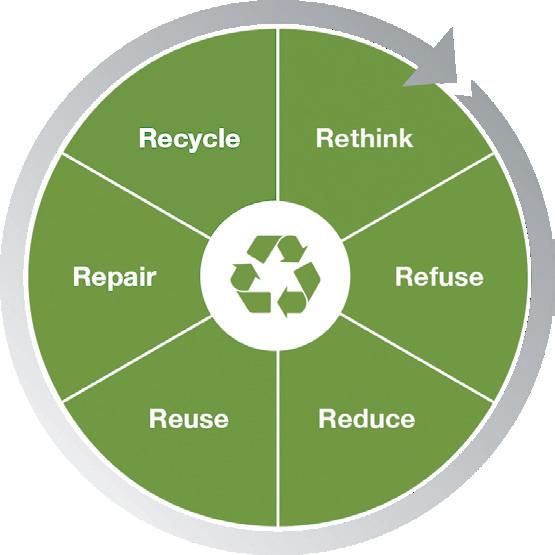
As to ecodesign, the idea is to design our new products in a way that is as eco-friendly as possible. To achieve this, we carried out lifecycle assessments (LCAs) where we calculate the CO2 footprint to enable comparison between concepts or products and give us some hard numbers to work with. It’s a complex problem, but we try to make it more tangible by comparing CO2 equivalents. Also, a major part of ecodesign is building in circular economy thinking – closing the circle to recycle products and materials and to develop new business models that are even more sustainable. Ecodesign is a guideline that informs how everything is analysed based on standard methods and contains tools and concepts that can help us develop better products. The intent is to increase awareness within the company, to make sure that each and every development team implements ecodesign principles. Under our ecodesign guideline, we assess risks, costs and sustainability throughout development. All our teams need to be able to present where they stand in terms of sustainability, whatever
For a device engineer at Ypsomed, as an example, the ecodesign guideline is a part of their daily workflow. Then, for every milestone or design review, there’s a checklist – the ecodesign index – where we have an extensive set of sustainability factors, and we make sure they’ve all been considered during development. However, no one is expected to undertake this alone; everyone is able to keep in close contact with the experts and with colleagues from all our other projects. We can always ask for advice and hold workshops or meetings with someone who can help. On top of that, we have the Sustainability Academy at Ypsomed, where employees receive regular training.
Finally, under the ecodesign guideline, a critical part of every development process is an LCA that includes a calculation of the product lifecycle’s expected CO2 emissions according to the standards. We have a dedicated team for this, so it’s always the same group performing these calculations. This ensures that not only are all the calculations done according to the standards, but also that there is comparability between products. This consistency is important.
QI’d like to go into more detail regarding Ypsomed’s ecodesign LCAs – what are the key inputs and what have you learned from conducting them?
AWhat we’re doing is calculating cradle-to-gate emissions, from the raw material to when the products leave Ypsomed. This includes all the materials and our own manufacturing but excludes
“We’ve seen that the biggest potential for reducing our CO2 emissions is in materials – mainly plastics.”
some of the carbon-intensive aspects of the combination product – production of the API, for example. These factors can vary a lot depending on the product, such as whether it requires cold-chain storage or not, or the markets that the product is going to. So, we mainly focus on the activities that Ypsomed is directly involved with, those that we can influence directly.
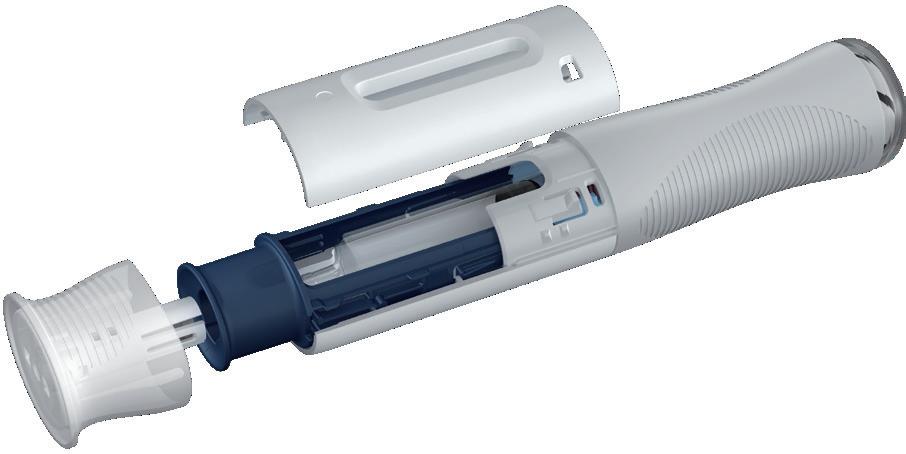
From this, we’ve seen that the biggest potential for reducing our CO2 emissions is in materials – mainly plastics. After that, the next biggest area for improvement is packaging and production. Then, the last significant one is transport. Based on this, our first step has been to focus on those key areas. Plastics are a particular area we’re focusing on; some of them have significantly greater carbon footprints than others, so we are able to make major reductions to our CO2 emissions.
QAs a specific example of Ypsomed’s ecodesign guideline in action, can you tell us about the development of the Ypsomate 5.5 mL autoinjector from a sustainability perspective?
AWe started development of Ypsomate 5.5 mL (Figure 2) in 2021, with the aim of designing an autoinjector for larger volumes. A capacity of up to 5.5 mL is very large for an autoinjector, but we were seeing more and more requests for larger volumes, so we felt that it was important to have a platform that could handle them. For example, if you look at oncology and the treatment of rare diseases, there is an increasing need for higher payloads.
We saw a similar trend when we introduced 2.25 mL autoinjectors in 2016, which have been very successful, and we also have several years’ experience working with the YpsoDose 10 mL patch injector. So, based on that context, we concluded that there was a clear space for a larger volume autoinjector in the market. That was the starting point.
As a positive coincidence, the ecodesign guideline was established around the same time, so we were able to factor in sustainability when designing YpsoMate 5.5 mL from the very beginning in a way we couldn’t with previous products, where we had to bring it in later in the development process. We made sustainable choices from the very first concepts, where we had to choose which mechanism we wanted to use, how complex it should be and what features we wanted to include in the device. We were able to estimate the CO2 emissions for each concept and compare them.
The next important step from a sustainability standpoint was the evaluation of what materials to use. There, we made an estimate for an LCA of all the individual parts. In particular, we looked at the larger parts – those with a higher volume or mass. We focused on selecting materials with the best sustainability profiles. And, after the first set of prototypes and injection-moulded parts, we were able to perform some further optimisations where we reduced the number of parts and their volume.
Another important consideration was the packaging. We sought to design the device in a way that it would take up the smallest possible volume during transport, with the packaging as dense as possible. We ship all our YpsoMate autoinjectors as one subassembly in a single-tray configuration with the syringe holder and power pack “pre-snapped” together. This saves an enormous amount of space and tray material for transportation, which noticeably reduces the carbon footprint associated with transport per device. Along with that, we used
more sustainable packaging materials where possible, such as using recycled polyethylene terephthalate (PET) instead of virgin PET. The tray material makes up a significant proportion of the overall plastic CO2 footprint of the autoinjector. Throughout development, the ecodesign index really helped to guide us. Whenever we reached a key milestone or had a design meeting, we were able to go through the whole device, sometimes part by part, and ask ourselves how well we’d adhered to each aspect of the guideline. This approach helped us make sure that we were keeping sustainability in mind during the design process.
QHow does Ypsomed balance its obligations regarding sustainability with its equally important obligations to maintain impeccable quality and to control costs?
AClearly, every device has to meet regulations; we need to pass the requirements of ISO 11608 and the regulatory agencies of the target market. In practice, there’s little to compromise on. Obviously, safety and quality standards must never be compromised.
But the reality is that pursuing sustainability is often the opposite of a compromise. Improving sustainability often improves the product overall. For example, cost – while one might expect sustainability and cost to be in conflict, they typically are not. A large part of sustainability is about reducing waste and reducing material use, which also keeps down costs. In practice, sometimes a more sustainable design is more cost efficient because you’re trying to reduce the number
of parts and the amount of material used in the device. Usability also affects sustainability, as a lost dose because of a user error is also a loss in terms of CO2
Usability, cost and quality – these perspectives need to be considered, even if some of them are difficult to quantify. In addition, with products with access to easy and high-quality self-medication, we are making a significant contribution to the goal of good health and wellbeing of the UN Sustainable Development Goals (SDG).
QDo you think anything further can be done to improve the sustainability of older devices, or should the focus on sustainability be kept to future products?
AWe’ve done a lot of work on optimising Ypsomed’s existing portfolio – it can be done. And doing so is important because drug products have a long lifetime on the market. So, it makes sense to optimise existing products. However, there is probably greater potential for making a device sustainable with new developments.
We still see a lot of potential where we could do better or where we could improve. There’s a lot going on at Ypsomed on this front, especially for endof-life considerations, such as recycling or refurbishing. And it’s throughout the whole value chain where improvements can be made, not only in product design but also within manufacturing and the supply chain.
In particular, we believe that the industry still needs to adopt more and further develop take-back and recycling solutions. There need to be take-back systems that cover all medical devices containing
“In particular, we believe that the industry still needs to adopt more and further develop take-back and recycling solutions.”
recyclable materials. If the pharma industry does not implement such systems on its own or in collaboration, then regulations will be introduced by national and international authorities.
Another thing to consider on this front is biopolymers; one of the primary ways we have for making existing products more sustainable is to replace their materials with equivalents from renewable sources. As long as the renewable materials are chemically identical to the current material, a switch is relatively simple. The number of product platforms available in the Ypsomed NetZero Program is increasing, maintaining biocompatibility, functionality and safety, with no additional testing required. However, if a polymer is changed, the process is more complex. We’ve now implemented processes to source renewable materials and to feed them into our manufacturing processes.
QLastly, what do Ypsomed’s ecodesign guideline and your sustainability initiatives mean for your pharma partners and customers? Do you have any feedback from them, and can you give a sense of the general feeling from pharma about Ypsomed’s efforts?
AFor large pharma companies, sustainability is very important and included in the device selection process. When we enter detailed discussions, we have to be able to explain our processes and objectives clearly. Overall, we are making good progress, which has been well received across the industry. Ypsomed is keen to stay ahead of the game and keep pushing on down the path to net zero that we’ve set out for ourselves.
With 40 years of experience, Ypsomed is a global pioneer for the development and manufacturing of innovative, simpleto-use, reliable self-injection devices and digital health solutions for pharmaceutical and biotech companies, which contribute significantly to the success of therapies –making selfcare simpler and easier.
Ypsomed supplies customisable product platforms for autoinjectors for prefilled syringes in 1 mL and 2.25 mL format, disposable pens for 3 mL and 1.5 mL cartridges and reusable pens that include automated injection mechanisms.
Ypsomed Delivery Systems’ platforms include; prefilled autoinjectors (YpsoMate 1.0 mL, 2.25 mL and 5.5 mL); reusable pens (ServoPen and YpsoPen); prefilled pens (UnoPen and FixPen); a patch injector (YpsoDose 10 mL); and a connected add-on (SmartPilot for YpsoMate).
The injection systems are developed and manufactured in Switzerland with strong in-house competencies covering concept and product development, toolmaking, injection moulding and automated assembly. Ypsomed is ISO 13485 certified, and all processes are run according to design control and cGMP guidelines with operational quality assurance and control experts on-site at each location.
Ypsomed’s US FDA-registered manufacturing facilities are regularly inspected by both pharma customers and regulatory agencies. Devices are supplied to global markets including the US, Europe, Japan, China and India. Current manufacturing facilities are located in Switzerland and Germany with new facilities being built and assessed in China and the US, respectively.
Reto Jost
Category Lead for Large Volume Injectors
E: reto.jost@ypsomed.com
Gabriel Kalbermatter
Innovation Engineer
E: gabriel.kalbermatter@ypsomed.com
Ypsomed AG
Brunnmattstrasse 6
CH-3401 Burgdorf Switzerland
www.ypsomed.com/yds
BRINGING YOU...

The NetZero Program provides significant CO2 reductions for each self-injection device
ISCC+ certified bio-based plastics based on the mass balance approach
Biocompatibility, functionality and safety are maintained so that no additional testing is required
Device transport trays are produced exclusively from recycled materials
All new platform products are based on ecodesign principles


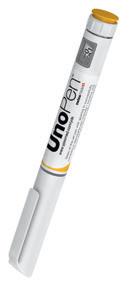
In this article, Matt Parker, Senior Consultant, Simon Lyons, Senior Consultant, and Alex Lyness, PhD, Business Development Director, all at TTP, look at how the continued success of glucagon-like peptide-1 drugs is bringing into focus the need for environmentally sustainable self-injection systems. They discuss whether reloadable autoinjectors could be the way to boost sustainability, lower cost per dose, and match the scale and rate of adoption of these new therapies.
This year, glucagon-like peptide-1 (GLP-1) analogues are set to overtake programmed cell death protein 1 (PD-1) inhibitors as the best-selling class of drugs. By 2030, hundreds of millions of patients worldwide may rely on GLP-1 drugs to manage their health, some for a period of years, others perhaps indefinitely.
The initially unforeseen clinical success of GLP-1 drugs and their rate of adoption has already led to a number of challenges for the industry, from the ability to manufacture the drug to bottlenecks due to fill-finish capacity to payers tackling reimbursement. Assuming these are resolved in the coming years, there are still significant questions about how we can address the environmental sustainability challenges created by this new market and the vast patient population.
In the short term, scaling the production of proven, existing single-use autoinjector and insulin-style or cartridge-based injector pen technologies is likely the best option to meet the rate of demand. Cartridge-based injector pens offer one route to reduce the environmental impact as, compared with single-use devices, they typically deliver up to four doses with only the needle hub discarded after each dose. But these advantages are offset by the usability challenges compared with singleuse autoinjectors, including dose setting, an exposed needle and an increased number of steps to dispose of and replace it.
Longer term, can traditional pens designed to deliver insulin work for the needs of a patient on GLP-1? Is it acceptable to follow the same single-use disposable path for such a large market that is set to grow each year to 2030? Will this approach be acceptable to patients when more convenient and sustainable solutions could be available?1
For some years now, the industry has been weighing up the potential of a reusable, durable autoinjector. This would take the
“The
requirements of GLP-1 drugs are also different from those for which existing
reusable autoinjectors were developed.”
form of a handheld device that reuses the power system each time but delivers the drug from a single-use disposable as a route to lower the environmental impact per dose. This disposable would contain a prefilled syringe (PFS) that is in drug and patient contact. While there has been some progress in this realm, the requirements of GLP-1 drugs are also different from those for which existing reusable autoinjectors were developed.
This article explores this premise further and proposes that simple mechanically driven reloadable autoinjectors may balance environmental sustainability and economic opportunities to create the best of both worlds.
The metabolic diseases of diabetes and now, increasingly, weight management – collectively known as diabesity – are currently driving unprecedented demand for GLP-1 drugs. According to one estimate, the number of patients to be treated in the US is on track to reach 30 million by 2030.2 While some of the demand will be met with orally delivered treatments,3 the increase in the US alone could equate to one billion injections per year (Figure 1).
Although welcomed by patients, the rapid growth of GLP-1 drugs over the next decade is bringing into focus the need for environmentally sustainable solutions for self-injection. An additional

Matt Parker
Senior Consultant
T: +44 1763 262626
E: matthew.parker@ttp.com

Simon Lyons
Senior Consultant
T: +44 1763 262626
E: simon.lyons@ttp.com

Dr Alex Lyness
Business Development Director
T: +44 1763 262626
E: alex.lyness@ttp.com
TTP plc
TTP Campus Cambridge Road Melbourn
SG8 6HQ
United Kingdom www.ttp.com

“An additional one billion typical single-use autoinjectors discarded after use could equate to 35,000 tonnes or 50,000 cubic metres of waste –and enough devices to circle the globe 3.5 times.”
one billion typical single-use autoinjectors discarded after use could equate to 35,000 tonnes or 50,000 cubic metres of waste – and enough devices to circle the globe 3.5 times (Figure 2).
These staggering numbers clearly show that environmental sustainability should be considered from the outset of future drug product launches in this category. To justify the investment into a new drug delivery platform often requires an order of magnitude improvement over incumbent devices, and there are only limited ways this can be achieved with the design of current products and processes.
An obvious method to enhance sustainability would be through minimising the amount of material used during manufacture. While some opportunities may exist here, many legacy products have been optimised for part count, material usage, manufacturing method and assembly, so the benefits from this approach alone are limited. An alternative would
be to develop an autoinjector made with more sustainable materials from the outset, such as the Eco-inject® platform. The number of bio-based and biodegradable
polymers is increasing steadily, making it possible to meet mechanical performance requirements. However, these new materials still command a premium over conventional medical grades, which will impact cost per dose until they are available and adopted at scale.
Full circularity is a more radical approach focused on maximising the takeback and recycling of a device through material choices and design for disassembly at end of life. The infrastructure, logistics and regulation are taking shape, albeit

delivery solutions to meet this challenge.
at different rates in different territories, and takeback schemes are being trialled in various industries. HealthBeacon (Dublin, Ireland) is one of the leaders in this field and tackling the complexities required for collecting devices with sharps that have been in contact with both the drug and the patient. Circularity via recycling or takeback is being piloted but, as well as being physically possible, it must also be economically viable at scale if the benefits are to be relished.
One potential option to tackle this challenge is to develop an autoinjector intended to be reloaded and reused. Reusing the drive system and several components across multiple deliveries is a practical way to significantly lower the environmental impact per dose. The user is still required to load the device between uses but – unlike traditional cartridge-based pens – the needle would not be seen by a patient prior to an injection and shielded post-injection, features that reduce anxiety and increase safety during self-injection.
To date, existing reusable platforms in this area have typically been designed around powerful electromechanical drive systems to drive (often viscous) biological drugs. This results in costly battery-powered devices that have then sought to include additional functionality and connected features to justify the increased costs. In the context of GLP-1, rather than repurposing this approach, the needs of the new patient population and scale of the market should be taken into account when developing the correct delivery solution.
GLP-1s tend to have favourable properties for injection, such as low viscosity and relatively small dose volumes that can be delivered from a PFS via a spring-powered device. For a drug regime like that of many GLP-1s, where patients administer a dose weekly, it is easy to see how simple reloadable autoinjectors could offer a significant improvement in environmental sustainability performance over single-use devices.
To maximise the environmental benefit of this approach, many of the complex high-value components (actuator, needle safety, ergonomic handle, etc.) would be integrated into the reusable section of the device. The disposable section would appear as a simple cassette that would house the PFS and enable the user to easily reload the autoinjector.
A mechanical reloadable design brings clear environmental sustainability benefits but, conversely, creates unique design challenges. Some are technical, such as part durability, human error during user loading versus
“A mechanical reloadable design brings clear environmental sustainability benefits but, conversely, creates unique design challenges.”
preloaded, ensuring a lockout at end of life of the device, etc. Others are more nuanced and require significant design innovation to develop a device that meets the requirements for sustainability while, at the same time, satisfying the user and being compatible with existing manufacturing methods and fill-finish equipment.
When it comes to the primary containment, dedicated innovation is best avoided. Seeking a custom packaging solution introduces technical, logistical and commercial challenges to both the manufacturing and fill-finish operations. Instead, all efforts should be put into integrating an off-the-shelf PFS solution that will have been optimised, tested and already proven scalable into the reloadable autoinjector design.
To gain adoption in a mass market dominated by single-use devices, a reloadable autoinjector should offer a familiar format and design affordances, identical or similar user steps for injection and intuitive reloading steps. In practice, it should offer familiar haptic cues so that users can recall functional steps. As far as possible, these steps should follow current accepted practice; any new steps should draw on recognisable and familiar affordances associated with reloading or refreshing a device. Examples can be drawn from our everyday lives and the many different coffee machines and coffee pods we have become accustomed to using to prepare our daily dose of caffeine with minimal training.

* using Forest Stewardship Council® certified recycled paper, vegetable-based inks, biodegradable laminates and carbon balanced materials offset via the World Land Trust™ following ISO140001 processes.
** by DHL using GoGreen Plus carbon insetting of at least 30% through the use of Sustainable Aviation Fuel (SAF), a biofuel substitute for traditional jet fuel, produced from renewable sources. Mailed to individual readers outside the UK by DHL using GoGreen, which offsets 100% of CO2 emissions.
It may at first appear that a reloadable autoinjector will increase complexity for the user. Typically, additional steps are required to swap over a PFS in a reusable device. To reduce the number of steps, the functions required could be designed into a novel cassette design. Going a step further, an ideal solution would make reloading the autoinjector feel simpler and more worthwhile to the user than unpacking and throwing away a whole device after each use.
A device design with similar user steps and interaction cues to existing marketed devices would be preferred. There is precedent for US FDA-approved reusable autoinjectors intended for different therapeutic indications, for example: the SKYTROFA® autoinjector (Ascendis Pharma) containing the human growth hormone product lonapegsomatropin-tcgd; the Rebiject II® autoinjector (Merck KGaA), for use with the company’s Rebif® (interferon beta1a) prefilled syringe in multiple sclerosis; and the Enbrel AutoTouch® autoinjector (Amgen), for use with the Enbrel Mini® (etanercept) single-dose prefilled cartridges in various forms of arthritis, ankylosing spondylitis and plaque psoriasis. Care should be taken to not deviate significantly from familiar device interactions or introduce handling steps not supported by extensive usability studies.
“Simple reloadable and reusable autoinjectors are a pragmatic solution that balances environmental sustainability and economics in a way that favours adoption and scalability.”
Simple reloadable and reusable autoinjectors are also a pragmatic solution that balances environmental sustainability and economics in a way that favours adoption and scalability. Fundamentally, a smaller number of reloadable devices of comparable complexity to a single-use device will need to be manufactured and assembled to supply the same number of doses – or to keep up with the growing demand of the GLP-1 market.
In a field saturated by single-use devices, reloadable autoinjectors also give pharmaceutical companies an opportunity to offer product differentiation while aligning with the growing demand for sustainability from users and legislators.
In the short to medium term, simple reloadable autoinjectors are a credible option to align environmental sustainability with commercial drivers, in particular the need to scale. To realise this opportunity, the stakeholders need to collaborate to
Matt Parker is Senior Consultant – Drug Delivery and a project lead at TTP. With a background in mechanical engineering, he has led multidisciplinary teams developing next-generation devices across drug delivery, rapid diagnostics and biosensors. Mr Parker’s experience stretches from early concept development through taking devices from first prototypes to clinical trials.
Simon Lyons is Senior Consultant – Drug Delivery at TTP. He has used his background in product design engineering to lead multi-disciplinary projects centred around human factors, connected devices and drug delivery accessories. He has worked on multiple developments with a strong focus on sustainable design and on optimising for manufacture at scale.
Alex Lyness, PhD, is Business Development Director – Drug Delivery at TTP. He has recently joined TTP from West Pharmaceutical Services where he gained extensive experience in the research, development and commercialisation of novel drug delivery devices and containment systems. Dr Lyness is based in Philadelphia (US) and leads business development activities for TTP in North America. He obtained his PhD while working at a drug delivery start-up in Oxford (UK) and is a Chartered Engineer with the Institution of Mechanical Engineers.
resolve several interrelated design and manufacturing challenges. Many of these start with the needs of the end user, including anticipating the minimum device features expected, ensuring the injection experience does not deviate significantly and integrating the existing PFS solutions into the cassette design so it is intuitive and reliable to reload.
The size of the GLP-1 market means that there are vast revenues to be generated for a number of pharma companies, albeit with a high degree of competition and difficulty around differentiation. It would be hoped that the societal benefit of these new drugs is to be combined with similar innovations in delivery that lead to scalable, reusable autoinjector solutions that ensure that the millions of patients, and the environments they live in, have a healthy and more sustainable outlook to 2030 and beyond.
TTP is an internationally respected product and technology development firm based in Cambridge, UK. For over 35 years, clients across a spectrum of industries including health tech, life science, deep tech and clean tech have trusted its deep domain expertise and enabling culture to create valuable new technology and deliver groundbreaking solutions, from first principles, through product design and manufacture to commercialisation.
1. Zhou A, Trujillo J, “Comparison of Usability, Accuracy, Preference, and Satisfaction Among Three Once-Weekly GLP-1 Receptor Agonist Pen Devices”. Diabetes Spectr, 2018, Vol 31(4), pp 359–366.
2. “The increase in appetite for obesity drugs”. Research Analysis, J.P. Morgan, Nov 29, 2023.
3. Boye K et al, “Patients’ preferences for once‐daily oral versus once‐weekly injectable diabetes medications: The REVISE study”. Diabetes Obes Metab, 2021, Vol 23(2), pp 508–519.

Mapping the Future of Net Zero Packaging & Supply Chains
Ensuring Quality, Safety, Suitability & Regulatory Compliance for Drugs, Biologics and Med Devices
Philadelphia, PA
Philadelphia, PA
Conference Highlights Include:
Conference Highlights Include:
• How a Product Lifecycle Assessment Can Support Sustainability Objectives
• Designing and Improving Risk-Based Assessment of E&L Data for Drugs, Biologics, and Medical Devices
• Implementing ISO 10993-17 & ISO 10993-18 Standards
• Key Design Considerations for Sustainable Packaging/Devices
• AETs and Response Factor Variation for E/L Studies
• Creating Sustainable Cradle-to-Gate Lifecycle Processes
• Next Generation Biopolymers for Use in Packaging Materials
• And Much More
• David Seitz, Formerly Amgen PharmaED’s
• Uncertainty Factors Reconsidered: Toxicological & Chemistry Perspectives


Featured Speakers Include:
Featured Speakers Include:
• Tom Szaky, TerraCycle
• David Saylor, FDA (on approval)
• Dennis Jenke, Triad Scientific
• Chandana Kolluru, Boehringer Ingelheim
• Jakob Lange, Ypsomed AG
• Nicole Soucy, Boston Scientific
• Arne Kloke, Schott Pharma
• Ping Wang, Janssen R&D
• Dujuan Lu, SGS
Register online at: www.pharmaedresources.com
For further info, contact Kim: (217) 721-5774, or email us: khubbard@pharmaedresources.com

Pre-filled Syringes, Injectable Drug Devices & Parenteral Systems


In this article, Alissa Monk, Fairstainability Co-Circle Lead at ten23 health, Kami Krista, Chief Executive Officer and Co-Founder of Elio, Cédric Montagne, Sustainability Strategy, Reporting and Engagement, and Carole Schanté, PhD, Fairstainability Co-Lead, both of ten23 health, explore the potential of artificial intelligence and big data in eco-design with the aim of transforming the pharmaceutical industry towards greater sustainability.
Sustainability and digitalisation are currently two of the most significant drivers of change for companies globally, regardless of sector. Yet, until recently, the two had not converged to leverage the latest advances in technology to accelerate the transition to a more sustainable age. There is now ballooning pressure on companies to measure, set targets, publicly report and, most importantly, act on sustainability issues, something that was previously often neglected and seen as a nice-to-have by many organisations. In particular, the pressures – and, in some cases, requirements – on companies to transform the core business, together with their suppliers, to become more sustainable is creating a whole new set of challenges that require unique processes, tools and skillsets to master.
The pharmaceutical industry and its suppliers are especially vulnerable to triggering intractable complexity with this endeavour, given the regulatory restrictions, supply chain intricacies and technical delicacies involved. Software, leveraging the latest advances in artificial intelligence (AI) and big data, promises to reduce the activation energy and sustainability expertise necessary to really embrace sustainability, identify patterns and extract insights in large volumes from unstructured and diverse
“To realise the potential of software for transforming the pharmaceutical industry’s core business – both development and, ultimately, manufacturing – to become more sustainable, pharma companies need to switch into collaboration mode.”
data, manage complex data sharing needs across supply chains and so much more.
To realise the potential of software for transforming the pharmaceutical industry’s core business – both in development and, ultimately, manufacturing – to become more sustainable, pharma companies need to switch into collaboration mode with start-ups and with other stakeholders in the value chain and industry.
There have been recent directives developed to align reporting frameworks, defining reporting disclosure standards and bringing greater scrutiny to claims and
Alissa Monk
Fairstainability Co-Circle Lead E: alissa.monk@ten23.health
Cédric Montagne
Sustainability Strategy, Reporting and Engagement E: cedric.montagne@ten23.health
Dr Carole Schanté
Fairstainability Co-Circle Lead E: carole.schante@ten23.health
ten23 health AG
Mattenstrasse 22
4058 Basel
Switzerland
www.ten23.health
Kami Krista
Chief Executive Officer and Co-Founder E: kami@elio.earth
Elio 11 Garrison Road
02474 Arlington United States
www.elio.earth
data. There is also an expectation that companies report not only on their direct operational impacts, but also on value chain impacts. Currently, this is usually an arduous and resource-intensive task, so there is a significant opportunity and need to automate the reporting process using digital advancements to free up the expertise (and, for many, budget) within companies to focus on reducing negative impacts at the speed at which both the planet and society need.
A variety of procurement pressures and regulatory developments in Europe are now shifting the focus for companies from exclusively reporting on their status quo to making actual progress on their sustainability goals – a trend that has also triggered unique pressures for the pharmaceutical industry. What stands out the most for pharma is that hospital procurement processes and tender award assessments are changing to increasingly include sustainability as a key decision criterion, which is driven by regulations (in the Nordics, sustainability is already weighted at 30%).1
Some of the most immediately important regulations for pharma are the EU Empowering Consumers for the Green Transition (adopted),2 EU Green Claims Directive (position adopted by EU Parliament),3 the Industrial Emissions Directive (adopted),4 Environmental Crime Directive (adopted),5 Packaging Regulation Revision (provisional agreement)6 and, most recently, the Corporate Sustainability Due Diligence Directive (adopted by Legal Affairs Committee).7 Hospital tenders account for ~40% of drug purchases in Europe.8 MedTech tenders with environmental, social and governance (ESG) criteria have grown with a compound annual growth rate of 7.5%, the equivalent of 414 contract notices with ESG criteria for medical devices and 241 for medicines in 2020 – which showed an overall dip in tenders.9
Countries across Europe are increasingly implementing procurement processes with sustainability weightings, including Norway, Denmark, the Netherlands, Iceland, Sweden, the UK, soon Portugal, France and, to some extent, Germany.10–14 This means that, for any drugs in development today, their reimbursement and competitiveness in the market depends on their actual sustainability performance. On the other hand, for drugs with otherwise already expired patent protection, this may create an interesting incentive for re-designing manufacturing processes for drugs already on the market.
“For
the pharmaceutical industry to make progress and achieve the targets set or required, every scientist and engineer involved in process design needs to consider sustainability as a design criterion.”
What does all this mean? Alongside these regulations, the pressures of hospital procurement and the need to consider value chain impacts, there is also the pressure of advancing sustainability progress at a much faster rate. To address this, companies have been moving towards integrating sustainability into the product or process design – “eco-design”. When considering the sustainability of a product or process, it is, in the long run, vital to understand the environmental footprint of its full lifecycle to reliably identify the factors of the product or process that drive its environmental impacts. This is usually done using a lifecycle assessment, a particularly laborious task that requires high expertise, software, a vast amount of time and, usually, high costs. While these are an accurate and informative assessments, for many companies, the time requirements (and usually costs) make this an “unsustainable” method to gain the information needed to inform decisions and strategy, particularly given the pressures to move at an accelerated pace.
All of this together signals a need for specialist software that will allow for rapid environmental impact assessments that ease decision making, set an achievable strategy and allow directionally correct signals about the environmental impact of different decisions to be extracted. Herein follows the move to integrate AI, big data and modelling of product and process design to enable every scientist, process engineer and other decision maker involved to seamlessly consider sustainability as a design criterion and apply eco-design into the fabric of their process development.
For the pharmaceutical industry to make progress and achieve the targets set or required, every scientist and engineer involved in process design needs to consider sustainability as a design criterion. It is estimated that 70%–80% of the final environmental impact of a drug is
determined during the first few years of process design,15 although a drug takes, on average, 12 years to get to market.16 As a result, scientists and process engineers at that early stage are the first line of defence. Sustainability needs to move from being a topic that individual leaders, such as chief sustainability officers, or corporate teams are responsible for, to being a decision criterion that is considered by every employee, every scientist and every engineer. However, sustainability expertise is rarely mastered by every scientist or engineer, which – in addition to facing ballooning information complexity and limited resources or support by middle and senior management – currently makes it almost impossible to embed sustainability into every decision process upfront, especially in larger firms. Designing processes is already complex, given the scientific, technical and quality criteria scientists have to work with. Adding sustainability ends up exceeding the timescale available for making a particular process design decision due to compounding complexity (Figure 1):
1. The key performance indicator “sustainability” actually consists of a plethora of interconnected decision criteria (emissions, water, waste, resource usage, toxicity, etc). Each decision usually brings trade-offs between the different sustainability criteria.
2. For each sustainability criterion, the sources of negative impacts in a process tend to be spread out, rather than being concentrated in an isolated part.
3. For each impact source, the solution landscape – consisting of more sustainable process inputs or methodological blueprints – is opaque, requires diverse high-volume data sources to assess and changes frequently.
4. It will be key to carefully balance sustainability versus other output criteria, such as cost. Often, such an approach may not be supported by company management, and both a clear mindset change and increasing regulation will be beneficial.

Given the nature of R&D, iterative development and decision making, feedback loops are the norm. Thus, not only are scientists and engineers faced with this complexity once, they need to re-evaluate their decisions easily, including considering new solutions on the market or those that have been identified in research since, which is currently an impossible task.
An additional point to consider is that scientists and engineers are often under time pressure to work and frequently need to make decisions without having the time or the knowledge to bring in these sustainability considerations, especially for routine work or ordering materials that they are used to working with. Companies do not necessarily have the “sustainability mindset” ingrained in each individual, especially where decisions can be made “by default”.
To consider sustainability seamlessly and continuously, companies would significantly benefit from software tools, supported by AI and big data, that, ideally, are not exclusively specialised on sustainability: decision makers in companies – across all levels – benefit from integrating sustainability into their daily decisions. On the one hand, software is excellent at organising and processing large quantities of data at scale and keeping it up to date, while different forms of AI are enabling the recognition of otherwise hidden patterns and connection of information points to build a higher order reasoning chain about this information and “understand” it at scale.
One of the aspects that makes assessing the sustainability profile of decisions so difficult is that exact data for the specific variation of the decision that a scientist is evaluating usually does not exist. Instead, there are many different data points that need to be “stitched together” and pattern-
“Software tools built with AI and big data can therefore augment the existing specialised expertise of the scientist and help to increase the iteration cycles of a particular decision.”
matched based on the specific conditions for which it was originally provided. This is necessary to make an informed assessment of its relevance under the given circumstances. To do that, it requires scraping or ingesting, processing and then analysing large amounts of data with the help of AI, such as natural language processing for text.
Software tools built with AI and big data can therefore augment the existing specialised expertise of the scientist and help to increase the iteration cycles of a particular decision. Since a multitude of aspects about a process can be changed, and these changes are not necessarily isolated from one another, leveraging computational power to assess a combinatorial option space to enable scenario modelling becomes one of the most powerful applications for unlocking the potential of sustainable design.
To unlock the potential of eco-design, collaboration between stakeholders across the value chain of a product is critical. The ability for downstream stakeholders to design their part of the value chain more sustainably is dependent on choices made upstream and the availability of process inputs to enable the successful
implementation of more sustainable methodologies. As a result, to align stakeholders successfully, data-sharing practices become key. This not only fosters a more rapid and actionable dissemination of information about the available solutions but also enables feedback mechanisms to be created between suppliers and customers when existing offers are not sufficient. Given the sensitivity companies have around their data, it becomes a necessity to provide a streamlined and highsecurity data-sharing infrastructure that enables them to selectively share data with specific individuals at specific companies (e.g. their verified customers).
While a decision-making platform for eco-design and a data-sharing infrastructure are foundational, it is in no way an exhaustive illustration of how digital tools can support rapid progress towards a more sustainable age in the pharmaceutical industry. For example, there are many more tools specialised to specific tasks, such as improving the operational energy efficiency of machinery used, sorting waste effectively, verifying the source of materials (digital material passports) and much more, that have not yet been considered.
Co-creation through a design partnership is an excellent way to engage with and help design these necessary digital solutions with software companies where vision is aligned. Given the need for collaboration, no single company within the pharmaceutical value chain can build and provide the most valuable platforms and tools. These are necessary for embedding eco-design across the value chain and ensuring that reporting is not a burden, but rather an enabler of collaboration.
Equally, companies designing software solutions for the pharma industry might have brilliant new ideas and technology to implement, but they often lack a complete understanding about the intricacies of decision making inside a pharma company to develop tools that are both practical and usable. Thus, there is an opportunity for companies in the pharmaceutical value chain to work together with other companies, especially innovative start-ups building software to design the best solutions possible for the industry.
A great example of such a partnership in action is between the software start-up Elio and the Swiss-based CDMO ten23 health. ten23 health is a pharmaceutical service provider with an ambitious vision to create and inspire positive impact on the planet and on people. ten23 health believes that sustainability is more than just carbon and did not find any tools that met its needs – there was a need for software that incorporates various sustainability measures, reports a sustainability endpoint score that reflects real impact, allows the rapid impact assessment of a full product or process and offers alternatives. ten23 health was also interested in a solution that not only allows sustainability to be embedded in the way it operates but also has all employees able to seamlessly integrate it into their ways of working, thereby alleviating some employee engagement issues typically encountered.
Similar to ten23 health, Elio applies holistic thinking, is driven to create real impact and had a solid base on which to build a solution that would meet ten 23 health’s needs by using advanced digital technologies. As a relatively small company, ten23 health did not have the large budget that would allow it to pay for bespoke software to be developed. However, as the company is committed to creating a culture of collaboration and sharing, by partnering with Elio, ten23 health saw the opportunity to help other companies in the pharma and CDMO sector – as well as others – to advance their strategies and make significant progress on sustainability for the good of the planet and society.
Elio is a software start-up that envisions helping to create a world where sustainable manufacturing has become the norm. The company believes that scientists and engineers – who are responsible for designing products and processes that ultimately determine their sustainability profile for years, if not decades – need to
“The biggest trap for a software start-up is to end up building highly bespoke solutions for each customer, rather than one system used by many companies.”
be empowered with the tools and authority to allow them to make the best decisions collectively, with sustainability seamlessly integrated into their day-to-day processes. Elio saw that ten23 health – together with the company’s expertise in drug development – was the best starting point for this vision. Since pharma is notoriously complex in its decision making and opaque from the outside, Elio was looking for a partner that would work with the company to lift the veil and ensure that the product they built was not just useful in theory but was also usable in practice, across different drug modalities and processes.
The biggest trap for a software start-up is to end up building highly bespoke solutions for each customer, rather than one system to be used by many companies. ten23 health understood how important it was for the joint success of both companies to make sure Elio served their specific needs, but not in a way that precluded use by other pharma companies. In fact, ten23 health welcomed the idea that this would not be exclusive to them and that they would help define a platform that others would join and co-ordinate through.
As of March 2024, ten23 health and Elio have successfully completed the first phase of their design partnership, which has focused on specifically supporting the selection of more sustainable consumables used for pharmaceutical development and manufacture. The first version of the tool allows a user to understand the sustainability profile of a consumable, based on a holistic score. However, ten 23 health and Elio’s work together does not end here. The two companies will continue to work together to get closer to the end vision of designing the entire pharma development and manufacturing process more sustainably.
When considering what sort of digital tools or features these tools may be missing for the sustainability journey, it is advisable to consider proactively working together with a software start-up. The value for pharma companies – of almost any size
and constellation – in working with innovative start-ups in design partnerships for digital solutions is very clear:
1. Shape the solution to specific needs: Every pharma company has certain needs that are more prominent compared with others. Working at the earliest stages with, for example, a startup to design a solution provides the opportunity to prioritise the most prominent needs. A product roadmap may end up servicing all future needs, but through a design partnership, the roadmap can be reordered and, thereby, the speed with which the product solves or considers specific needs.
2. Cheapest development and lowest risk: Investors finance start-ups to build the first version of the product, which effectively subsidises the innovation and the process of solving the company’s needs.
3. The gift that keeps on giving : The company gains early access to the solution that, in the long run, grows in value without having to invest to build and maintain it, as the cost is spread across future customers of the solution.
Evidently, the pharma industry is at a point where the convergence of sustainability and digitalisation could enable the automation of tasks such as reporting and eases the burden of tasks such as assessment and finding more sustainable alternatives to products and services. For everyone in the pharmaceutical supply chain to be able to benefit fully from these tools, it is necessary to adopt a mindset of sustainability focus, collaboration and sharing.
Since the environmental impact of a drug is spread out over its entire value chain and choices made by upstream stakeholders limit the potential of those downstream to design a drug and its manufacturing processes more sustainably, collaboration becomes a critically necessary feature of eco-design.
To scale the matchmaking between pharma companies and solution providers (software and beyond) and bring the full benefit of collaboration to bear, it cannot just be an ad hoc, occasional action. It needs
to be much more structurally integrated into the way sustainability strategies are executed within companies. However, current forums that are meant to foster greater collaboration in the industry


Alissa Monk is currently working as a Sustainability Lead (Fairstainability Co-Circle Lead) at ten23 health. Previously, she was Environmental Sustainability Lead in the research department at Novartis. Ms Monk is an executive member of Go Circular in Life Sciences and a steering committee member for My Green Lab. She has a background as an environmental scientist, specifically in ecotoxicology. She pushes for collaborative action to address systemic issues and is passionate about understanding and measuring environmental impact, and creating tools and automated processes to help accelerate sustainable action.
Kami Krista is the Chief Executive Officer and co-founder of Elio, a tech start-up company with the aim of making sustainable manufacturing the norm by providing scientists and engineers with an AI co-pilot to seamlessly evaluate process design decisions based on sustainability. By trade, Mr Krista is a bioengineer, studying at Harvard University (MA, US), and pursuing drug development research at the Massachusetts Institute of Technology (MA, US) on a novel HIV therapy that he began developing while still in high school. As a result of these experiences, he ended up as an engineering consultant for biotech companies on multi-billion dollar merger and acquisition deals. His work on sustainability has been the red thread throughout his life, starting with writing a letter to President Lula about the harms of deforesting the Amazon. Among other things, Mr Krista sat on the UN Youth4Climate Advisory Committee, was a youth delegate for Austria at UN COP26 in Glasgow and built the 200-person volunteer translation team for ClimateScience. He is a fellow with Sigma Squared and Alexis Ohanian’s 776 Foundation.


Cédric Montagne works as Sustainability Expert for ten23 health. He holds a European Master in Risks and Environment from the Université de Haute-Alsace (France), and is a certified EKAS/CFST safety engineer. After 15 years in global environment, health and safety (EHS) roles, notably as EHS Reporting Lead, Mr Montagne now focuses on ESG reporting and environmental sustainability. He is also the Founder of NET-ZERO CONCEPT, specialising in effective ESG strategies and employee engagement for start-ups and SMEs.
Carole Schanté is Fairstainability Co-Lead at ten23 health. Her background is in pharmaceutical engineering after completing a PhD in pharmaceutical chemistry from the University of Strasbourg (France), and a post-doc at the Macromolecule and Vaccine Stabilisation Center in Lawrence (Kansas, US). Several years after working in the pharmaceutical development, she refocused her work into sustainability, environmental action and employee engagement to help reduce the impact of drug development on the environment.
regarding sustainability more generally are not set up to build real, supportive solutions successfully for the entire industry. There are usually too many members, who are not necessarily all at the same critical stage, primed for action. Consequently, they fail to integrate companies that could help with implementing the necessary pre-competitive solutions and lack a general focus on building solutions over writing about them. For many that attend these forums, it feels like an endless cycle of debate clubs and white papers.
Thus, to advance this topic into the pharma sector, ten23 health and Elio have initiated a unique “implementation consortium” for eco-design in the pharmaceutical industry, which will kick off later in 2024. Through a very intentional structure that includes symbiotic industrytech pairing, eco-design readiness level assessment and small member size for lean leverage, this partnership is ensuring that the focus of this group is on building –not writing about – solutions. The goal is to provide the space to pilot, workshop, improve and roll-out potential solutions for bringing eco-design to the pharmaceutical industry and its value chain. Members across the pharma value chain can come to the group to bring a problem or gap to members, initiate resource pooling projects with other industry members and build proof of concepts or case studies to then later roll out in traditional forums.
If you are ready to advance the roll-out of eco-design principles meaningfully within your company, and are wondering how to proceed from here, especially –but not only – if you are interested in joining the consortium, please contact Kami Krista, Chief Executive Officer, Elio ( kami@elio.earth ), or Alissa Monk, Fairstainability Co-Circle Lead, ten23 health (alissa.monk@ten23.health).
As a contract design and manufacturing organisation, ten23 health is appropriately positioned to anticipate and mitigate the technical challenges when developing formulation and manufacturing processes for injection devices. ten23 offers integrated development of formulation services, analytical development and product characterisation, device selection and testing and drug product process design and characterisation. ten23 also provides
fill-finish manufacturing of complex and high-precision containers at its GMP fill-finish facility.
Elio’s mission is to enable every company to manufacture their products sustainably, starting with pharmaceuticals. Elio provides companies with complex manufacturing processes with an AI-enabled eco-design platform that allows scientists and process engineers to effortlessly consider more sustainable options to their consumables and the process design itself.
1. Conic F, Hosseini M, Buente M, “Will Environmental Sustainability hold sway over the Pharmaceuticals Industry?”. Roland Berger, Nov 2022.
2. “MEPs adopt new law banning greenwashing and misleading product information”. Press Release, European Parliament, Jan 17, 2024.
3. “Parliament wants to improve consumer protection against
misleading claims”. Press Release, European Parliament, Mar 12, 2024.
4. “Reducing pollution from industry and large livestock farms”. Press Release, European Parliament, Mar 12, 2024.
5. “Environmental crimes: MEPs adopt extended list of offences and sanctions”. Press Release, European Parliament, Feb 27, 2024.
6. “Deal on new rules for more sustainable packaging in the EU.” Press Release, European Parliament, Mar 4, 2024.
7. “First green light to new bill on firms’ impact on human rights and environment”. Press Release, European Parliament, Mar 19, 2024.
8. “From Regulated Prices to Prices Set in Tenders. Tendering landscape in Europe.” White Paper, IQVIA, Accessed Mar 2024.
9. “ESG criteria in tendering landscape shows wide variation between top-5 European countries”. Pharmaceutical Technology, Dec, 2020.
10. Baltruksa D, Sowab M, Vossa M, “Strengthening sustainability in the pharmaceutical sector”. Centre for Planetary Health Policy, Mar 9, 2023.
11. “Evergreen Sustainable Supplier Assessment”. UK NHS, accessed Apr 2024.
12. Rauland M, “Sustainability & Pharma Procurement in Europe: Are You ‘Green’ Enough?”. Pharma Boardroom, Nov 11, 2021.
13. “Procuring for greener pharma”. Report, Health Care Without Harm, Dec 2022.
14. Conic F, Hosseini M, Buente M, “Will environmental sustainability hold sway Over the pharmaceuticals industry?”. Report, Roland Berger, Nov 2022.
15. “Sustainability in the pharmaceutical industry”. Association of the British Pharmaceutical Industry, Accessed Mar 2024.
16. Agrawal G et al, “Preclinical development of new medicines”. McKinsey & Company, Feb, 2023.
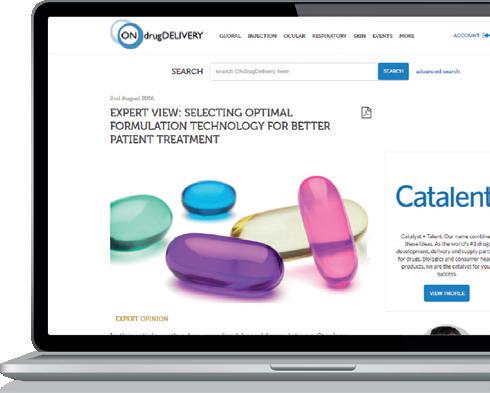
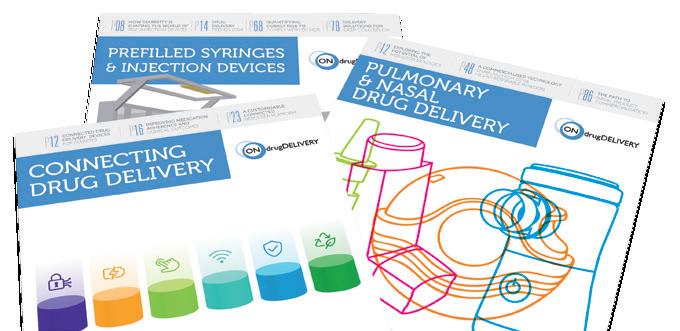


Comprehensive pharmaceutical services for sterile dosage forms.
The complexity and diversity of modern therapeutics is increasing. Medical research is facing growing challenges of stability, usability, and consistent manufacturing.

Pharmaceutical products need to be designed with the patient and regulatory requirements in mind, in order to deliver safe, effective, high-quality, and easy-to-use medicines. At ten23 health, we integrate different elements such as formulation development, manufacturing process design, control strategy, primary packaging, and device selection, to achieve a holistic product design from the start.
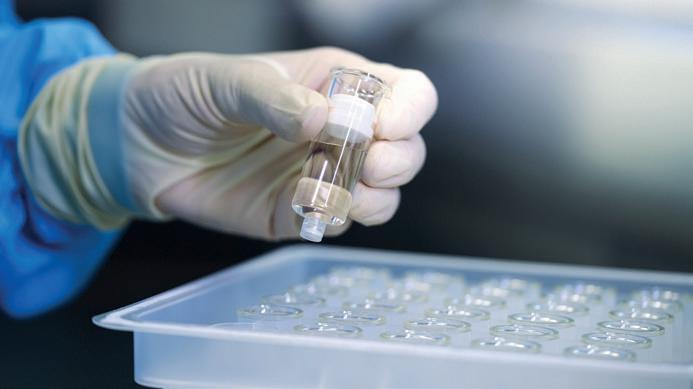
ten 23 health AG
Mattenstrasse 22
4058 Basel, Switzerland
contact@ten23.health
Formulation development for liquid and lyo
Sterile drug product development for different modalities
Sterile manufacturing under cGMP (vials, syringes, cartridges)
Administration compatibility testing
Syringe development, manufacturing, testing
Primary packaging material characterisation
In this article, Alastair Willoughby, Head of Mechanical Engineering, and Prem-Sagar Tank, Consultant Mechanical Engineer, both of Team Consulting, explore various device trade-offs for both sustainability and cost in reusable devices, and consider how this compares with single-use devices.
As autoinjector requirements become increasingly diverse and pharma companies continue to look for faster routes to market – with lower costs and improved sustainability – there is an increasing trend towards devices with a reusable element. These devices work alongside a disposable element, which can range from something approaching the simplicity of a prefilled syringe (PFS) to a more complex assembly incorporating a primary container and additional features, such as needle safety and skin sensing.
Providers of reusable devices make a wide range of claims regarding their benefits over other delivery routes, in particular single-use autoinjectors. These include reductions in:
• Carbon footprint per injection
• Waste and plastic
• Manufacturing footprint and associated costs
• Shipping footprint and associated costs
• Cold chain requirements
• Time to market.
These benefits are potentially true, but it is important to compare them fairly. While a single-use autoinjector may not be the best solution for a frequent, chronic treatment, it may be more suitable when dosing is irregular or where it requires other variations in dosing patterns throughout the treatment journey. These factors all need to be considered when evaluating the benefits of single-use versus reusable products.
Another key factor that needs consideration is, of course, cost. The challenge of creating a reusable platform device that is optimised for both cost and
sustainability is significantly harder than developing a single-use device with a specific purpose in mind.
Finding the “sweet spot” for reusability often depends on the context of use. Taking a single-use autoinjector as a baseline to compare against, different reusable devices will have different break-even points in terms of cost and sustainability. For example, a daily-use device with a 12-month use cycle would have a different break-even point compared with one used weekly for three months.
To understand this break-even point better, device manufacturers need to consider whether patients are realistically going to maintain use of a reusable product throughout their treatment cycle. While this may be true in chronic-use situations, should patients need to alter their dosing or delivery route during their treatment, they may not use the full life of the device. As a result, the claimed benefits of device reusability may not materialise.
When evaluating whether reusability saves on carbon footprint or cost in the long term, device manufacturers also need to understand the carbon costs of different scenarios. Generally, the overall sustainability of a reusable system will depend on a balance between the complexity of the disposable elements and the reusable element, as well as the number of uses over its lifetime. Modelling tools can be an effective way to identify where this “sweet spot” lies for reuse.
“The challenge of creating a reusable platform device that is optimised for both cost and sustainability is significantly harder than developing a single-use device with a specific purpose in mind.”

Alastair Willoughby
Head of Mechanical Engineering
T: +44 1799 532700
E: alastair.willoughby@ team-consulting.com

Prem-Sagar Tank
Consultant Mechanical Engineer
T: +44 1799 532700
E: prem-sagar.tank@ team-consulting.com
Team Consulting Ltd
Abbey Barns
Duxford Road
Ickleton
Cambridge CB10 1SX
United Kingdom
www.team-consulting.com
An effective tool for understanding the sustainability of a device is lifecycle analysis (LCA), which is used to determine the carbon footprint of a product throughout its life.
To illustrate LCA in action, an example analysis was conducted based on the following questions:
• What are the sustainability implications of adding complexity to a reusable element?
• How does this compare with a single-use autoinjector?
The aim was to identify which scenarios would lead to a lower carbon footprint compared with manufacturing multiple single-use devices. Using LCA modelling tools built upon SimaPro, the analysis involved comparing the carbon footprint of four different systems:
• A simple, single-use autoinjector
• A purely mechanical, reusable device, paired with a disposable element based on a standalone PFS needle safety system
• A more complex electromechanical system with connectivity holding the PFS in a cassette format
• A PFS with a plunger rod. This represents the lower bound for the single-use device and both disposable elements.
These systems are shown in Figure 1, illustrating the disposable and reusable elements, as well as the composition of these carbon footprints.
To ensure fair comparisons, it was assumed that all of the products were manufactured and transported along standard routes, using standard fossilbased plastics, East Asian manufacture and transport to Europe. LCAs are generally based on several reasonable assumptions such as these; however, these decisions can significantly impact the results. It is worth noting that LCAs should be conducted and refined throughout the development process, including sensitivity analysis around any assumptions. This can help to understand better how easily the carbon footprint can be reduced through choices such as design elements, manufacturing location and transport method.
While these figures may seem to indicate a clear preference for a single-use device, it is important to also consider the “functional
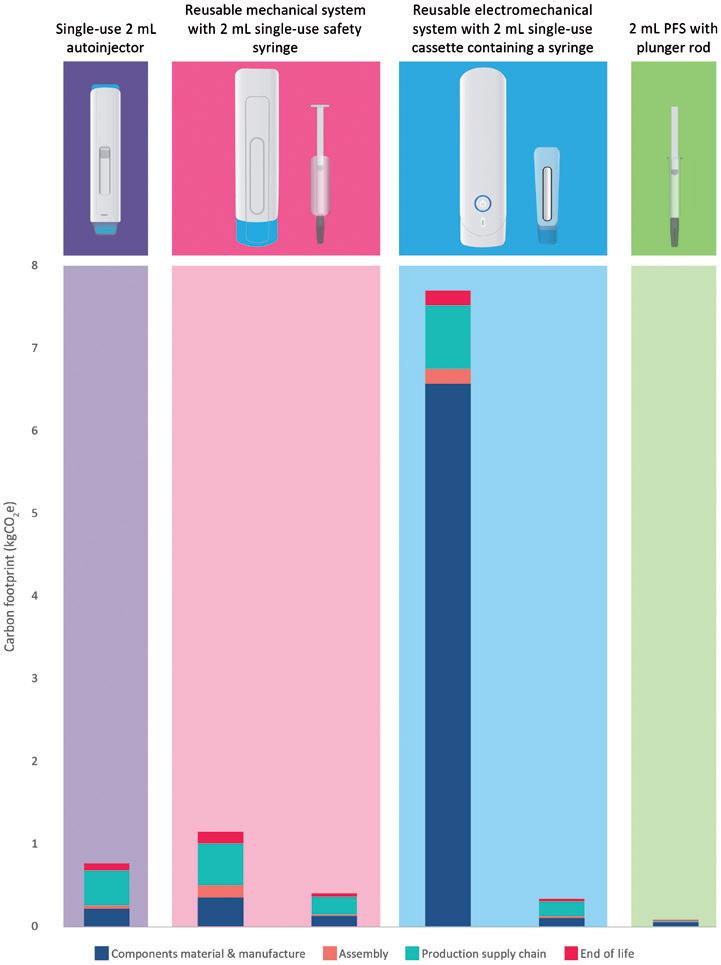
unit” before drawing any conclusions. The functional unit is an LCA term that effectively describes a certain use scenario. For example, in this context it may describe the number of device combinations required to deliver the intended therapy for an average patient, such as a single reusable element paired with a number of disposable elements throughout a prescribed therapy.
REUSABLE VERSUS SINGLE-USE –WHICH IS MORE SUSTAINABLE?
To understand the results of this LCA better, it is important to consider the impact of the various areas explored, including device use and packaging. The results shown in Figure 2 portray the cumulative carbon footprint for up to 120 uses.
Based on this assessment it appears that, over the long term, both the complex and simple reusable devices are preferable relative to a single-use autoinjector. However, if a patient is only using the device for a limited number of cycles (< 20), then a simple reusable device – or a single-use autoinjector for even lower volumes – may lead to a lower carbon footprint compared with a complex reusable device. The exact embodiment of the disposable element will have a significant impact over the long term, as this ends up being the dominant contributor to the carbon footprint.
Packaging Impact
In many scenarios, drug formulations need to be stored in a cold environment
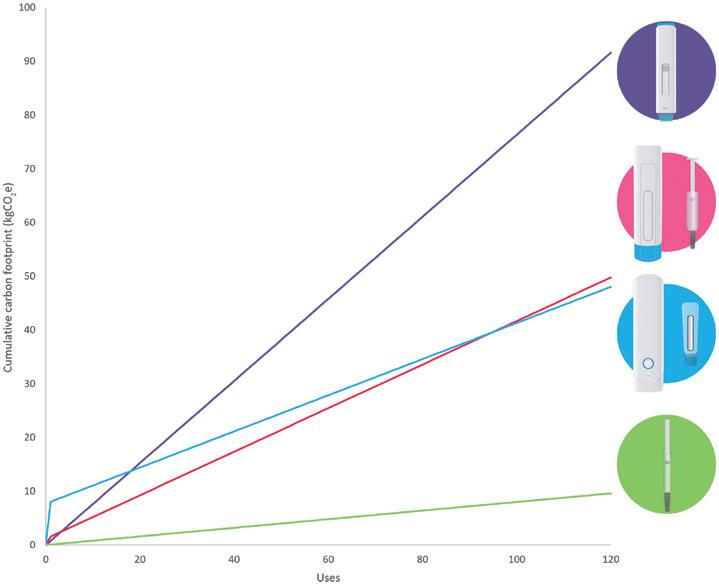
to maintain their efficacy and prolong shelf life. The refrigeration of cold chain consumes more energy than storage and transport without refrigeration. The larger the package, the more space is taken up. This, in turn, reduces the number of devices held within a given volume with a given energy usage, thereby increasing the carbon footprint of the product.
The impact of disposable elements on cold chain transport falls outside the scope of the analysis covered in this study. However, it can be estimated that the volume and mass of the packaged devices could both be reduced by 50% between a single-use autoinjector and a reusable solution. Applying changes such as this can significantly increase the number of devices in a given shipping volume or for a given mass – leading to carbon footprint reductions.
“Ensuring that packaging solutions have low-carbon materials – but are also compact to maximise packing density – is key to fully realising the potential benefits of reduced carbon footprint.”
It is important to note that factors such as these should be incorporated in the LCA, considering the efficiency of the cold chain transport as a whole – in particular in latter stages where fewer materials and devices are transported. In these situations, while mass reduction has a positive impact,
there will still be a significant overhead per device. Ensuring that packaging solutions have low-carbon materials – but are also compact to maximise packing density – is key to fully realising the potential benefits of reduced carbon footprint.
While sustainability considerations are important, businesses must also consider the cost of their devices and the ongoing cost of supplying patients. Using similar assumptions to the LCA, a cumulative cost model can be generated that indicates different break-even points, as shown in Figure 3. When comparing the three injectors with the baseline cost of the PFS, it became clear that a high proportion of the overall cost is driven by the PFS, through a combination of cost of goods and the cost of handling the filled container.
The LCA also showed that a proportion of the carbon footprint is driven by manufacturing, filling and handling of the primary container. As with all calculations, the inclusion (or exclusion) of these steps could have a large impact on the conclusions drawn from the analysis. Due to the single-use nature of the disposables, these factors must be minimised to significantly reduce cost or carbon impact. This is the best way to achieve a genuinely
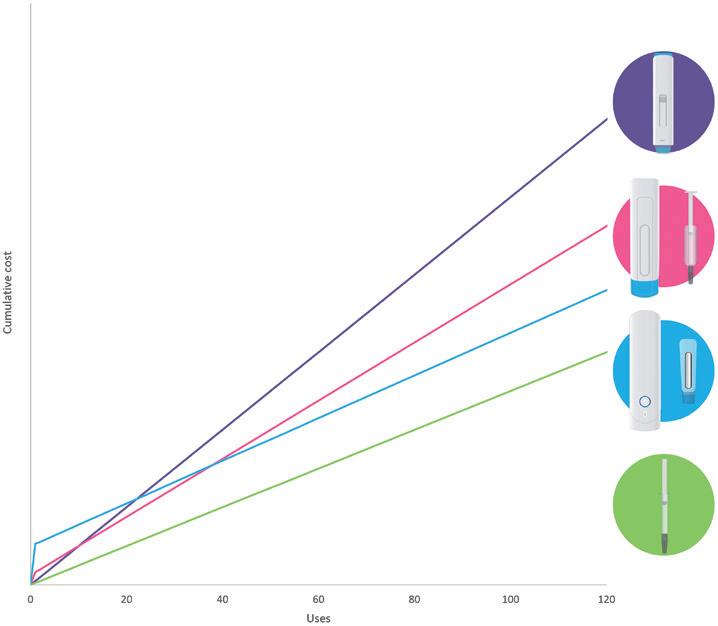
“There are several factors that can impact the sustainability of a product, including both development and user challenges.”
sustainable product, and a low-cost, lowimpact primary container could provide significant benefits in the long term.
When developing a reusable platform, the goal is often to create a device that is as simple as possible, while also creating a wide functional window. In practice, this can lead to over-designed products that are not only uncompetitive in terms of cost but also have a higher carbon footprint.
The question for device manufacturers is: how can you make a product that meets user needs, while making it as sustainable as possible?
There are several factors that can impact the sustainability of a product, including both development and user challenges. These include:
• Delivering high-volume and highviscosity drugs : This requirement increases the required delivery force, meaning the device needs to provide and withstand higher forces, potentially increasing the materials and complexity of the mechanism.
• Specification of reliability in a reusable device: Devices need to be well engineered to cope with multiple use cycles. However, it is also important to ensure that they are not over engineered. One option may be an end-of-life specification and higher conditioning to mimic longer-term use conditions. Additionally, many cycles of user interaction and potential misuse
must also be considered – ensuring users are guided appropriately and that components are robust enough.
• Design for end of life: It is important to consider how to dispose of both the reusable and disposable elements, each of which bring their own opportunities and challenges. The larger footprint associated with the reusable elements, assuming they remain uncontaminated, means that there is more potential for take-back schemes to help reclaim materials and give them a new life. As already discussed, there may be more carbon associated with the disposables over a number of doses. While there are challenges in handling contaminated sharps, steps could be taken to make their disposal more sustainable, such as employing novel waste streams into the take-back schemes.
• Ensuring a simple and clear user interaction: Two-step autoinjectors set a high standard to improve on. This means it can be a challenge to create a reusable device with similar simplicity. Considering user interactions and appropriate design cues from an early stage can reduce frustration and potential misuse with the final product.
• Appropriate feature set : Having a reusable element can lead to feature creep, adding more functionality with small incremental additions each time. While adding screens and connectivity may have benefits for some user populations, this can also significantly change the cost and sustainability models of the product.
Alastair Willoughby, Head of Mechanical Engineering, is Team Consulting’s lead for its cross-functional sustainability offering, where he works with his team to create robust device designs and conduct sustainability analysis. He is an experienced engineer with over 15 years of experience in technical consultancy.
Prem-Sagar Tank, Consultant Mechanical Engineer, is part of Team Consulting’s sustainability engineering team, where he applies tools such as LCA to help determine the environmental impact of different design choices. He has over eight years of experience in product engineering and a master’s degree in Mechanical Engineering with Advanced Design and Innovation.
To address these factors, there are several steps manufacturers can take. It is useful to build an understanding of the market and ensure that any market trade-offs are considered with respect to cost and sustainability metrics throughout the development process. For example, patients with chronic therapy may prefer reusable devices, while patients with occasional therapy may be more accepting of single use devices.
It is important to be clear on what the requirements are for a successful product and what the “stretch goals” are – the impact of these additional goals on baseline costs and sustainability metrics should be considered. For example, the requirement to deliver a wider range of volumes and viscosities may increase cost and complexity. When it comes to the development stage, it can be useful to create a modular product with the potential to interchange elements to increase or reduce functionality. This might involve designing the device so that it can work with a low- or high-force spring, for example. Doing so may lead to cheaper and more efficient production, resulting in a more sustainable product.
Reusable elements can help reduce the carbon footprint of frequently delivered drugs relative to single-use autoinjector systems. However, this is not necessarily the case for all use scenarios, particularly for shorter dosing regimens. Ultimately, device manufacturers should consider the cost and impact of meeting wide user and product needs versus providing a sustainable device at an appropriate financial cost.
Team Consulting is a world-class partner in drug delivery technology design and development. For over 35 years the company has helped its clients create elegant, sustainable solutions to complex healthcare challenges. Team’s multidisciplinary team of experts brings a unique blend of humancentred design, engineering, science and regulatory expertise to every project, with an unparalleled track record in drug delivery technology development. Working with leading pharma companies to emerging startups, Team empowers its clients to create highquality products that improve patient lives.
In this article, Catriona Eldridge, Materials Scientist at Springboard, analyses whether the pharmaceutical industry is meeting its targets and doing enough in the fight against climate change.
In October 2022’s “Drug Delivery & Environmental Sustainability” issue of ONdrugDelivery, Springboard discussed climate-related targets set by 10 major pharmaceutical companies, along with progress towards these targets and their history of meeting previous environmental and climate-related goals.1
The overall outlook in 2022 was not particularly promising, although there were some successes. The RE100 and Energize initiatives were increasing the amount of renewable electricity used throughout the value chain, multiple companies were redesigning products, packaging or manufacturing processes to improve efficiency, and some companies had made major commitments to improving their environmental impact.
The article analysed the targets set by these companies in Scope 1 and 2, as well as in Scope 3. Scope 1 emissions are produced by a company directly on site, Scope 2 emissions are produced directly in a process the company has paid for (such as generating electricity) and Scope 3 emissions are all the other emissions associated with the value chain of a product.2 Figure 1 illustrates the differences between Scope 1, 2 and 3 emissions. It was found that half of these companies had actually increased their emissions over the
“The overall outlook in 2022 was not particularly promising, although there were some successes.”
previous years, and that the typical yearly reductions, if any, were only 7% (Scope 1 and 2) and 6% (Scope 3). In 2022, according to the latest reports, these companies needed reductions of 15% per year to meet their targets.
At the time of writing the previous article, COP26, held in 2021 in Glasgow, Scotland, was the largest and most recent global effort in the fight against climate change, which had stimulated the round of target setting seen in 2020. Since then, the Intergovernmental Panel on Climate Change (IPCC) published its sixth Synthesis Report in March 2023,3 laying out a series of future scenarios varying from 1.5°C warming by 2100 to 4.4°C. These scenarios follow from particular pathways for global greenhouse gas emissions; the report states that the best-case scenario (1.5°C) requires global emissions to peak by 2025, drop to zero by the early 2050s and become negative from then on.
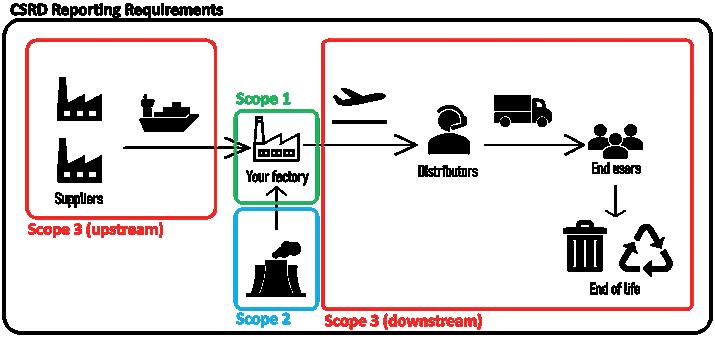

Eldridge
Materials Scientist
T: +44 1223 856454
E: catriona.eldridge@springboard.pro
Springboard Pro Ltd,
a Sanner Group Company
St John’s Innovation Centre Cowley Road
Cambridge CB4 0WS
United Kingdom
www.springboard.pro

The UN has also laid out a roadmap to Net Zero, urging countries, companies and organisations to halve their emissions by 2030 and achieve Net Zero emissions by 2050.4
How have the 10 companies fared in the interval? Have their targets changed? What progress have they made?
Some of the earlier deadlines are now approaching, some as soon as 2024 and 2025. As discussed in the previous article, only half of the targets made since 2000 have been successfully met. The remainder were either explicitly missed, or the outcome was not mentioned in the annual company reports.
Since then, some new targets have been introduced, and others have been adjusted. Generally, where targets have changed, they have become more ambitious. This is clearly necessary – of the 25 targets covered last year, only seven were accredited by the Science Based Targets initiative (SBTi) as consistent with a 1.5°C pathway. The SBTi are technical experts, assessing companies’ emissions-reduction plans against a 1.5°C pathway. Only six companies’ targets were consistent with the new UN target of Net Zero by 2050,
“Some new targets have been introduced, and others have been adjusted. Generally, where the targets have changed, they have become more ambitious.”
which would be broadly in line with the IPCC model for limiting the global temperature rise to only 1.5°C. The largest Scope 3 target in 2022 was a 50% reduction. This year, the largest is AstraZeneca’s planned 98% reduction, where the average Scope 3 target is 70%. As of 2024, of the 48 targets found at the time of writing, 23 have been accredited by the SBTi,5 and nine companies have at least some targets aligned with 1.5°C. This is an improvement on 2022.
The deadlines have not yet been reached for most of these targets, but what progress has been made in reducing emissions? Similar to the picture in 2022, companies need to make significant reductions every year between now and their deadlines to meet their targets. The average annual reduction needed is now 11% of current emissions, every year, with some targets requiring reductions as large as 50% year on year. This average is an improvement on 2022, when the average required reduction was 15% per year, although the largest annual reduction required then was 25%.6
As noted in 2022, emissions are still not yet falling fast enough – in fact, the average year-on-year change in emissions across all scopes was a 2.5% increase in the latest reports.
Scope 1 and 2 emissions decreased for nine of the 10 companies, with an average reduction of 8.5% and a maximum reported reduction of 24%. The lone increase was 2% greater than the previous year’s emissions.
On average, Scope 3 emissions saw a 5.1% year-on-year increase, but this change varied from reported increases of 48% to reported reductions of 7%. There is a slight nuance; over recent years, the reach and accuracy of reporting has improved to meet legislative requirements, such as
“Although the large increases look like a step backwards, they are in fact positive progress. Now these emissions have been identified and recorded, they can be included in emissionsreducing efforts.”
the Corporate Sustainability Reporting Directive and the German Supply Chain Due Diligence Act, and consumer expectations. Reported Scope 3 emissions have increased as reporting expands to include previously under-reported emissions. More recent reporting on 2023 emissions, which is not yet complete for all 10 companies but is less affected by this trend, varies from an increase of 9% to a decrease of 7% in Scope 3 emissions. Only five of the 10 companies reported a decrease in Scope 3 emissions in their most recent reports.
There was large variation in the yearon-year change in all-scope emissions, from an increase of 22% to a reduction of 11%. Scope 3 emissions dominated these increases, as Scope 3 emissions make up between 80% and 90% of total emissions; most companies did report a decrease in their Scope 1 and 2 emissions. As shown in Figure 2, companies’ performance in Scope 3, and therefore overall, varies widely.
Although the large increases look like a step backwards, they are in fact positive progress. Now these emissions have been identified and recorded, they can be included in emissions-reducing efforts.
Of the 20 Scope 3 targets that were considered across the 10 companies, four were on track. One company, Bayer, has already met its smallest target – a 6% reduction in Scope 3 emissions, but the remaining 19 Scope 3 targets have not yet been reached (Figures 3 & 4).
Considering Scopes 1 and 2, again, some early, smaller targets have been met, such as Johnson & Johnson’s aim to reduce their Scope 1 and 2 emissions by 20% between 2015 and 2020. Beyond this specific case, of the 28 targets found, 10 were on track to meet their deadlines, of which three had met their goals early.
But what about the IPCC and UN’s global targets? Reaching Net Zero by 2050 requires reducing emissions by approximately 4% of current emissions every year from 2023. Further work will then be required to achieve net negative emissions from 2050 onwards. Given the annual reductions and efforts discussed above, this does seem feasible. A total of six of the 10 companies examined committed to Scope 3 targets broadly equivalent to Net Zero by 2050, and a further three had committed to Net Zero in their Scope 1 and 2 emissions by 2050.7 Some of these targets are more ambitious than the IPCC’s suggested Net Zero by 2050. Of the more specific targets given, most are short term, and do not reach zero or near-zero emissions. These smaller reductions in emissions are positive, but are not enough to reach Net Zero by 2050 on their own.
These 10 companies are averaging a 0.5% decrease in their total footprints, but only five have reported reductions in their total footprint, and there is significant variation. Although current efforts are falling short, an annual reduction of 4% of current emissions does seem feasible.

The use of power purchasing agreements (PPA) in initiatives such as RE100 and Energize to provide renewable energy supplies for pharmaceutical companies’ suppliers continue to come online, such as Bayer’s PPA with Omega Energia –a 1.87 GW renewable energy generator coming online in 20248 – or Merck’s PPA with the Azure Sky project, matching 65% of Merck’s US energy consumption.9 Of the 10 companies, seven had made the RE100 pledge by September 2022, with deadlines ranging from 2025 to 2030.10
The RE100 initiative is a pledge to use only renewable electricity supplies by a certain deadline. At the time of writing, no more companies have made this pledge, but AstraZeneca has brought its target forward by five years to 2025.
There is progress being made. Companies are increasingly putting their money behind
“Another emerging trend is measuring the carbon or energy intensity of revenue or profits.”
these promises; for example, AstraZeneca spent US$26.6 million (£20.6 million) in 2022 and US$33.7 million in 2023 on environmental efficiency projects.
Another emerging trend is measuring the carbon or energy intensity of revenue or profits. This metric, using units such as kg CO2eq/USD or kWh/EUR, allows companies to decouple financial growth from increasing emissions. Reducing this value would show that companies can reduce their emissions without reducing

economic success. Bayer is introducing an internal carbon price and Merck is developing its Sustainable Business Value method, allowing it to put a monetary value on environmental benefits. Pfizer factors in key performance indicators, which include climate goals, when calculating compensation for some of its staff.
These are concrete steps towards better, more environmentally sustainable decision making at the local and strategic levels.
Multiple companies are redeveloping their current products and logistics to reduce environmental impact. AstraZeneca and GSK have both committed to developing improved next-generation versions of their current pressurised metered dose inhalers (pMDIs), transitioning to much lower global warming potential propellants.11,12 This will reduce the emissions associated with the use of these inhalers by as much as 99%, and the Scope 3 emissions of AstraZeneca and GSK by 41% and 15%, respectively. The process, which is well underway, will require extensive safety testing and a thorough redesign of the inhaler to accommodate the new propellant.
Koura (MA, US) and Honeywell (NC, US) are both developing new propellants, HFA-152a and HFO-1234ze, ready for this new market. Compared with the current propellants, such as HFA-132 and HFA 227ea, these propellants would lower the carbon footprint of a single dose by 90%–99%. This is a significant reduction as inhalers, predominantly the currently used propellants in them, account for 3% of the entire UK NHS carbon footprint.13 If all the current pMDIs in the NHS were to switch to new propellants, such as HFA-152a, the total NHS footprint could be reduced by approximately 2.7%. AstraZeneca aims to have its new inhaler ready for market launch in 2025 and says it is “on plan” to meet this goal, with HFO-1234ze in Phase II trials, as of 2022.
Sandoz has also recently redesigned the packaging and case for its longstanding Omnitrope Surepal (somatropin) therapy. Lifecycle assessments and human factors studies were used in combination to develop a new design that, beyond the environmental benefits of a lower-impact design, was also more user-friendly.
Pfizer has also significantly lowered its Scope 3 transport emissions by transitioning suitable product shipments from air to ocean in 2022. This saved approximately 50 Gt of CO2(eq), or around 6% of their reported Scope 3 emissions.
“If all the current pMDIs in the NHS were to switch to new propellants, such as HFA-152a, the total NHS footprint could be reduced by approximately 2.7%.”
In conclusion, although progress overall continues to be mixed, serious efforts are clearly being made by several major pharmaceutical companies. Some have managed to achieve a reduction in total emissions over the last year, and several have set reductions targets compatible with the IPCC’s 1.5°C pathway. The scope and accuracy of climate-related reporting has improved. We are beginning to see the impact of PPAs and improved transport efficiency. Multiple sustainability focused product redesigns are underway.
The IPCC and UN pathways show that there is clearly a lot more work to do, but accurate emissions reports provide a roadmap for the work ahead, and the pharmaceutical industry has begun moving towards Net Zero.
Springboard is an engineering consultancy that specialises in developing devices from concept to manufacture for regulated markets. The company is an expert in creating innovative yet robust designs and solving difficult technical problems quickly. As part of the Sanner Group, Springboard also has access to expertise in design for manufacture and mass manufacturing capabilities to help scale up from prototyping to full-scale production.
1. Eldridge C, Shah O, “Climate Change and the Pharmaceutical Industry: Too Little, Too Late?”. ONdrugDelivery, Issue 139 (Oct/Nov 2022), pp 18–21.
2. “Energy Explained”. National Grid, accessed Mar 2024.
3. “AR6 Synthesis Report: Climate Change 2023”. IPCC, accessed Mar 2024.
4. “For a livable climate: Net-zero commitments must be backed by credible action”. United Nations, accessed Mar 2024.
5. “Ambitious corporate climate action”. Science Based Targets, accessed Mar 2024.
6. References available upon request.
7. References available upon request.
8. “Bayer signs wind, solar PPA with Brazil’s Omega Energia”. Renewables Now, May 27, 2021.
9. “Merck Brings New Renewable Energy to the Grid through Virtual Power Purchase Agreement with Enel Green Power”. Press Release, Merck, Mar 16, 2021.
10. “RE100 Members”. Web Page, RE100. (https://www.there100.org/re100members, accessed March 22, 2024)
11. “GSK announces major step towards sustainability ambitions with advancement of low carbon Ventolin programme to Phase III trials”.
Press Release, GSK, Nov 21, 2023.
12. “AstraZeneca progresses Ambition Zero Carbon programme with Honeywell partnership to develop nextgeneration respiratory inhalers”. Press Release, AstraZeneca, Feb 22, 2022.
13. “Blog: Delivering high quality, low carbon respiratory care”. UK NHS, Feb 13, 2023.
Catriona Eldridge is a Materials Scientist and sustainability lead at Springboard. She has a broad knowledge of engineering materials and manufacturing methods, as well as sustainability strategy and lifecycle assessment. She completed her MSc at the University of Cambridge (UK), with a focus on nanostructure materials. Ms Eldridge’s work at Springboard involves both new product design and applying scientific analysis to issues in existing products in order to find solutions.

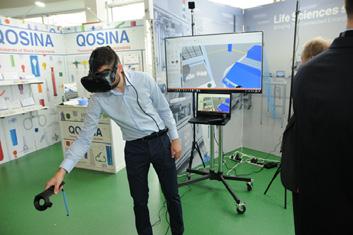
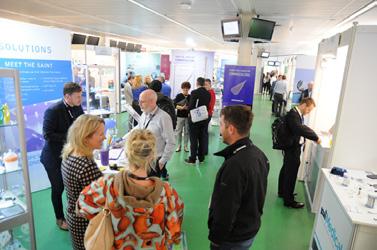
In this article, Pauline Janssen, Product Application Specialist at DFE Pharma, discusses the various available devices for pulmonary delivery of medications, with a deeper dive into the challenges presented by replacing pressurised metred dose inhalers propellants with high global warming potential with new alternatives, or whether the optimal solution could be phasing out pressurised metered dose inhalers in favour of dry powder inhalers.
Breathing: something that comes naturally but is vital to our existence. The lungs are amongst the most important human organs and are continuously in contact with our environment via the exchange of air. The lungs are therefore an entrance portal for pathogens and viruses, potentially leading to respiratory diseases, such as covid-19.1 Other common respiratory diseases include asthma and chronic obstructive pulmonary disease (COPD). People suffering from these diseases experience problems with breathing and obstructed airflow. Hence, pulmonary treatment is required.
Pulmonary delivery is a noninvasive, patient-friendly route of drug administration that offers several advantages over other delivery routes. Pulmonary delivery avoids the first-pass effect of the gastrointestinal (GI) tract and liver, which results in high bioavailability.2 The lungs are reported to be more permeable to small-molecule and macromolecule drugs than any other portal of entry into the body,3 which means that lower doses are required to reach the target effective dose, reducing the systemic side effects at offtarget locations in the body.
Another advantage of pulmonary delivery relates to the rapid and predictable onset of action associated with it. This is due to the large surface area of the lungs available for absorption, even though the lungs compromise only a relatively low mass fraction of the body.1
Many different inhalation devices are available in the market to enable pulmonary drug delivery. These devices differ in their efficiency, internal resistance, formulation of medication, particle size, velocity of the aerosol plume and ease of use.6–8 These devices can be categorised into four main types – dry powder inhalers (DPIs), nebulisers, soft mist inhalers (SMIs) and pressurised metered dose inhalers (pMDIs).9 Each type of device has its own advantages and disadvantages.
Dry Powder Inhalers
DPIs are compact and portable devices that are designed to deliver medication in the form of a dry powder, which can be beneficial for the physical and chemical stability of a formulation. Generally, a single quick inhalation event is sufficient to deliver a complete dose to the lungs. Doses are typically in the microgram range, but particle engineering technologies can allow expansion to milligram ranges. A patient breathing through the device actuates the dispersion of the formulation into the inhaled air. The energy from the patient’s breath therefore needs to be sufficient to disperse the particles into the air stream. An advantage of breath-actuated pulmonary delivery is that only limited levels of patient co-ordination are required.
DPIs are a relatively new type of pulmonary delivery device, entering the respiratory market in 1967.10 Currently,
“An advantage of breath-actuated pulmonary delivery is that only limited levels of patient co-ordination are required.”

Pauline Janssen
Product Application Specialist
T: +31 6 21154579
E: pauline.janssen@dfepharma.com
DFE Pharma GmbH & Co KG Klever Strasse 187 47568 Goch
Germany
www.dfepharma.com
about 22% of all inhalation devices sold worldwide are DPIs and their market share is expected to increase in the coming years.11
A nebuliser is a type of inhalation device used to administer medication in the form of a mist. The drug is dissolved or suspended in a polar solvent, which is turned into an aerosol by external energy. As a result, nebulisers are typically bulky, noisy devices that require an external power source. Jet nebulisers, for example, create a mist by flowing compressed air or oxygen at a high velocity over the liquid, while ultrasonic nebulisers create a mist via a high-frequency ultrasonic wave.
The mist created by a nebuliser is inhaled for a prolonged period of approximately 20 minutes through a mouthpiece or mask.2 Drug waste levels are relatively high, requiring larger doses for administration. The main advantage of nebulisers is the absence of a need for strong breathing or co-ordination, allowing patients unable to carry out active inhalation to use these devices.12
Nebulisers are mainly used for incidental or temporary administration by healthcare providers. Consequently, nebulisers account for only a relatively small share of the respiratory market (9%) and the amount of consumed units grew by less than 1% in the 2018–2022 period.11
SMIs contain liquid formulations similar to those in nebulisers. However, SMIs are small, portable, handheld inhalers that do not require a power supply. Drug deposition is not actuated by the patient’s breath, but rather a variety of principles that are used to create a slow-moving, longsustaining aerosol cloud upon actuation.13 The advantage of this aerosol cloud is that the co-ordination between actuation and inspiration is less critical than for pMDIs, although a long breath is required for optimal inhalation. SMIs can deliver doses in the microgram range, typically with a high lung deposition that is less dependent on the inspiratory flow of the patient.14 SMIs need to be primed before the first use, which needs to be partly repeated if a device has not been used for more than three days.15
SMIs are relatively new in the market, resulting in limited availability and typically higher costs than more established inhaler types.16 Currently, their market share
“SMIs are relatively new in the market, resulting in limited availability and typically higher costs than more established inhaler types.”
is 3% with a growth of 6% in consumed units over the 2019–2022 period.
Pressurised Metered Dose Inhalers
pMDIs are portable, easy-to-use devices for the administration of medication via a short burst of aerosolised medicine. pMDI formulations contain drug particles that are dissolved or dispersed in a liquified propellant. Drug deposition via the nozzle is activated by pressing down the top of the canister. Consequently, expansion of the propellant results in atomisation of the formulation into small droplets. Actuation of a pMDI should be done in parallel with inhalation by the patient to administer the medication effectively. Besides the difficult co-ordination of actuation and inhalation, patients have also indicated that it is difficult to determine when their pMDI is empty.12
The pMDI was the first portable inhalation device to be launched in the market, starting with the introduction of the first pMDI in 1956.17 Since then, pMDIs have become the most widely prescribed inhalation device for drug delivery to the respiratory tract.12 This is mainly driven by the relatively low cost of pMDIs, and therefore the wide availability of this type of device. The pMDI segment accounts for 65% of the global respiratory market, with a moderate growth of 1.8% in consumed units since 2018.11
The main challenge of pMDIs is the carbon footprint associated with them, which is playing a pivotal role in the expected growth of this inhaler type. Currently used propellants have a substantial environmental impact, and reformulating to available alternatives comes with challenges.
While efficacy and safety have always been top priority in the selection of a medication, increased attention is now being paid
to the environmental impact as well. In particular, pMDIs are under scrutiny due to their propellants being potent greenhouse gases. The propellant comprises the bulk of any pMDI formulation. It is required to be toxicologically safe, non-flammable and chemically inert, with appropriate boiling points and densities, as well as needing to provide the same vapour pressure regardless of whether the pMDI canister is full or empty.18 Initially, pMDIs were formulated with chlorofluorocarbons (CFCs) as propellants. However, in 1987, the Montreal Protocol was signed to control and phase out ozonedepleting substances, including CFCs. CFC-propelled pMDIs have been the only major exemption from the protocol under a clause for “essential use”, but only for a limited period of time while no alternatives were available.19
Hydrofluoroalkanes (HFAs) have been found to not deplete stratospheric ozone and are proven to be safe as pharmaceutical excipients.20 Thus, HFA 227 and HFA 134a were developed to replace CFC propellants in pMDI formulations. These HFAs could not directly substitute for CFC propellants, as previously used excipients and hardware components were not compatible with HFA formulations, due to the different physiochemical properties. Therefore, significant effort and investments were required to develop new device hardware and formulation approaches.18 It has taken a couple of decades to complete, but transition has been a worldwide collaborative success.
While the ozone-friendly HFAs developed to replace CFCs do not deplete the ozone layer, they are potent greenhouse gases with global warming potential (GWP) ranging from 1300–2900 g CO2 equivalents.21 So, even though large
“While the ozone-friendly HFAs developed to replace CFCs do not deplete the ozone layer, they are potent greenhouse gases with global warming potential (GWP) ranging from 1300–2900 g CO2 equivalents.”

improvements have been achieved in the environmental impact of pMDIs by switching from CFCs to HFAs, HFAs are also expected to have a substantial impact on global warming if production is not controlled.22 Phasing out of HFA 134a and HFA 227 is now planned under the Kigali Amendment to the Montreal Protocol in 2016,23 as well as through national F-gas regulations in Europe24 and the US.25 Figure 1 shows an overview of the GWP of the different propellants. Two propellants have been proposed for pMDIs with significantly lower GWPs, those being HFA 152a and HFO 1234ze(E).
So, what is the future for pMDIs? Is there even still potential for them? It must be noted here that no consensus exists on what is the best inhaler for patients, and the most appropriate inhaler can only be identified on a case-by-case basis. In the majority of cases, switching patients from pMDI medication to DPI medication results in improved or equal disease control.27–29
For certain groups of patients, however, an impaired ability to inhale quickly could hinder the correct use of a DPI.26 With this in mind, it will be impossible to replace pMDIs completely, as they are required from a clinical perspective for reliever medication at the least.
To reduce the environmental impact of critical pMDIs, there is a need for lowGWP propellants to replace those currently in use. Many pharmaceutical companies, however, have spent a lot of effort and money to support the phase-out of CFCs and are reluctant to repeat this process. Two propellants have been proposed for pMDIs with significantly lower GWP –HFA 152a and HFO 1234ze(E). One of the critical activities for the introduction of these propellants is the generation of long-term human safety data that may be required before getting market authorisation. Furthermore, both HFA 152a and HFO 1234ze(E) have some patent applications relating to its use as a medical propellant, making implementation of these propellants more complex.30–34
One of the challenges associated with HFA 152a in particular is that it is a flammable propellant, with an explosive limit of 3.9% by volume in air at room temperature.35 Safe manufacturing processes for HFA 152a still need to be developed, which will necessitate large investments for completely new infrastructures for the production of low-GWP pMDIs.
HFO 1234ze(E) is the most attractive propellant from an environmental perspective. Additionally, as Table 1 indicates, this propellant is more similar to HFA 134a and HFA 227 in relevant physical properties, indicating that there are likely to be fewer challenges with reformulation. The main challenge associated with HFO 1234ze(E), however, is that it is a newer propellant with a more complex chemical synthesis, resulting in higher production costs. This will likely lead to a higher supply price compared with other propellants, putting the costs of the final pMDI under pressure. As cost effectiveness has been the main advantage of pMDIs, it might be difficult to make a convincing business case for the implementation of HFO 1234ze(E).

Figure 2: Graph showing the indicative monthly carbon footprint in lifecycle analyses. *Clenil HFA 152a shows the predicted carbon footprint of a potential future HFA 152a-containing pMDI.28
DPIs AS AN ALTERNATIVE FOR MDIs
The price of more environmentally friendly propellants is increasing the cost of pMDIs. With challenges in patient adherence, it remains a question if switching to low-GWP pMDIs is the right way forward. There is presently an opportunity to switch to different types of inhalers that are equivalent in cost and more environmentally friendly. Figure 2 shows the GWP over the lifecycle of different types of inhalers, indicating large differences between the different types of pMDIs, due to the amount and type of propellants used. In general, pMDIs with HFA propellants have about 30 times the GWP of equivalent DPIs. Switching to DPIs would therefore provide a huge opportunity to reduce greenhouse gas emissions.
Research has been performed to evaluate if transferring patients from pMDIs to DPIs would result in a change in disease control. For example, Singh et al compared the performance of DPI and pMDI formulations of beclomethasone/formoterol fumarate. The study concluded that the performance of an extrafine Fostair® 100/6 μg NEXThaler (Chiesi) DPI was comparable to an extrafine Foster® 100/6 μg pMDI when administered as reliever therapy after methacholine induced bronchoconstriction to mimic an asthma attack.36 The degree of bronchodilation achieved with the DPI and pMDI was practically identical, both in magnitude and onset of action. The contribution of these two devices (based upon 120 doses) over the entire lifecycle of the device was calculated by Panigone et al. A Fostair® 100/6 μg pMDI was calculated to have a GWP of 94.4 g CO2 equivalents per actuation,
“Studies have shown that switching from a pMDI to a DPI medication typically does not affect the disease control for patients.”
while the Fostair® 100/6 μg DPI was calculated to have a GWP of 7.63 g CO2 equivalents per actuation.37
Studies have shown that switching from a pMDI to a DPI medication typically does not affect the disease control for patients. Woodcock et al studied patients with symptomatic asthma who switched from pMDI medication to the Ellipta DPI (GSK). By switching to a DPI, patients more than halved their inhaler’s carbon footprint, without any loss in asthma control.27 Conversely, a worsening of asthma control was observed in the UK when patients were switched from a DPI to a pMDI for financial reasons.28
Interchangeability of different device types was also confirmed by the distribution of inhaler sales across different countries in Europe, as indicated in Figure 3. In the UK, approximately 70% of the total retail units sold were related to pMDI treatment, while in Sweden the number was only 10%. Differences were not expected to be the result of different health indications per country,38 indicating that different device types can be used effectively for treatment of the same disease.
Pulmonary drug delivery is a non-invasive, patient-friendly route of administration that is getting increased interest due to the advantages it has to offer. Different types of inhalers exist, and the most appropriate inhaler can only be identified on a case-by-case basis. While efficacy and safety have always been a top priority in choosing medication, there is now increased attention being paid to the environmental impact as well.
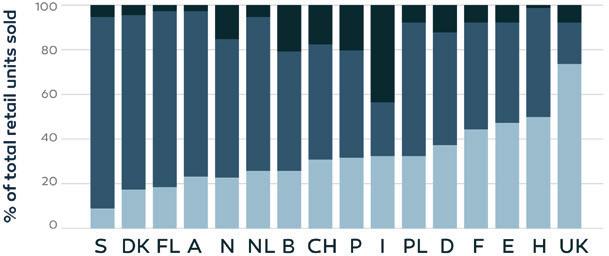

Figure 3: Retail sales of inhalation devices, expressed as percentages of the total sales, in 16 European countries over the time period 2002–2008 (A, Austria; B, Belgium; CH, Switzerland; DK, Denmark; E, Spain; F, France; FL, Finland; H, Hungary; I, Italy; D, Germany; N, Norway; NL, Netherlands; P, Portugal; PL, Poland; S, Sweden; UK, United Kingdom).38
The global warming debate has already been a challenge for the pMDI industry for decades. A significant amount of effort and money has already been spent to replace CFC propellants with more environmentally friendly alternatives. Two strategies that have been proposed to reduce the GWP of pMDIs include switching to low-GWP propellants and switching to other types of device when possible. Two propellants have been proposed for the development of pMDIs with significantly lower GWP, each with their own challenges and associated costs. HFA 152a is a flammable propellant, which means that safe manufacturing processes will need to be developed, requiring large investments for completely new infrastructure. HFO 1234ze(E) is less flammable and is the most attractive propellant from an environmental perspective, but it is a newer propellant with a more complex chemical synthesis, resulting in higher production costs. As prices of currently used propellants and future propellants increase the costs of pMDIs, the main advantage of pMDIs over other devices is diminishing. Multiple studies have shown that DPIs typically result in equivalent or better disease control than pMDIs. Switching therapies from pMDIs to DPIs could therefore present a major opportunity to reduce greenhouse gas emissions, without reducing disease control.
DFE Pharma is a global leader in pharmaceutical and nutraceutical excipient solutions. DFE develops, produces and supplies high-quality functional excipients for use in the pharmaceutical, biopharmaceutical and nutraceutical industries for oral solid dose, respiratory, ophthalmic and parenteral formulations. With over 100 years of experience, DFE serves over 5,000 customers across more
than 100 countries worldwide. DFE Pharma offers a comprehensive portfolio comprised of more than 200 products. DFE’s excipients cover oral solid dose across fillers, binders and disintegrants application areas, helping the company’s customers to develop efficient and cost-effective dosage forms.
1. Anderson S et al, “Inhaled Medicines: Past, Present, and Future”. Pharmacol Rev, 2022, Vol 74(1), pp 48–118.
2. Cheng Y et al, “Compatible Stability and Aerosol Characteristics of Atrovent® (Ipratropium Bromide) Mixed with Salbutamol Sulfate, Terbutaline Sulfate, Budesonide, and Acetylcysteine”. Phamaceutics, 2020, Vol 12(8), Article 776.
3. Patton JS, Fishburn CS, Weers JG, “The lungs as a portal of entry for systemic drug delivery”. Proc Am Thorac Soc, 2004, Vol 1(4), pp 388–344.
4. Ibrahim M, Verma R, Garcia-Contreras L, “Inhalation drug delivery devices: technology update”. Med Devices (Auckl), 2015, Vol 8, pp 131–139.
5. Kim ES, Plosker GL, “AFREZZA® (insulin human) Inhalation Powder: A Review in Diabetes Mellitus”. Drugs, 2015, Vol 75(14), pp 1679–1686.
6. Laube BL et al, “What the pulmonary specialist should know about the new inhalation therapies”. Eur Respir J, 2011, Vol 37(6), pp 1308–1331.
7. Dolovich MB, “Device selection and outcomes of aerosol therapy: Evidence-based guidelines: American College of Chest Physicians/American College of Asthma, Allergy, and Immunology”. Chest, 2005, Vol 127(1), pp 335–371.
8. Dolovich MB, Dhand R, “Aerosol drug delivery: developments in device design and clinical use”. Lancet,
Pauline Janssen is a Product Application Specialist and Product Development Manager at DFE Pharma. She has worked on application development of excipients based upon fundamental knowledge of excipients and powder physics. Ms Janssen joined DFE Pharma at the beginning of 2017 and worked on multiple oral solid dosage and dry powder inhalation projects. She holds a master’s degree (cum laude) in Physical Chemistry from the Radboud University in Nijmegen (the Netherlands), with an additional specialisation in Science, Management and Innovation. She has also been affiliated with the University of Groningen as a PhD student in Pharmaceutical Technology since April 2022.
2011, Vol 377(9770), pp 1032–1045.
9. Doyle GR, McCutcheon JA, “6.6 Administering Inhaled Medications” in “Clinical Procedures for Safer Patient Care”. BCcampus, 2015.
10. de Boer AH, Hagedoorn P, Grasmeijer F, “Dry powder inhalation, part 2: the present and future”. Expert Opin Drug Deliv, 2022, Vol 19(9), pp 1045–1059.
11. IQVIA data, 2022.
12. Lavorini F, Fontana GA, Usmani OS, “New inhaler devices - the good, the bad and the ugly”. Respiration, 2014, Vol 88(1), pp 3–15.
13. Lavorini F, “The challenge of delivering therapeutic aerosols to asthma patients”. ISRN Allergy, 2013, Vol 2013, Article 102418.
14. Anderson P, “Use of Respimat Soft Mist inhaler in COPD patients”. Int J Chron Obstruct Pulmon Dis, Vol 1(3), pp 251–259.
15. Gerald LB, Dhand R, “Patient education: Inhaler techniques in adults (Beyond the Basics)”. UpToDate, Dec 2022.
16. Hodder R, Price D, “Patient preferences for inhaler devices in chronic obstructive pulmonary disease: experience with Respimat Soft Mist inhaler”. Int J Obstruct Pulmon Dis, 2009, pp 381–390.
17. Preedy EC, Prokopovich P, “2 – History of inhaler devices” in “Inhaler Devices: Fundamentals, Design and Drug Delivery” (Prokopovich P ed). Woodhead Publishing, 2013.
18. Myrdal PB, Sheth P, Stein SW, “Advances in metered dose inhaler technology: formulation development”. AAPS PharmSciTech, 2014, Vol 15(2), pp 434–455.
19. Woodcock A, “The president speaks: prevention is best: lessons from protecting the ozone layer”. Thorax, 2012, Vol 67(12) pp 1028–1031.
20. Hendeles L, Colice GL, Meyer RJ, “Withdrawal of albuterol inhalers containing chlorofluorocarbon propellants”. N Engl J Med, 356(13), pp 1344–1351.
21. Wilkinson AJK et al, “Costs of switching to low global warming potential inhalers. An economic and carbon footprint analysis of NHS prescription data in England”. BMJ Open, 2019, Vol 9(10), Article e028763.
22. Velders GJM et al, “The importance
of the Montreal Protocol in protecting climate”. Proc Natl Acad Sci USA, 2007, Vol 104(12), pp 4814–4819.
23. “About Montreal Protocol”. Web Page, UN Environment Programme, Accessed Mar 2024.
24. “Regulation (EU) No 517/2014 of the European Parliament and of the Council of 16 April 2014 on fluorinated greenhouse gases and repealing Regulation (EC) No 842/2006”. European Commission, 2014.
25. “F-Gas Partnership Programs”. US Environmental Protection Agency, Web Page, Accessed Mar 2024.
26. Pritchard JN, “The Climate is Changing for Metered-Dose Inhalers and Action is Needed”. Drug Des Devel Ther, 2020, Vol 14, pp 3043–3055.
27. Woodcock A et al, “Effects of switching from a metered dose inhaler to a dry powder inhaler on climate emissions and asthma control: post-hoc analysis”. Thorax, 2022, Vol 77(12), pp 1187–1192.
28. Wilkinson A, Woodcock A, “The environmental impact of inhalers for

asthma: A green challenge and a golden opportunity”. Br J Clin Pharmacol, 2022 Vol 88(7), pp 3016–3022.
29. Janson C et al, “Carbon footprint impact of the choice of inhalers for asthma and COPD”. Thorax, 2020, Vol 75(1), pp 82–84.
30. Knopeck GM et al, “Medicament delivery formulations, devices and methods”. Patent US20160324778A1, 2016.
31. Pham HT, Singh RR, “Sprayable composition comprising a propellant composition comprising 1,3,3,3-tetrafluoropropene (HFO1234ze) and a material to be sprayed”. Patent ES2551936T5, 2015.
32. Corr S, Noakes TJ, “Stable pharmaceutical compositions comprising indacaterol and 1,1-difluoroethane (hfa-152a) suitable for use in metered dose inhalers (mdis)”. Patent CA3037080C, 2018.
33. Corr S, Noakes TJ, “Stable pharmaceutical compositions comprising salmeterol and 1,1-difluoroethane (hfa-152a) suitable
for use in metered dose inhalers (mdis)”. Patent CA3037107C, 2018.
34. Corr S, Noakes TJ, “Stable pharmaceutical compositions comprising glycopyrrolate and 1,1-difluoroethane (hfa-152a) suitable for use in metered dose inhalers (mdis)”. Patent CA3037092C, 2018.
35. “HP 152a Aerosol Propellant”. Chemours, 2017.
36. Singh D et al, “Comparison of the effect of beclometasone/formoterol in asthma patients after methacholine-induced bronchoconstriction: A noninferiority study using metered dose vs. dry powder inhaler”. Br J Clin Pharmacol, 2019, Vol 85(4), pp 729–736.
37. Panigone S et al, “Environmental impact of inhalers for respiratory diseases: decreasing the carbon footprint while preserving patienttailored treatment”. GMJ Open Respir Res, 2020, Vol 7(1), Article e000571.
38. Lavorini F et al, “Retail sales of inhalation devices in European countries: so much for a global policy”. Respir Med, 2011, Vol 105(7) pp 1099–1103.
27-28 JUNE, 2024 Barcelona, Spain
Inhalation & RESpiratory Drug Delivery | CONnected


In this article, Benjamin Myatt, PhD, Senior Product Development Engineer at Kindeva Drug Delivery, and Daniel Duke, PhD, Senior Lecturer, Mechanical & Aerospace Engineering at Monash University, explore the low-global-warmingpotential propellants available and their implications for the performance of pressurised metered dose inhalers.
In response to changing legislative requirements due to environmental concerns, pharmaceutical companies are exploring switching to more environmentally friendly pressurised metered dose inhaler (pMDI) propellants. Now, the search is on to understand how these new, low-globalwarming-potential (GWP) propellants affect the performance of pMDIs.
Low-GWP candidate propellants have different physicochemical and thermodynamic properties from current hydrofluorocarbon (HFC) gases, which means a change in propellant may necessitate adjustments to formulation and/or hardware.
The industry made a significant shift in propellant gas use with the signing of the Montreal Protocol on Substances That Deplete the Ozone Layer in 1987.1 That agreement led to a transition from ozone-depleting chlorofluorocarbons (CFCs) to HFC-based propellants.
The current drive towards low-GWP propellants is motivated by the Kigali Amendment to the Montreal Protocol, which aims to phase down the use of HFCs with high GWPs.1 Current pMDI
propellants, HFA-134a and HFA-227, have relatively high GWP values.2 The industry is exploring alternative propellants, such as HFA-152a and/or HFO-1234ze(E), which have significantly lower GWP values and will significantly reduce the carbon footprint of pMDIs These propellants have 90% and 99.9% lower GWP than HFA-134a, the greenest pMDI propellant currently used.3
Propellant properties affect all fundamental aspects of pMDIs. The differences in thermodynamic, physical and chemical properties can all impact pMDI functionality. For example, the lower density of certain low-GWP propellants could affect the physical suspension stability of a pMDI. Similarly, the higher surface tension values of HFA-152a and HFO-1234ze(E) could impact the initial droplet size formed upon atomisation and, subsequently, the final residual droplet size that reaches the lungs. The differences in properties indicate low-GWP propellants may have a less aggressive atomisation process.
“Understanding the properties of low-GWP propellants is essential for preserving performance.”

Dr Benjamin Myatt
Senior Product Development Engineer
E: benjamin.myatt@kindevadd.com
Kindeva Drug Delivery
Building 39, Charnwood Campus Bakewell Road Loughborough
LE11 5RB
United Kingdom
www.kindevadd.com

Dr Daniel Duke
Senior Lecturer, Mechanical & Aerospace Engineering Monash University
E: daniel.duke@monash.edu www.monash.edu
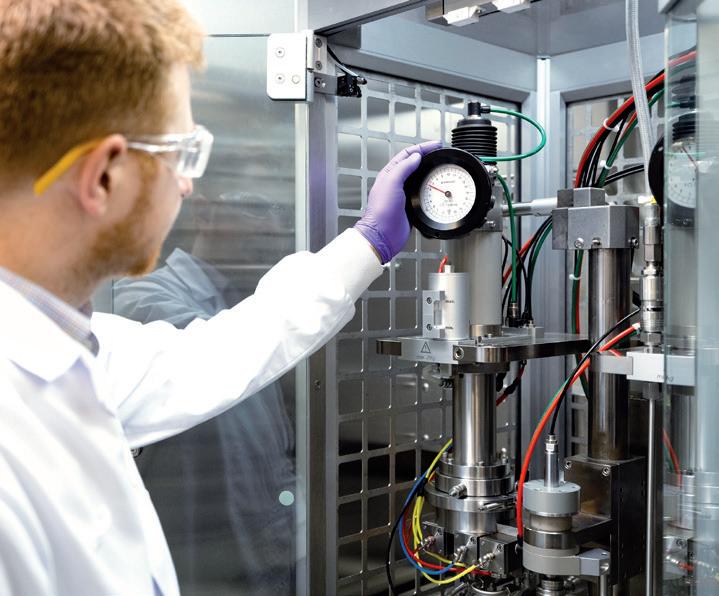
Understanding the properties of lowGWP propellants is essential for preserving performance (Figure 1). Kindeva Drug Delivery, in partnership with Australiabased Monash University, the Woolcock Institute of Medical Research and Macquarie University, are benchmarking low-GWP propellant products against current systems. To do this, the team of research partners uses a range of novel measurement methodologies alongside compendial techniques to understand the pMDI performance of various gases better.
COLLABORATIVE APPROACH TO UNDERSTANDING LOW-GWP PROPELLANTS
Kindeva is seeking to understand the physics behind pMDI atomisation better, and how these processes change with the switch to low-GWP propellants. This research is focused on the following:
• Benchmarking to understand the differences in product performance when switching propellants
• Investigating mitigation strategies to optimise performance using current hardware and formulation toolbox parameters
• Exploring new opportunities to improve pMDI performance through novel hardware developments.
“Vapour pressure, density, surface tension, specific heat capacity and latent heat of vapourisation of low-GWP propellants may all impact pMDI performance.”
Analysing the performance of pMDIs is complex due to the transient nature of the atomisation process, both inside the device and in the spray itself. The propellant liquid rapidly depressurises when a pMDI is actuated, which leads to chaotic atomisation. Vapour pressure, density, surface tension, specific heat capacity and latent heat of vapourisation of low-GWP propellants may all impact pMDI performance.
Kindeva has partnered with the team at Monash University, who have developed an ultra-high-speed imaging facility that goes beyond the resolution and capabilities of any spray pattern and plume geometry system currently available. This facility collects extremely large volumes of data from various test formulations comprising each propellant, which are then mined to extract the differences between propellants.
The facility uses a custom 100-nanosecond pulsed LED light source – a pulse of light that travels through the sprayed droplets and particles. The spray is imaged by a high-speed camera that runs at over 100,000 images per second. This device allows the dynamics of the spray to be captured, both inside the actuator and outside the device. By analysing the stability and repeatability of the spray plumes, Kindeva will gain insight into how changing the propellant alters the plume characteristics, which can then guide hardware and formulation adjustments that will optimise low-GWP pMDI performance.
Aerodynamic particle size distribution (APSD) is considered a critical quality attribute for orally inhaled and nasal drug products. When the APSD was examined with different ethanol concentrations, variations in droplet size and plume structure were found, both of which may impact drug efficacy.
A potential approach to modulate performance is to adjust the ethanol cosolvent concentration in the formulation. Additionally, the vapour pressure of mixtures of low-GWP propellant formulations with ethanol is less sensitive to the addition of ethanol than HFA-134aethanol binary mixtures. This suggests that, within the bounds of formulation and solubility constraints, adjusting the ethanol concentration may be one avenue to optimise pMDI performance.
Kindeva has also been experimenting with differences in pMDI hardware. Adjusting the orifice length of the pMDI alters the condition of the fluid as it exits the orifice and changes the atomisation and spray break-up process. Computer simulations have shown that, by increasing the nozzle length, the spray width can be narrowed, providing another variable for optimising pMDI performance.
Kindeva’s researchers are continuously working to develop new strategies for optimising spray formation with low-GWP propellants. Recent advances in this area include computational fluid dynamics to simulate the flow of propellant and medication through the MDI valve and actuator. This information can be used to optimise the design of the actuator to improve spray formation.
The transition to low-GWP propellants in pMDIs represents a significant step towards more sustainable medical products. However, before these greener propellants are fully implemented, it is important to understand and adjust for the impact on product functionality.
Kindeva is leading the charge in this transition. It has installed pilot-scale manufacturing lines as well as two new commercial manufacturing lines capable of filling inhalers with HFA-152a and/or HFO-1234ze(E) propellants. The expansion ties in with one of Kindeva’s near-term goals: to have one of the first commercial green propellant lines by 2025.
Kindeva Drug Delivery is a global CDMO focused on drug-device combination products. The company develops and manufactures products across a broad range of drug-delivery formats, including pulmonary and nasal, injectable and transdermal. Its service offerings span early-stage feasibility through to commercial-scale drug product fill-finish, container closure system manufacturing and drug-device product assembly. Kindeva serves a global client base from its state-of-the-art manufacturing, research and development facilities located across the US and UK.
1. “The Montreal Protocol on Substances That Deplete the Ozone Layer”. Web Page, U.S. Department of State, accessed Mar 2024.
2. “Climate Change 2007: Synthesis Report. Contribution of Working Groups I, II and II to the Fourth Assessment Report of the Intergovernmental Panel on Climate Change”. IPCC, 2007.
3. Pritchard JN, “The Climate is Changing for Metered-Dose Inhalers and Action is Needed”. Drug Des Devel and Ther, 2020, Vol 14, pp 3043–3055.
Benjamin Myatt, PhD, is a Senior Product Development Engineer within R&D at Kindeva Drug Delivery. His work focuses on next-generation low-GWP propellants. Dr Myatt is a chartered mechanical engineer and a member of the Institute of Mechanical Engineers. Prior to joining Kindeva, he conducted PhD research in the thermofluids and optical diagnostic groups, focusing on pMDI atomisation using non-contact laser-based and high-speed imaging techniques for investigation of pMDI internal fluid flows and spray plumes. Dr Myatt’s goal is to delve into the science of pMDIs to improve pMDI drug delivery and efficiency and enable new pMDI products and ultimately improved therapeutic outcomes.
Daniel Duke, PhD, is a Senior Lecturer in the Department of Mechanical & Aerospace Engineering at Monash University (Clayton, Australia). His area of research is turbulent multi-phase fluid flows and he specialises in the development and application of synchrotron X-ray diagnostics, optical diagnostics and high-performance computing tools for studying these problems. His current work concerns the development of synchrotron diagnostics for the study of cavitation, liquid atomisation and particle formation in medical sprays. Dr Duke received his PhD in Mechanical Engineering from Monash in 2013.



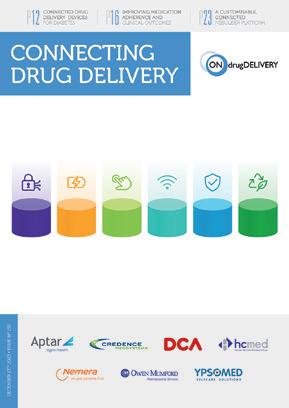

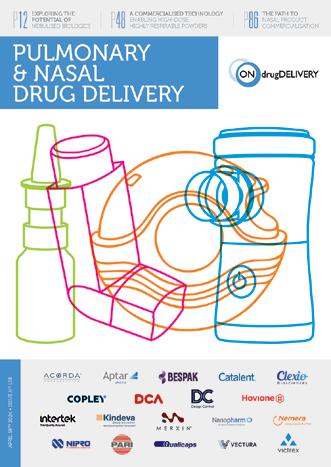


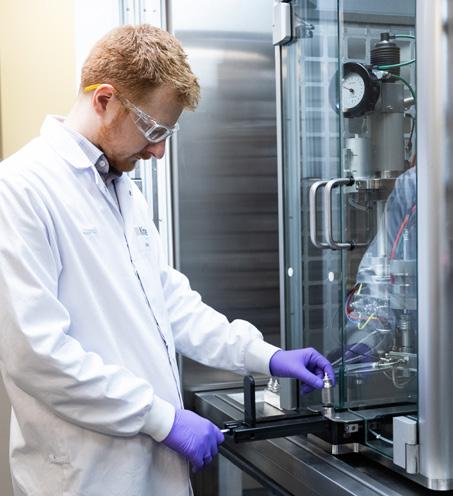

In this article, Timothy Noakes, PhD, Technical Associate, Sheryl Johnson, Pharma Growth & Technology Manager, and Richard Greenhough, PhD, Technical Sales & Business Development Manager, all at Koura, discuss the status of the current move from high-global-warming-potential propellants for pressurised metered dose inhalers to more sustainable alternatives.
The pressurised metered dose inhaler (pMDI) has been a major respiratory delivery method since its introduction by Riker Laboratories in 1956 as a new dosage form for adrenaline (epinephrine) and isoproterenol (Figure 1).1 Since then, it has evolved to become arguably the most generic platform technology in the respiratory device space, capable of handling virtually all small molecule respiratory medications. To function and deliver a respirable mist, the technology relies on a number of critical components: the metering valve, the actuator and the propellant, (which acts as the drug carrier and can comprise up to 99.9% of the inhaled dose). A successful pMDI propellant must possess several attributes in addition to a low boiling
point (typically -30°C to -15°C), it must be relatively dense, inert (especially in people) and have suitable solvent power. This is not an easy combination of properties to achieve, which is why there is near-universal use of partially fluorinated molecules to fulfil this duty.
Between 1956 and 1995, this was achieved with the use of chlorofluorocarbons (CFCs), after which a transition to the current hydrofluoroalkane (HFA) propellants, HFA-134a and HFA-227ea, was initiated. Now the industry is looking at a further change to HFA-152a and HFO-1234ze(E), as summarised in Table 1. Both changes were driven by the introduction of regulations controlling emissions to the environment, addressing ozone depletion and, more recently, combatting global warming.
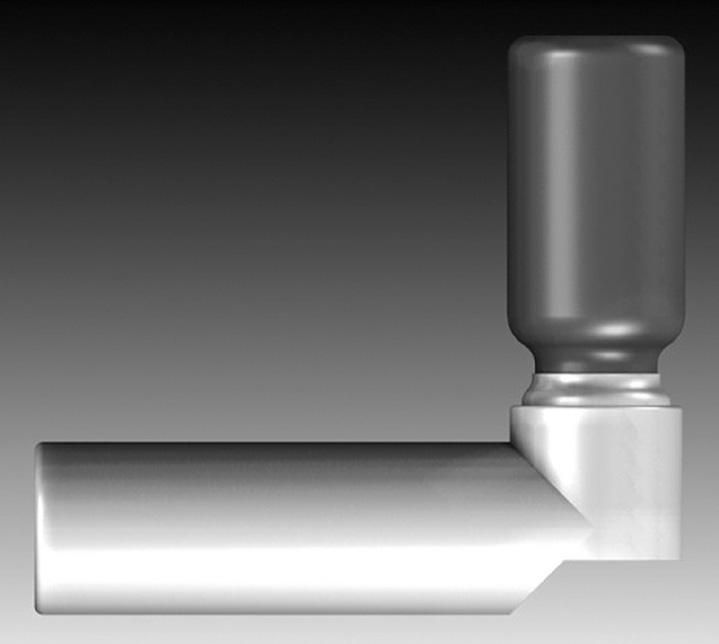

Dr Timothy Noakes
Technical Associate
T: +44 1928 51 8889
E: tim.noakes@orbia.com

Sheryl Johnson
Pharma Growth & Technology Manager
T: +44 1928 51 8829
E: sheryl.johnson@orbia.com

Dr Richard Greenhough
Technical Sales & Business Development Manager
T: +44 7990 567444
E: richard.greenhough@orbia.com
Koura, Orbia Fluor & Energy Materials 950 Winter Street Waltham MA 02451
United States
www.kouraglobal.com
ozone depletion potential.
Although driven by the need to reduce atmospheric ozone depletion (the original Montreal Protocol phased out ozone depleting molecules such as CFCs),4 the introduction of the HFA propellants also resulted in a nearly tenfold reduction in the global warming potential (GWP) associated with pMDI usage. This is due to HFA-134a and HFA-227ea possessing a significantly lower GWP than CFCs (1,430 and 3,220 versus 10,900 for CFC-12 GWP 100-year).5
However, the GWP of these two HFAs is still considerable, and their use has come under regulatory scrutiny in turn. The Kigali Amendment to the Montreal Protocol (2016) introduced measures to reduce the global warming impact of fluorocarbon gases.6 This is because a key component of the effort to slow climate change involves reductions in emissions of special-use greenhouse gases, which, though emitted to a far lesser extent than CO2, are also much more potent in terms of radiative forcing.
Reducing emissions of high-GWP fluorocarbon gases used as propellants is a critical part of this strategy. Unlike CO2 emissions, which are an inherent cost of the combustion of fossil fuels, there is the potential for drop-in replacements of high-GWP fluorocarbons with low-GWP alternatives – a relatively easy solution that is not available to controlling emissions of CO2.
Consequently, several regulatory bodies around the world have been restricting the use of high-GWP fluorocarbons. These efforts include the F-gas regulation in the EU,7 regulations adopted by certain US States8 and US federal requirements9 on the introduction of new alternatives in such applications.
While regulation that addresses manmade global warming contributions has gained most attention, another set of regulatory requirements relating to the escape of classes of fluorocarbons known as per- and poly-fluoroalkyl substances (PFASs) into the environment has been in development. These were originally targeted at substances such as polyfluoroalkanes, including perfluorooctyl bromide. The most advanced discussion is in the EU, where the definition of a PFAS has been substantially expanded and now includes some propellant molecules. However, HFA-152a, a potential low-GWP propellant for pMDIs, is not a PFAS or a PFAS precursor, so has a unique and essential role in meeting the EU’s carbon footprint target and other environmental targets. A consultation period on the draft regulation has attracted over 5,000 responses, and a process of review is now underway.10
It is perhaps worth noting that, while 1234ze(E), HFA-134a and HFA-227ea fall within this very broad structural PFAS definition, these fluorocarbon gases are
distinctly different chemicals from the longer chain, higher molecular weight chemicals that are currently under increasing regulatory pressure by PFAS regulation. Unlike the PFAS chemicals of concern, gases such as HFA-134a have short biological half-lives in the order of minutes or hours rather than months or years.11 This eliminates the potential for bioaccumulation, particularly in the protein-rich tissues of fish or humans, which is one of the significant concerns about PFASs. This behaviour makes them more analogous to modern fluorinated anaesthetics, such as sevoflurane or desflurane, that are similarly rapidly eliminated from the body.
The new propellants were carefully chosen to comply with the projected trajectory of regulations. Whilst both HFA–152a and HFO–1234ze(E) still contain some fluorine to provide access to those key physical properties, they have a much lower environmental impact, primarily due to their shorter atmospheric lifetimes.
However, before these potential medical propellants could be taken into full development, a critical investigation into whether their toxicology supported their use as inhalation propellants had to be undertaken. Extensive non-clinical toxicology studies, which are now nearing completion, have been underway for several years.12,13
“Unlike CO2 emissions, which are an inherent cost of the combustion of fossil fuels, there is the potential for drop-in replacements of high-GWP fluorocarbons with low-GWP alternatives – a relatively easy solution that is not available to controlling emissions
of CO2.”
So, attention now moves to bringing low-GWP pMDIs to market. There are questions as to whether, in a broader environmental perspective, they are competitive with alternative technologies, such as dry powder inhalers (DPIs) and soft mist inhalers, whether the increased flammability can be accommodated in a good manufacturing practices (GMP) facility and if metering valves can be easily adapted to suit them.
Ancillary Materials
While it is tempting to focus purely on the headline GWP figures for the propellants, it is important to take more comprehensive methods into account, incorporating the total environmental impact of a pMDI –particularly when comparing propellants and benchmarking them against propellant-free technologies, such as DPIs. Lifecycle analysis (LCA) is a recognised methodology for assessing the cradle-tograve environmental impacts associated with a technology. For a pMDI, this should include routes of manufacture for the propellant and device components, patient use and the fate of the inhaler at end-oflife, including the potential for component recycling. The only exception is with respect to API production, as this is considered independent of the delivery platform. The full scope of the lifecycle stages accounted for as part of the LCA methodology is defined in Figure 2.
LCA studies compliant with current environmental management assessment guidelines, such as ISO 14040 and 14044, have been completed for both low-GWP propellants and compared with results for the current medical propellant, HFA-134a. Transition of a pMDI from HFA-134a to HFA-152a has been shown to result in
“Alternatively,
a 90%–92% reduction in environmental impact14 and, when focusing solely on a triple-therapy pMDI (budesonide/ glycopyrronium/formoterol fumarate dihydrate), HFA 1234ze(E) resulted in an overall reduction of 85%.15
Alternatively, transitioning from a current pMDI to a DPI can account for a reduction in around 96%,14 highlighting that, irrespective of the individual GWP values, a pMDI device containing either will have an environmental impact equivalent to that of a typical DPI. To reduce the environmental impact of such inhalers further, be it a DPI or a pMDI, widespread adherence and implementation of device recycling schemes needs to be considered – something that does not exist today.
The prevalence of inhaler prescriptions for asthma and chronic obstructive pulmonary disorder varies significantly by region. For example, 70% of prescriptions in the UK are for pMDIs, whereas in Sweden this figure is only 13%.16 Nevertheless, all inhalers contain plastics, metals and, in the case of pMDIs, HFAs – with the environmental impact well documented.
transitioning from a current pMDI to a DPI can account for a reduction in around 96%, highlighting that, irrespective of the individual GWP values, a pMDI device containing either will have an environmental impact equivalent to that of a typical DPI.”
In England a small portion of used inhalers are returned to pharmacies. However, it is thought that over 90% are disposed of in household waste.17 Both GSK and Teva have previously funded inhaler recycling schemes,18,19 returning used inhalers to community pharmacy dropoff points. Both schemes had low uptake, however, thought to be due to a lack of public awareness.
Recently, Chiesi trialled “Take Air” in England.20 Remaining propellant from pMDIs was recovered and used in the refrigeration and air conditioning industries, as well as incinerated to provide energy from the waste. Parts were recycled where possible. Around 15,000 pMDIs were returned, which represented 77% of the total inhalers. This saved the equivalent of an estimated 119.3 tonnes of CO2 equivalent emissions into the atmosphere.
The challenge with all schemes, whether by GSK, Teva or Chiesi, is the scalability of such recycling schemes. Further success will rely on scheme publicity, pharmacy and community participation and, undoubtedly, an investment plan put forward by pharmaceutical companies.
Unlike HFA-134a or HFA-227ea, low-GWP propellants tend to bring the system closer to flammability. In the case of 1234ze(E) it hovers on the border –non-flammable at room temperature, flammable above 30°C. HFA-152a is flammable in air within the concentration range of 3.7%–18.0%. However, computational fluid dynamic modelling has shown that the potential for ignition
“From a pMDI manufacturing perspective, the technology and safety standards for the safe filling, handling and transportation of aerosol products using flammable propellants, including hydrocarbons and HFA152a, already exist.”
of HFA-152a from a pMDI either during use or due to accidental release is negligible.21 This is further confirmed by the fact that many current HFA-134a-based pMDI formulations are actually flammable with no apparent adverse effect on patient safety.
From a pMDI manufacturing perspective, the technology and safety standards for the safe filling, handling and transportation of aerosol products using flammable propellants, including hydrocarbons and HFA-152a, already exist. Indeed, manufacturers of specialist pMDI filling equipment are ready to supply flameproof versions. In addition, a recently released guide is available, authored by three companies in the pMDI
5. Pressure-fill propellant Traditional two stage filling
1. Make ethanolic concentrate of drug in unpressurised mixing vessel
2. Open can filling of concentrate
3. Place valve
4. Crimp valve
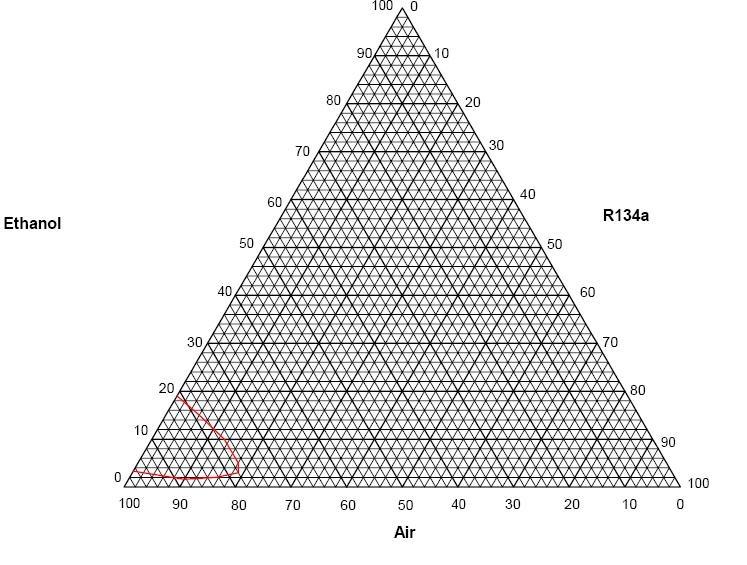

key aspects of safe pMDI manufacturing using flammable propellants.22 It must be stressed that this is standard, very well-known and understood aerosol filling technology.
Excipients can also change the picture. It is incorrect to assume that if a nonflammable propellant is used, then mixtures containing it and other excipients, both in the manufacturing vessel and in the aerosol, will also be non-flammable. It has been shown that the addition of
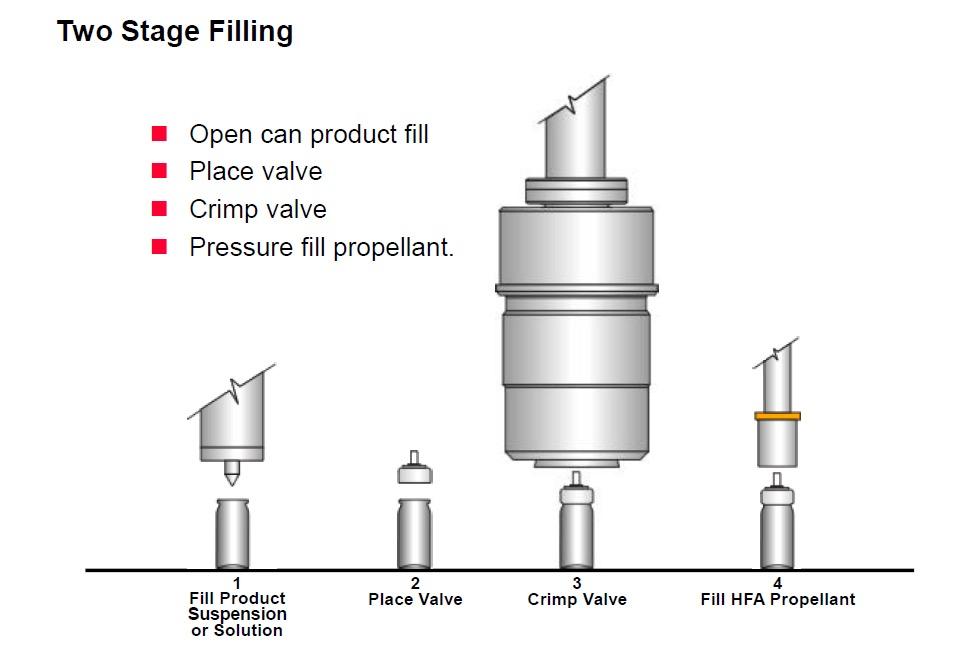
air mixture, will produce a vapour mixture that can be flammable when mixed with air. A flammability diagram demonstrates this (Figure 3).
As can be seen, more than 4.8% ethanol w/w in solution in HFA-134a can produce a flammable vapour cloud when mixed with air at room temperature. This is quite a modest amount, as pMDI formulations that use ethanol typically have 5%–15% w/w added. This means that, if such mixtures are created in the filling process, they must be risk assessed, contained and handled as compressed flammable gases.

In light of this, care must be taken when formulation strategies involving ethanol are considered with any medical propellant, in case the mixture flammability boundary is unknowingly crossed, and the formulation becomes flammable, as the manufacturing installation may not have been risk assessed for this eventuality. HFA-152a is well understood and the 4.8% ethanol limit for HFA-134a is known but, at present, there is no relevant data in the public domain regarding HFA-227ea or HFO1234ze(E). This is a concern when pressurefill technology is used, as the contents of a pressurised mixing vessel could become flammable if there was some form of escape.
While the cost of building a greenfield pMDI filling facility can increase only marginally if it is specified as flameproof from the start, retrofitting
existing facilities to become flameproof can be costly. A very useful way of minimising this cost is selecting the right pMDI filling strategy. Traditionally, there are a number of strategies and variants but, for simplicity, these can be categorised into two – two-stage filling (Figure 4) and pressure filling (Figure 5).
1. Make concentrate mix of propellant, drug and excipients in pressurised mixing vessel
The pressure filling option is arguably the most popular with today’s propellants, with two-stage filling being seen as a little limited and unable to fill certain drugs. However, when contemplating a retrofit to handle either flammable propellant or formulations, pressure filling tends to require much more extensive building and equipment alterations than two-stage filling, due to the need for safe accommodation of the pressurised mixing vessel.
2. Place valve on empty can
3. Crimp valve (with vacuum)
4. Pressure -fill product suspension
5. Optional flush with additional propellant
Two alternative recent innovations now provide a variant of two-stage filling that works for all required active ingredients via the form of a tablet or powder (Figure 6). The alternate enabling technologies are the use of tablets23 – loose compressed pellets of drug and lactose – or direct dry drug powder dosing into an open canister.24 With the availability of regular ethanol carrier-based two-stage
1. Make concentrate mix of propellant, drug and excipients in pressurised mixing vessel
2. Place valve on empty can
3. Crimp valve (with vacuum)
4. Pressure-fill product suspension
5. Optional flush with additional propellant

2

filling plus these alternatives, two-stage filling may become the preferred filling strategy for retrofitting pMDI installations to low-GWP propellants, at a significantly reduced capital cost.
“The metering valve, a critical component, requires meticulous fine tuning, which must follow the path of evolution of the formulation.”
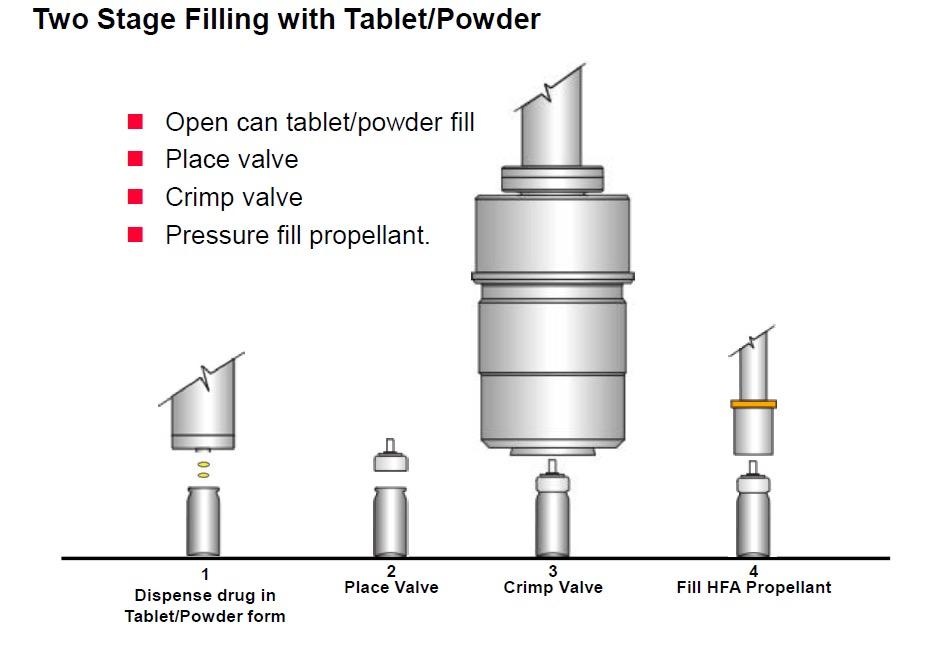
1. Dispense drug as tablet or powder to open can
2. Place valve
3. Crimp valve
4. Fill propellant
Changing the propellant in a pMDI is a challenging process, which needs to take a variety of different technical aspects into consideration. Figure 7 illustrates these aspects, linked to the development, use and commercialisation of a pMDI. The metering valve, a critical component, requires meticulous fine tuning, which must follow the path of evolution of the formulation. This adjustment considers the valve’s sub-components and other crucial elements of the container closure system, as well as the intended manufacturing processes. Aptar Pharma (IL, US), Bespak (Holmes Chapel, UK) and RxPack (Oggiono, Italy) are all major pMDI component manufacturers. These three major companies have a valve offering and all have contributed to investigating how the transition to low-GWP propellants affects performance.

Aptar Pharma, being a drug delivery solutions manufacturer, has played a vital role in the investigation of new materials compatible with the shift towards low-GWP pMDIs. This ensures the availability of devices that work seamlessly with the leading lowGWP propellants – HFA-152a and HFO-1234ze(E). Notably, materials like cyclo-olefin copolymer and ethylene propylene diene monomer rubbers have proven effective as static and dynamic seals in valves, respectively. These rubbers
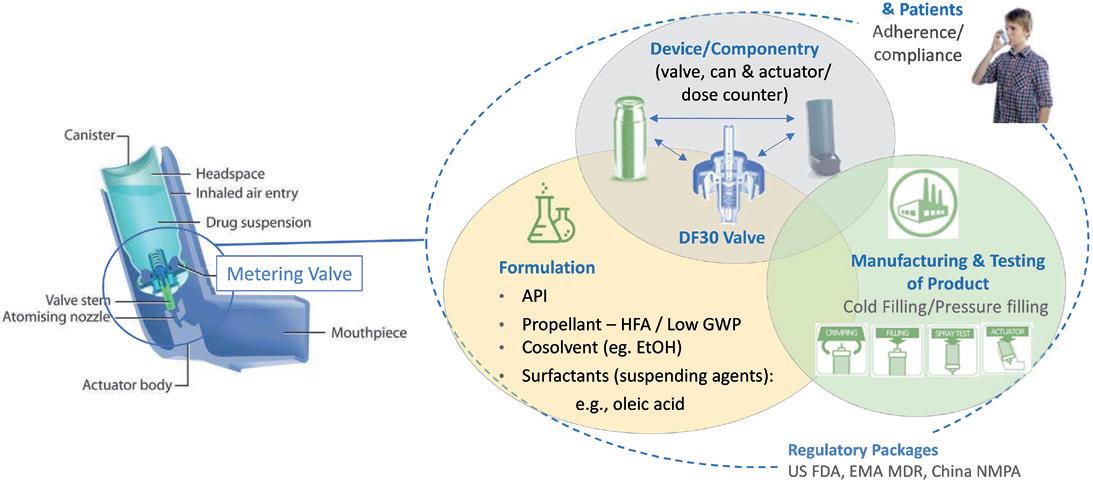
are compatible with both types of propellants, including formulations containing ethanol. In addition, minimising extractables and leachables from components has been a key factor in the selection of new materials.
Adjustments to the metering chamber volume may also be necessary to ensure the delivery of an equivalent dose compared with existing pMDI products. Aptar Pharma has refined its metering chamber design for greater flexibility and robustness, enhancing the support of the dynamic elastomers (Figure 7).
Undoubtedly, the pharmaceutical industry is in the early stages of the transition to lowGWP medical propellants and recognises that there is a possibility that not all existing pMDI products will make the transition successfully, be it for practical or economic reasons. Nevertheless, the transition to a new low-GWP propellant system is happening and could help to invigorate the development of new products or make some products, previously discounted for pMDI use due to environmental factors, a more viable option.
A select number of companies have already announced their intentions to make pMDI products using new low-GWP propellants, which are expected to enter the market from 2025. Given the timelines associated with product development and regulatory approval, as well as further anticipated changes in the environmental
regulation, it does seem reasonable that by 2030–2035, a large proportion of the pMDI products in current regulated markets will have completed the transition.
Koura, Orbia’s Fluor & Energy Materials business, is a global leader in the development, manufacture and supply of fluoroproducts that play a fundamental role in enhancing everyday lives and shortening the path to a sustainable, circular economy. Backed by over 35 years of experience, Koura’s products are used in a vast range of applications, including electric vehicles and energy storage, urban and rural infrastructure, indoor climate management, food and medicine refrigeration, and treating respiratory conditions through the development of healthy and innovative low-GWP propellants for pMDIs. Koura has 1,600 employees and 13 manufacturing facilities worldwide, serving 60 countries through a global sales and distribution network.
1. Stein SW, Thiel CG, “The History of Therapeutic Aerosols: A Chronological Review”. J Aerosol Med Pulm Drug Deliv, 2017, Vol 30(1), pp 20–41.
2. McCulloch A, “Determination of Comparative HCFC and HFC Emission Profiles for the Foam and Refrigeration Sectors until 2015 –
PART 3: Total Emissions and Global Atmospheric Concentrations”. US Environmental Protection Agency, 2006.
3. “The environmental alternative to traditional refrigerants”. Honeywell, 2012.
4. “About Montreal Protocol”. Web Page, UN Environment Programme, Accessed Apr 2024.
5. “Global Warming Potential Values”. Greenhouse Gas Protocol, 2016.
6. “Introduction to the Kigali Amendment”. OzonAction, 2017.
7. “About F-gases”. Web Page, European Commission, Accessed Apr 2024.
8. “GHGs Descriptions & Sources in California”. Web Page, California Air Resources Board, Accessed Apr 2024.
9. “American Innovation and Manufacturing Act of 2020”. US Code, Title 42, pp 7383–7392.
10. “Registry of restriction intentions until outcome”. Web Page, European Chemicals Agency, Accessed Apr 2042.
11. Emmen HH et al, “Human safety and pharmacokinetics of the CFC alternative propellants HFC 134a (1,1,1,2-tetrafluoroethane) and HFC 227 (1,1,1,2,3,3, 3-heptafluoropropane) following whole-body exposure”. Regul Toxicol Pharmacol, 2000, Vol 32(1), pp 22–35.
12. Mohar I et al, “Overview of the Nonclinical Safety Program for
1,1-Difluoroethane (HFA-152a) as a Low Global Warming Potential Metered Dose Inhaler Propellant”. Poster presented at DDL 2023, Dec 2023.
13. “SOLSTICE® AIR HFO-1234ze(E), cGMP”. Product pamphlet, Honeywell, 2022.
14. Jeswani H, Corr S, Azapagic A, “Reducing carbon footprints of metered dose inhalers”. Inhalation, Dec 2017.
15. Hargreaves C et al, “S60 A new medical propellant HFO-1234ze(E): reducing the environmental impact of inhaled medicines”. Thorax, 2022, Vol 77, pp A38–A39.
16. Janson C et al, “Carbon footprint impact of the choice of inhalers for asthma and COPD”. Thorax, 2020,
Vol 75(1), pp 82–84.
17. Sivarajasingam V, “Understanding patients’ knowledge of inhaler recycling”. BJGP Life, Oct 2021.
18. “GlaxoSmithKline ‘complete the cycle’ Inhaler Recycling and Recovery Scheme now accessible UK-wide”. Nursing Times, Feb 2013.
19. “We’re putting ESG at the heart of everything we do as a business”. Web Page, Teva Ireland, Accessed Apr 2024.
20. Murphy A et al, “Understanding the feasibility and environmental effectiveness of a pilot postal inhaler recovery and recycling scheme”.
NPJ Prim Care Respir Med, 2023, Vol 33(1), Article 5.
21. “Risk of flame from HFA-152a used in metered dose inhalers
assessed by CFD modeling and fault tree analysis”. Prepared for Corr S, Mexichem Fluor, Oct 17, 2016 (revised Mar 4, 2020). Copy obtainable from Koura.
22. “Zephex 152a - Safe Handling Guide for pMDI Manufacturers (Issue 1)”. Pamasol, Koura, and Recipharm, 2023. Obtainable from https://forms. office.com/e/iZKdZKuhzZ.
23. Taylor G, Warren S, Tran C, “Pressurised metered dose inhalers and method of manufacture”. Patent WO2015121653A1, 2015.
24. Johnson S et al, “Assessing the adaptability of bench scale dry powder technology for filling of an pMDI can with a high fill weight API”. Poster presented at DDL 2022, Dec 2022.
Timothy Noakes, PhD, Technical Associate at Koura, joined ICI in 1975 as an organic fluorine chemist. Since then Dr Noakes has worked in a wide variety of fields, including laser chemistry, crop protection, electrostatic spraying and, for the last 33 years, the science of pMDI propellants. He has assisted many pMDI companies around the world in developing their offerings and has gained a wide knowledge of the strengths and weaknesses of the current technology base. Dr Noakes is now focused not only on continuing to develop technical support for existing pMDI formulations and technologies, but also on the introduction of the new, low-carbon alternative propellant, HFA-152a.
Sheryl Johnson is Pharma Growth & Technology Manager at Koura. She is Head of Production for Koura’s GMP facility at Thornton Science Park (UK) and leads a team of chemists supporting the pharma industry through the transition from Koura’s current propellants to their new low-GWP propellant, HFA-152a. Ms Johnson has 16 years’ experience in research-based process chemistry and process development, recently specialising in leading formulation development and research projects dedicated purely to HFA-152a. She is a Chartered Chemist and Member of the Royal Society of Chemistry with a masters degree in Organic Chemistry from The University of Hull (UK).
Richard Greenhough, PhD, is Technical Sales and Business Development Manager at Koura. He is responsible for the global technical business development activities for Koura’s Zephex® pharmaceutical propellants. He also acts as a product specialist, both internally within Koura and to its global customer network. With a PhD in Organic Chemistry, as well as broader pharmaceutical experience, Dr Greenhough has over 5 years’ industry experience in the field of excipient supply and services for the inhalation industry.




In this article, Su Osorio, Associate Director of Design Strategy, Stephanie Mou, PhD, Pharma Commercial Lead, and Charlie Dean, Head of Sustainable Medical Technology, all of Cambridge Consultants, explore the delicate balance between patient and planet centricity and propose a user- and planet-centric approach for the development of sustainable medical devices.
The landscape of medical devices is rapidly evolving, driven by a dual focus on patient centricity and sustainability. Ensuring the usability, safety and adaptability of medical devices to real-world use scenarios is a must. At the same time, it is becoming increasingly urgent to consider the environmental impact of the device throughout its full lifecycle. The aim is to maximise benefit to patients today, while considering the future.
This article explores the delicate balance between patient and planet centricity. It proposes a user- and planet-centric approach to developing valuable and sustainable medical devices by marrying user-centred design and sustainability best practices, applied by a multidisciplinary team. This blended methodology supports better decision making rooted in user insight and informed by environmental impact. It generates market differentiation by offering concrete added value for the users with seamless sustainability.
Patient centricity places the user at the heart of solution design.1 The goal is to create medical solutions that are adopted, used consistently and correctly, and deliver the intended patient outcomes. To achieve this, design decisions are centred around user experiences. With the push for patientfriendly and effective self-care medical solutions for home use, the significance of patient centricity continues to grow.
The path to a healthier and greener future involves advancement in both patient centricity and environmental stewardship. Responsible pharmaceutical companies
“Responsible pharmaceutical companies must consider not only the patient outcomes but also the environmental impact of their medical devices.”
must consider not only the patient outcomes but also the environmental impact of their medical devices. As pharma embraces the challenge of balancing patient and planet centricity, this article outlines an approach to the development of inherently user-focused and sustainable medical devices.
Organisations often struggle with the challenge of designing sustainable products without compromising user value and outcomes. They launch products that fail to deliver added value compared with alternatives, assuming sustainability will stand as a differentiator. The adoption of these products is limited, and users usually revert to alternatives following disappointing experiences with “sustainable” options.
In healthcare, the gap between user outcomes and environmental impact is even more pronounced. The value of a medical product lies in the clinical outcome it delivers. Sustainability is a desirable attribute rather than a differentiator. This poses the question: “How can we address sustainability in an impactful way while maintaining a valuable medical solution, thereby increasing the likelihood of adoption compared with alternatives in the market?”

Su Osorio
Associate Director of Design Strategy
T: +44 7989 442925
E: su.osorio@ cambridgeconsultants.com

Dr Stephanie Mou
Pharma Commercial Lead
T: +44 7973 972783
E: stephanie.mou@ cambridgeconsultants.com

Charlie Dean
Head of Sustainable Medical Technology
T: +44 7811 034694
E: charlie.dean@ cambridgeconsultants.com
Cambridge Consultants Ltd
29 Cambridge Science Park
Milton Road
Milton Cambridge
CB4 0DW
United Kingdom
www.cambridgeconsultants.com
This article illustrates an approach to the patient- and planet-centric design of medical devices, applied to a conceptual body-worn insulin injector.2 Drug-device combination products play a pivotal role in healthcare by administering consistent and precise medication dosing, which empowers patients requiring regular injections to carry on with daily activities. User centricity is particularly relevant for devices such as these, typically handled by patients and their caregivers.
In the following sections, the descriptor “user” over “patient” is adopted. To understand the people we design for, we must recognise that, beyond patients, they are multifaceted individuals with needs, emotions, values and attitudes. Moreover, other users besides patients must also be considered, such as caregivers and healthcare providers.
A user-centric and planet-centric approach requires a multidisciplinary team. There is a need for a deep understanding of the users, the medical device, sustainability and their intricate dynamics. This demands appropriate data inputs and a skilled team for the analysis. Only a multidisciplinary team will be well equipped to, together,
navigate the complexity of competing requirements and trade-off decisions arising from balancing user needs and sustainability considerations.
In this approach, a multidisciplinary team typically comprises sustainable medical technology engineers, human factors engineers, industrial designers and design strategists. Each discipline represents a perspective and leads a workstream. Together, they review existing medical devices, align on opportunities for redesign and manage trade-offs to reach better patient and planet outcomes in a future device that they co-create.
This approach calls for two research questions – one focused on the user, the other on the planet. Human factors engineers explore the question: “How is the user experience of the medical device?” They perform a task analysis using the PCA (perception, cognition, action) framework and investigate common usage errors through a review of publicly available resources, such as the MAUDE database,3 scientific literature and patient forums, gathering insight into the user, their experience and usability.
Sustainable medical technology engineers investigate the question: “What are the environmental impacts at each step of the user journey?” They conduct a lifecycle assessment (LCA) to identify areas that present the most significant opportunities from a sustainability standpoint.2 By identifying the materials, weights, manufacturing, distribution and disposal processes for a generic body-worn insulin injector and co-products, its impact can then be calculated with the SimaPro (Amersfoort, the Netherlands) LCA tool, using averaged impact data from the Ecoinvent (Zurich, Switzerland) database.
A user journey map (Figure 1) is a helpful way to synthesise knowledge of the user experience and the sustainability impact of the device. This is a user-centred design method that structures synthesised research information to facilitate its analysis within the context of the user experience.4 It outlines the key stages and activities of user interaction with the device. Underneath, it maps the “user emotional journey”, and displays the peaks and troughs of the “user gains” and “pain points”. An “ideal journey” shows everything
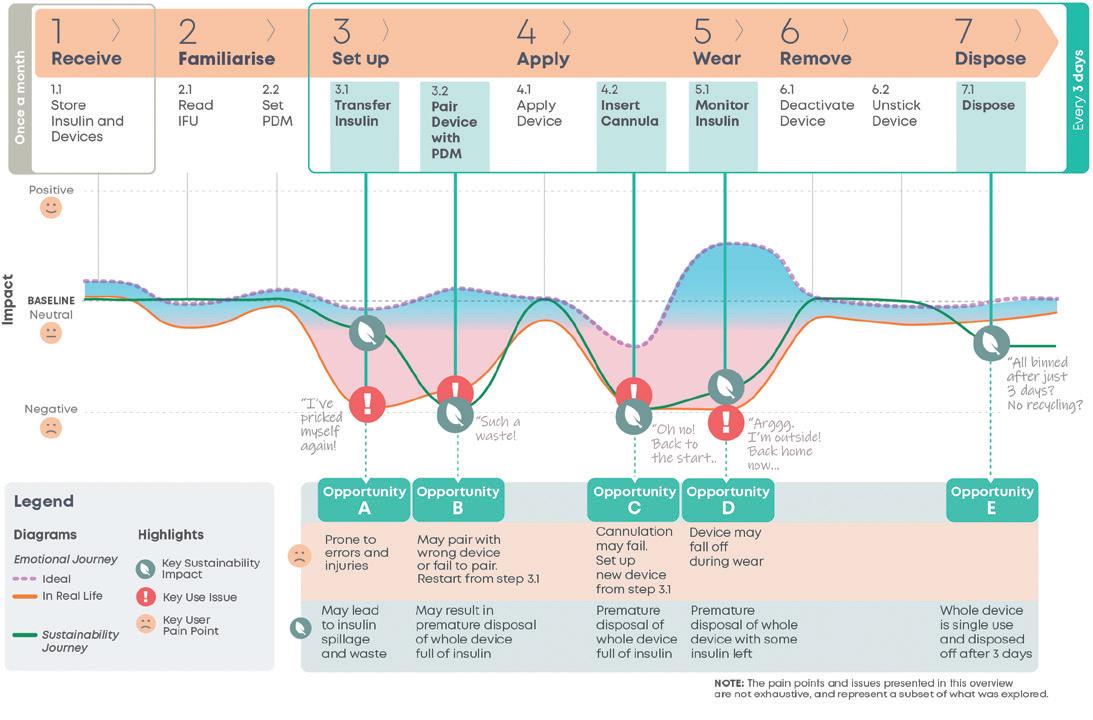
proceeding as expected, whereas a “reallife” journey reflects prevalent issues. The shaded region between them displays the spectrum of user experiences in between.
The “sustainability journey” is then overlaid, its peaks and troughs mapping the relative sustainability impact at each “reallife” journey step.
Opportunities for redesign exist where there is the greatest potential for improvement in both the user experience and the sustainability impact of the device. The current user journey map details the user experience and the relative
“Opportunities for redesign exist where there is the greatest potential for improvement in both the user experience and the sustainability impact of the device.”
sustainability impact of the current device over its use steps, which enables the identification of these overlapping areas of potential. This analysis has highlighted five key opportunity areas.
Insulin transfer is prone to user errors and injuries, spillage and wastage. While insulin wastage was found to be negligible from the LCA using pharmaceutical company data, it is a strong “pain point”, as highlighted by the significant dip in the emotional journey at this step (Figure 1, Step 3.1).
A common issue is the integrated personalised diabetes management (PDM) pairing with the wrong device or failing to pair (Figure 1, Step 3.2). If pairing cannot be completed, the user disposes of the device full of insulin and restarts setup with a new device from Step 3.1, Transfer Insulin. This is time consuming and upsetting for the user. The premature disposal of the device also has a negative environmental impact.
Cannula insertion failure is the most common issue in the MAUDE database
(Figure 1, Step 4.2). It requires setting up a new device from Step 3.1 Transfer Insulin. This will be quite frustrating for the user, who will need to restart again after being further along in their device application journey. From a sustainability point of view, Opportunity C is of equivalent impact to Opportunity B.
The device falling off while being worn (Figure 1, Step 5.1) is the second most common issue in the MAUDE database. The user must then dispose of the device and set up a new one. This often occurs during activity, in settings where it is less convenient to set and apply a new device. Opportunity D is of equivalent environmental impact to Opportunity B and C, or slightly better if the fault happens closer to the end of life of the device.
Every three days, the device reaches its end of life and is disposed of. While not a particularly painful pain point for users, more for the environment, patient forums present enquires from users about how to extend the lifetime of their devices. Those enquiries highlighted this as another opportunity for redesign.
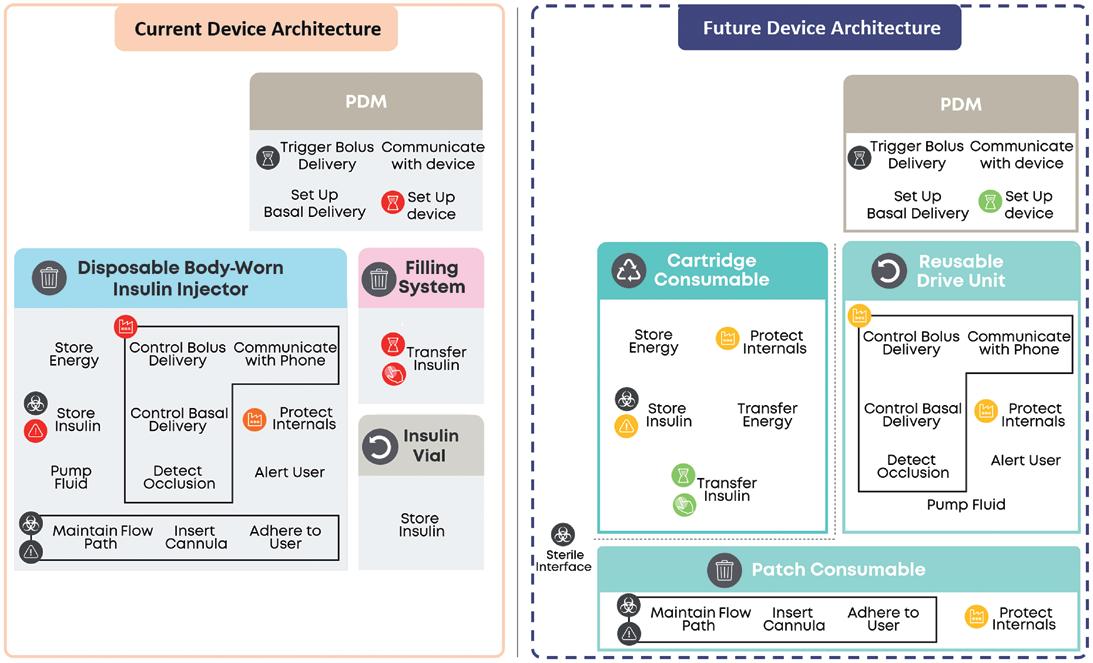
Opportunities B, C and D show high potential to improve both user experience and device sustainability and are thus prioritised. Furthermore, users are creating and sharing workarounds for reusing insulin from failed devices. They seem to perceive the most value to be in the insulin itself and the device just as a therapy enabler. While insulin waste has negligible sustainability impact, these workarounds signpost a strong pain point. Thus, the possibility of safely and easily reusing insulin from failed devices should also be explored.
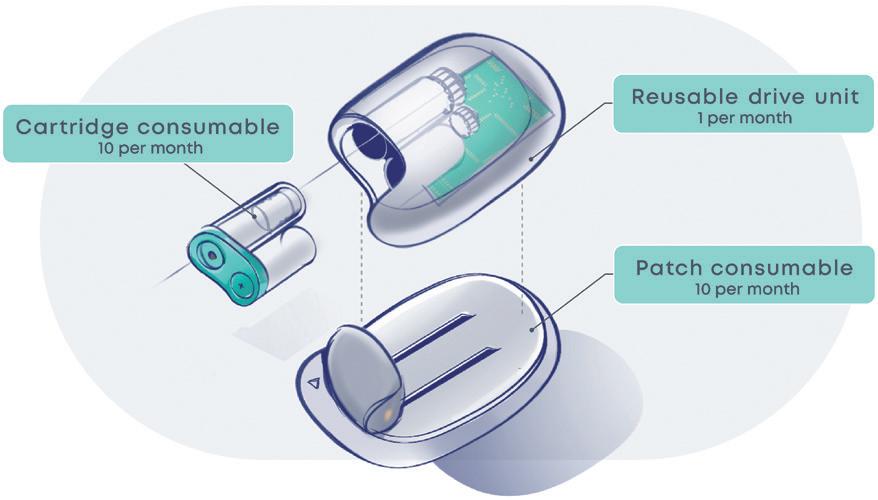
A proposed future device is to be developed around the key opportunities for redesign. First, the current device is decomposed into high-level, solution-agnostic functions. Then, functions are categorised according to environmental damage, failure rate, cost, sterility and time consumption. Finally, functions are allocated to logical subassemblies to minimise Pain Points and environmental damage (Figure 2).
The proposed future device (Figure 3) comprises three modules, assembled by the user to form a fully functional device. One module is reusable 10 times over a month, and two are consumables replaced every three days.
The Reusable Drive Unit contains the printed circuit board assembly (PCBA) as well as the insulin pump. The PCBA has an especially high environmental impact.
“The PCBA has an especially high environmental impact. By incorporating it in a reusable module, its impact is amortised and reduced considerably.”
By incorporating it in a reusable module, its impact is amortised and reduced considerably. Additionally, this reduces the pain point of pairing a new pump from occurring once every three days to once a month.
The cartridge consumable contains the prefilled insulin vial and batteries. The pain point of transferring insulin is eliminated by replacing this step with a simple clipping operation. Consequently, failures in other modules will not result in insulin wastage. Disposable batteries are opted for, as the LCA identified that batteries have a relatively low environmental impact, and this avoids additional charging infrastructure and user burden.

The patch consumable sticks to the patient and contains the cannulation and cartridge-piercing systems. These are the most common sources of failures. With a separate architecture, a failing patch can be replaced and a premature disposal of the whole device prevented.
To assess how the future device concept compares with the current device on user experience and sustainability impact, a future user journey map (Figure 4) is used. It projects the future user experience and sustainability impact of the proposed future device. By contrasting this with the current user journey map, the impact on the five key opportunity areas can be assessed.
A cartridge module prefilled with insulin that will be loaded into the drive unit (Figure 4, Step 3.2) eliminates the original pain point.
Pairing is now only required once a month (Figure 4, Step 3.1), reducing both the pain point frequency and the potential
number of devices prematurely disposed of due to pairing issues. Additionally, when pairing fails, only the drive unit needs replacing, as opposed to the whole device in the original solution.
In both cases, now only the patch module needs to be replaced (Figure 4, Steps 4.3, 5.1), reducing the sustainability impact of these failures. The user will now restart from “Apply Patch” (Figure 4, Step 4.1), reducing the time impact and task burden of this failure on the user, when compared with restarting from “Transfer Insulin” in the original device.
The drive unit houses the components with the highest environmental burden and is now used for a month (Figure 4,
Step 7.2). This single change effectively reduces impact across a range of categories, such as global warming, resource usage and damage to ecosystems, by up to 50%.
To enable a modular device, some tradeoffs need to be considered, with ongoing evaluation and refinement as the design detailing progresses. Overall, the changes described reduced the total time, effort and task burden of the user. The fiddly insulin transfer is replaced with clipping a cartridge. The failure-prone drive unit pairing and deactivation steps are now only occurring once a month. To enable these changes, three simple clipping and unclipping steps are added to apply and remove the device (Figure 4, Steps 4.2, 6.1, 6.2). Due to the technical constraints of the modular system, cannulation will likely be manual, which may create
“To enable a modular device, some trade-offs need to be considered, with ongoing evaluation and refinement as the design detailing progresses.”
“The successful implementation of a user-centric and planetcentric approach relies on the collaboration of a multidisciplinary team.”
more discomfort than the current automatic insertion. Other aspects for further evaluation in the detailed design include the impact on device size, the potential effect of module interface exposure to the environment and ways to reduce the potential waste of prefilled cartridges by patients with low insulin requirements.
A user- and planet-centric approach to medical device development encompasses a comprehensive review of the current medical device, followed by the identification of opportunity areas for impactful redesign. This process leads to the generation of innovative design concepts for a future device, with a dual focus on
enhancing patient value and minimising environmental impact. These are then integrated with a thorough evaluation of trade-offs, ensuring a balanced approach to the device development.
The successful implementation of a user-centric and planet-centric approach relies on the collaboration of a multidisciplinary team, guided by three key principles:
• Empathise deeply: Understand user needs and experience and identify where value can be added.1
• Leverage insights : Prioritise solving user experience aspects that are simultaneously the biggest pain points and most environmentally damaging.2
• Embed sustainability: While addressing the biggest pain points, strive for “invisible sustainability”, removing the burden of trade-off decisions from the user.
This approach provides a roadmap for balancing the needs of people and the planet. It guides pharma organisations through medical product development with empathy for their users and responsibility towards the planet. It delivers devices that stand out by providing a superior user experience and
Su Osorio is Associate Director for Design Strategy at Cambridge Consultants. She has over 15 years of experience in leading the innovation approach to design and launch new products, services and business models for clients across Europe, the US and Asia. Passionate about sustainability, she has led multiple design sprints to co-create sustainable solutions for private and government clients. She has taught and coached executives and corporates about design thinking and systems thinking applied to sustainability, and co-created sustainable design thinking tools and toolkits for corporates in collaboration with social and green sustainability non-governmental organisations and the UK government.
Stephanie Mou, PhD, has 15 years of commercial experience in the pharmaceutical sector. Her passion and expertise lie in helping organisations realise their goals and ambitions through innovative, sustainable and value-based solutions. As Pharma Commercial Lead at Cambridge Consultants, along with her scientific background and understanding of the healthcare ecosystem, she guides and facilitates complex cross-functional programmes with a strong focus on next-generation drug delivery systems.
Charlie Dean is the Head of Sustainable Medical Technology at Cambridge Consultants, specialising in integrating sustainable principles into novel medical device development. Mr Dean has experience across a broad range of drug delivery device products, combining analytical and design mechanical engineering expertise to optimise devices for high-volume production.
are inherently sustainable. These devices will be well positioned to become the preferred choice and, through them, leading pharma companies are assuming their part in fostering the adoption of more sustainable devices.
Paramesh Natarajan – Systems and Design Control, Cambridge Consultants
Pierre-Francois Gautier – Human Factors Engineering, Cambridge Consultants
Viviane Mosso – Medical Technology Design, Cambridge Consultants
Cambridge Consultants is a worldrenowned deep tech innovation company that develops breakthrough products and services, creates intellectual property and provides business consultancy in technology-critical issues. For more than 60 years, the company has helped its clients turn business opportunities into commercial successes. With more than 800 staff, including engineers, scientists, mathematicians and designers, and offices in Cambridge (UK), Boston, Tokyo and Singapore, Cambridge Consultants offers innovative solutions across a diverse range of industries and sectors, including healthcare, digital health, medical technology, life sciences, biotech, industrial and energy, consumer and retail, defence and security, and wireless communications and infrastructure.
1. Algorri M et al, “Patient-Centric Product Development: A Summary of Select Regulatory CMC and Device Considerations”. J Pharm Sci, 2023, Vol 112, pp 922–936.
2. Natarajan P, Bavar S, Dean C, “How Lifecycle Assessment Supports Insight-Driven Sustainable Design”. ONdrugDelivery, Issue 153 (Oct/Nov 2023), pp 16–19.
3. “MAUDE – Manufacturer and User Facility Device Experience”. US FDA, accessed Apr 2024.
4. Roesch N, Tiberius V, Kraus S, “Design thinking for innovation: context factors, process, and outcomes”. Eur J Innov Manag, 2023, Vol 26(7), pp 160–176.

Here, Marie-Christine Klein, PhD, Head of Development and Regulatory Affairs, and Christian Weyler, PhD, Project Manager Development and Regulatory Affairs, both at URSATEC, look at the evolution of the company’s sustainability strategy within its regulatory and economic framework – and what decarbonisation means for the pharmaceutical industry.
In 2004, the UN and Switzerland initiated “Who Cares Wins” to increase understanding and awareness of environmental, social and governance (ESG) topics. ESG considerations revolving around environment, social and corporate governance are at the centre of today’s sustainability efforts.
Although the overall intention is clear, the detailed analysis of what ESG means to different industries and companies and their individual impact is highly diverse. The global urge for decarbonisation is another part of the puzzle for a holistic approach of integrating sustainable thinking. Two hundred countries willing to take responsibility and to unite in the striving for limiting global warming to 1.5°C in the Paris Agreement of 2015 set limiting greenhouse gas (GHG) emissions as a primary goal. The Greenhouse Gas Protocol (GHGP) defines different scopes of GHG emissions, which become prominent vocabulary for companies engaging in emission analysis and reduction targets.
Scope 1 refers to the direct emissions from a company’s owned or controlled sources, such as on-site energy. Scope 2 describes indirect emissions from purchased or acquired energy, such as electricity, steam, heat or cooling. It is generated offsite and consumed by a company. Last, but not least, indirect emissions from purchased or acquired energy that is generated and consumed off-site constitutes Scope 3. Different industries are often characterised by the relative impacts of Scope 1, 2 and 3 emissions and their contributions
“Identifying decarbonisation potential and ultimately finding their green identity will be a prerequisite for any company’s success in the future.”
to individual carbon footprints. The health industry is characterised by an especially large relative portion of Scope 3 emissions. This is challenging because these emissions are both outside the direct control of a company and, at the same time, highly relevant.
The EU’s Green Deal concept of 2019 set the goal of becoming the first climate-neutral continent by 2050. It bundles initiatives and laws that will frame the economic industrial landscape of the next decades. Identifying decarbonisation potential and ultimately finding their green identity will be a prerequisite for any company’s success in the future. In line with this, reporting obligations focusing on sustainability matters are constantly growing. The non-financial reporting directive requires numerous large companies with more than 500 employees to include a non-financial statement in their consolidated management report. This directive, which has been in force since 2014, compels the companies concerned to report on sustainability issues. The new corporate sustainability

Head of Development & Regulatory Affairs
T: +49 6853 96199 0
E: sustainable@ursatec.com

Dr Christian Weyler Project Manager Development & Regulatory Affairs
T: +49 6853 96199 0 E: sustainable@ursatec.com
URSATEC GmbH Marpinger Weg 4 66636 Tholey Germany www.ursatec.com
reporting directive, as detailed by the European Sustainability Reporting Standards, extends these reporting requirements to smaller companies.
As a consequence, a steadily growing number of enterprises in the pharmaceutical industry have already started their journey into a more sustainable production chain. They are defining their ESG targets and actively taking part in initiatives such as the Pharmaceutical Supply Chain Initiative. Besides all the legal requirements, environmental sustainability, as well as visible proof thereof, is an increasingly relevant factor in product marketing. Customers are looking for sustainable products.
Having an established value chain in the pharmaceutical industry means that an extensively regulated environment prevents the swift adaptation of any part of the process. For example, ecologically friendly packaging solutions or exchange of raw materials to reprocessed sources is often hardly possible. Such modifications lead to an altered risk and safety profile, which impacts all stages of product development as well as regulatory compliance. Moreover, with the majority of the emissions anchored in Scope 3, a whole supply chain – ranging from the raw materials and the production and distribution through to consumer use and disposal – contributes to the carbon footprint. Hence, improvements are no low-hanging fruits. Additionally, what became clear during the covid-19 pandemic, was the vulnerability of global pharmaceutical supply chains. These do not have the same potential to transition to a circular economy and reverse supply chain networks as other industries in which purity is not as significant as in pharma.1
A study of the 20 largest pharmaceutical companies shows their major success in reducing Scope 1 and Scope 2 emissions by focusing on energy consumption and company-owned vehicles. Of course, reducing activities of Scope 3 is connected with a large variety of measures and, overall, this scope was reported less often. Of note, suppliers are encouraged to disclose their sustainability efforts (e.g. through EcoVadis) as the information is becoming increasingly important for the selection of suppliers. This is a part of the puzzle, which will affect a lot of participants of the supply chain.2 Moreover, a clear commitment to aligned reporting standards or initiatives

is common within the big players – for example, the GHGP Corporate Accounting and Reporting Standard and the Carbon Disclosure Project.2
What we learn from this overview is that reducing Scope 3 emissions will be the biggest challenge for most players in the pharmaceutical industry. A significant part of taking responsibility is to critically analyse what can be done in the current set-up and what are the next steps to reach the overall goal of reducing emissions as far and as soon as possible. As a prerequisite, knowledge of the whole supply chain and the correct assignment of the different emission categories is the first step. This systematic analysis will lead to quantification of CO2 emissions along the supply chain and, based on that, an individual reduction strategy can be established.
Figure 1 depicts the analysis of the supply chain emissions of the 3K system nasal spray by URSATEC. As expected, the largest CO2 footprint is ascribed to material sourcing and preprocessing activities. These activities encompass incoming raw materials, their incoming
“The ad hoc change of raw materials is not always a realistic goal, and even goods that can be produced from recycled materials require energy to be produced.”
logistics, including packaging materials and the distances that need to be overcome to reach the production site. Based on this, several conclusions can be drawn:
1. Scope 3 upstream emissions should be targeted to achieve emission reductions. As outlined above, the ad hoc change of raw materials is not always a realistic goal, and even goods that can be produced from recycled materials require energy to be produced. Also, the entire supply chain requires a substantial logistics effort. Hence, products cannot be “climate neutral” or “100% sustainable”.
2. To further attenuate the environmental impact of products, there are options to couple the production chain – which is inherently environmentally harmful – to compensation projects. Such compensation projects can be either local/regional or they can be set up to make a substantial difference in a remote part of the world. At first sight, planting anything from a few trees to an entire forest in the direct vicinity of the production site appears to be an ideal and very visible measure to account for the environmental impact of the production chain. However, such projects are not well suited to counterbalance large productions and their emissions.
3. Emissions caused by supply chain logistics can be limited by setting up the production as locally as possible. With a European (mainly Germanybased) partner network, URSATEC is in a position to start from a low level of carbon burden within the product carbon footprint.

4. To make the sustainability strategy (Figure 2) accessible, visible and understandable throughout 360° of the value chain, disclosing activities and taking part in initiatives is common practice. Moreover, in the near future, URSATEC will add the option of a financial contribution to certified climate protection projects to its product portfolio. This way, the customer can choose to contribute to further reducing the product carbon footprint (PCF). The goal, besides raising customer awareness, is to be a proactive partner within the supply chains in the pharmaceutical industry.
URSATEC GmbH was founded in 1993 to accomplish one mission: the establishment of preservative-free applications, based on its proprietary packaging systems in different application areas, primarily nasal, dermal, buccal and otological fields. Having sold almost 2 billion units within the last 30 years, URSATEC systems are widely established. URSATEC is
consistently expanding its business and offers full development service, dosage systems, primary packaging materials and filling services for OTC and Rx applications to the healthcare industry.
1. Bade C et al, “Sustainability in the pharmaceutical industry – An assessment of sustainability maturity and effects of sustainability measure implementation on supply chain security”. Corp Soc Resp Env Ma, 2024, Vol 3(1), pp 224–242.
2. Booth A et al, “Pharmaceutical Company Targets and Strategies to Address Climate Change: Content Analysis of Public Reports from 20 Pharmaceutical Companies”. Int J Environ Res Public Health, 2023, Vol 20(4), p 3206.
Marie-Christine Klein, PhD, is a biologist by training and joined URSATEC in 2019. She is head of the Development & Regulatory Affairs team, which focuses on innovative developments in combination with the URSATEC application technology. Dr Klein is also a founding member of the URSATEC multidisciplinary sustainability team, whose goal is the establishment of a systematic approach for URSATEC’s sustainability strategy.
Christian Weyler, PhD, joined URSATEC at the beginning of 2024, with a PhD in Chemistry. As part of the Development & Regulatory Affairs team, he brings experience in project management to realise customer projects dealing with challenges during all phases of developments. Another emphasis of his work at URSATEC lies within the sustainability team, dealing with reporting obligations, and disclosing efforts and strategies for emission reduction.


for preservative-free applications
We accompany our customers as a reliable and competent partner throughout the entire value chain of a product. Instead of coordinating various suppliers and contract development and manufacturing organizations, you have all the advantages of a single contact partner.
We provide innovative primary packaging materials and combine in-depth development with approval know-how and high-quality contract manufac-




Please
In this interview, Henryk Badack, Senior Vice-President Technical Services and Internal Project Management at Vetter Pharma International, shares insights into the current state of sustainability in the pharma and biotech industry, how sustainability commitments vary between organisations and what companies can do to develop sustainability strategies that will last.

Henryk Badack is Senior Vice-President Technical Services and Internal Project Management. In this role, he is responsible for the company’s internal, technical and infrastructure projects as well as the following departments: Plant and Site Development, Environmental Health Safety and Vetter Optimization Systems. Mr Badack has 20 years of experience in the pharmaceutical industry, having joined Vetter in 2003 as a Project Manager for validation and qualification projects. He later held various positions at Sandoz in 2007–2008, before returning to Vetter in 2009.
The pharma and biotech sector is experiencing a major shift towards longterm sustainability solutions by adopting more comprehensive strategies. Rightly so, as the global industry currently produces 55% more greenhouse gas emissions than the automotive industry, according to an article in the Journal of Cleaner Production 1 While many industry processes must remain unchanged to fulfil regulatory requirements and to maintain the high quality of medicines that patients around the world rely on, other areas can be adapted to reduce the industry’s overall
“No step is too small and, for a programme to last, it needs to fit the requirements of the company and its customers.”
carbon footprint. No step is too small and, for a programme to last, it needs to fit the requirements of the company and its customers. Only then can an organisation maintain its sustainability commitments and produce measurable results.
QWhat is the current state of sustainability within the pharma and biotech industry?
ADespite being a heavily regulated industry on track to sustainable production processes, pharma and biotech still emit high carbon emissions. But sustainability has become a priority for life sciences companies and for governments, which are implicating new requirements that businesses must adhere to. Companies that establish practical green strategies now will be better positioned to act in a responsible manner to avoid future risks, such as carbon taxes, and to remain competitive in attracting customers.
Life sciences companies based in Europe face the challenge of meeting EU climate goals, which include climate neutrality by 2050. This commitment to contribute to an economy with net zero greenhouse gas emissions may feel like a tall order but is achievable if proper consideration and dedication are present to shape sustainability strategies that align with business goals. It is important to note that the biopharma industry requires a process that uses a significant amount of energy to produce life-saving medications. High-energyconsumption cleanrooms, for example, need to be operated constantly to keep the quality level high and serve customer demands. But there are other areas where climate-safe practices can fit without risking adherence to regulatory requirements or reducing the quality level.
QHow do sustainability commitments vary between drug owners and CDMOs?
AFor pharma and biotech companies looking at Scope 1 or 2 emissions, which stem from owned or purchased sources, or for suppliers and outsourcing partners considering Scope 3 emissions, or those that fit within a customer’s larger value chain, it is paramount to find strategic methods for reducing climate impact that balance the three pillars of holistic sustainability: economic, ecological and social impacts.2
Many drug owners are actively searching for outsourcing partners that share their goals and commitments to sustainability. Beyond a need to meet EU climate goals, pharmaceutical service providers need to establish programmes that appeal to their target customers. In today’s climate, many customers not only desire but expect a fill-finish partner to prioritise ecofriendly initiatives. CDMOs need to further meet expectations that vary from customer to customer. When a service provider can effectively explain its comprehensive sustainability programme to customers, there is the potential added benefit of setting the standard for what the customer will also expect from other partners.
Outsourcing partners also need to consider the requirements of the Supply Chain Due Diligence Act.3 The Act itself requires that companies undertake a risk analysis to understand any potential environmental and human rights risks in their supply chain. Therefore, all customers


will expect adherence to this Act from any outsourcing partners they engage with.
Pharmaceutical service providers should consider developing a risk management system to support employee, supplier and customer relations that complies with those requirements.
QWhat can CDMOs do to develop sustainability strategies that last?
AThe development of a sustainability strategy must be just that: strategic. That said, step is too small. Especially in a business as calculated as pharma and biotech, service providers should begin by taking careful steps to act more sustainably and work up to a comprehensive and fully integrated programme. By developing methods for managing all initiatives, achievements and goals, it is much easier to remain consistent on the path to sustainability.
As mentioned previously, changes made within aseptic production areas may be limited, as regulatory requirements must be considered above all else. However, there are many other options for acting more sustainably. This may include enhancements such as:
• Moving to renewable energy at all sites, where applicable (Figure 1)
• Offering bicycle rentals to employees to reduce commuter emissions
• Adding electric vehicle (EV) charging stations to encourage employees to drive EVs (Figure 2)
• Covering the cost of public transportation for employees
• Supporting flexible work environments that limit the need for commuting
• Sourcing local products and services for on-site projects, from construction activities through to staff catering and dining
• Sustainability packaging options, e.g. all-paper packaging.
These are just a few examples of how to develop sustainable business practices that work for a company in the long term. From there, larger commitments, such as achieving carbon neutrality, can be considered.
“By developing methods for managing all initiatives, achievements and goals, it is much easier to remain consistent on the path to sustainability.”
Another valuable step is to create internal platforms in which open communication about successes and challenges in the sustainability journey can be discussed

and leveraged to improve processes for the future. Even better, get employees involved to make this a shared priority across the company, rather than a top-down initiative that may or may not gain widespread support. With this approach, all employees can bring in or share their ideas to optimise processes towards sustainability.
QHow does accountability play a role in sustainable practices?
ASustainability initiatives are only as valuable as the results they achieve. The United Nations’ (UN’s) Sustainable Development Goals (SDGs), for example, consider accountability as an integral component to effectively protect the planet.4 The UN considers self-accountability the responsibility of individuals, organisations and governments to report and hold themselves responsible for any consequences or results of their actions in pursuit of the SDGs.
An annual report is an excellent way to take accountability, measure and report on the results of climate-friendly programmes once they are underway. This may include measuring the number of efficiency projects completed, savings of kilowatt hours in electricity, use of renewable energy to power sites, savings of carbon dioxide or selfgenerated renewable energy. Other ways to take accountability may involve committing to external programmes that have set goals and hold participants to high standards.
For example, the UN Global Compact commits signatories to align and document corporate actions to its 10 defined principles, which focus on the enforcement and implementation of human and employee rights, environmental protection and the prevention of corruption. To date, only 308 pharma and biotech companies are involved, so there is room for significant growth in the future among those who are willing to submit annual updates on progress.
“An annual report is an excellent way to take accountability, measure and report on the results of climate-friendly programmes once they are underway.”
Another example is the Science Based Targets Initiative (SBTi) in which companies commit to achieve climate neutrality by 2050 based on a 1.5°C of global warming target goal. Involvement in the SBTi not only requires concrete steps to reach climate goals but also holds participants accountable for their commitments.
QHow should an organisation set about establishing sustainability initiatives?
AA team-wide approach is important when it comes to establishing a company’s sustainability programme. In today’s workplace climate, and especially as Gen Z joins the workforce, it is increasingly important to establish values authentic to a company that resonate with the talent pool. But it is important not to look at only one generation – the issue of sustainability must be shared by all generations. Sustainability is one key way to reach this audience and improve a company as a whole. In fact, 65% of today’s college students would not even apply for a job if the employer’s values did not align with theirs, according to a recent trends survey.5 Incorporating the team into the decision making behind a sustainability strategy positions a company well to support talent recruitment and retention, and gain widespread support.
It is crucial to invest time in developing a sustainability programme that fully aligns with an organisation’s corporate strategy, including optimising infrastructure, adopting environmentally friendly technologies and measuring meaningful impacts as a result. No sustainability strategy will ever be perfect or complete. There will always be more to accomplish. Treating sustainability as an attitude and not as a label, combined with motivation and a commitment to bettering the environment, are critical characteristics that are needed to start forming a sustainability mindset. From there, a viable programme will inevitably follow.
Vetter is a leading CDMO with headquarters in Ravensburg, Germany, and production facilities in Germany, Austria and the US. As a global player, the pharma service provider also has its own sales locations in the Asia-Pacific markets of Japan, China, South Korea and Singapore. Around the world, small and large renowned pharma and biotech companies rely on the decades of experience, high quality, modern
technologies, reliability and commitment of more than 6,300 Vetter employees. In close partnership with its customers, the Vetter team supplies patients all over the world with medicines, many of which are vital. The CDMO provides support from drug product development through clinical and commercial filling to a wide range of assembly and packaging services for vials, syringes and cartridges. With innovative solutions, Vetter develops prefilled drug delivery systems, together with its customers, to continuously improve patient safety, comfort and compliance. The company is a pioneer in the industry when it comes to sustainability, and acts as a socially and ethically responsible corporate citizen.
1. Belkhir L, Elmeligi A, “Carbon footprint of the global pharmaceutical industry and relative impact of its major players”. J Clean Prod, 2019, Vol 214, pp 185–194.
2. Philpott J, “Pharma’s path to Net Zero: Targeting Scope 3 emissions”. Pharm Technol, Nov 2023.
3. Weichbrodt J, Gerhold-Kempf T, “The German Supply Chain Due Diligence Act And The Chemical Industry”. Mayer Brown, 2023.
4. “Accountability”. RELX SDG Resource Centre, 2023, accessed Mar 2024.
5. Goldhacker M, “The Hybrid 4-Day Work Week: What New Grads Want From Employers”. A.Team, Apr 26, 2023.
Henryk Badack
Senior Vice-President Technical Services and Internal Project Management
T: +49 751 3700 0 E: info@vetter-pharma.com or infoUS@vetter-pharma.com
Vetter Pharma International GmbH Eywiesenstrasse 5 88212 Ravensburg Germany
www.vetter-pharma.com
In this article, Oli Gould, Sustainability Solutions Lead at Owen Mumford, explores the use of lifecycle assessment in product design for sustainability to impact the environment positively.
Designing more sustainable drug delivery devices is a complex process. Lifecycle assessment (LCA) is an essential methodology to evaluate the environmental impact of drug delivery devices throughout their entire lifecycle. This helps to identify areas for improvement and informs design decisions to minimise environmental footprint. According to ISO 14040, an LCA addresses the environmental aspects throughout a product’s lifecycle, as well as the potential impacts on the environment, from raw material acquisition, throughout production, use, end-of-life treatment, recycling and final disposal.1
Owen Mumford has developed a lifecycle-based eco-design tool in collaboration with a world-leading LCA consultancy, enabling the company to autonomously model the environmental impact of new product concepts, from raw material extraction to disposal. Owen Mumford builds various scenarios in the tool to assess different product concepts and configurations, including material choices, component weights, packaging and efficiency, transportation, material supply and manufacturing location, and various end-of-life scenarios. Importantly, the tool is designed to be easily used by personnel who are not LCA experts, so that they can compare the environmental impacts of different scenarios. The tool also allows for easy communication of the results within the company to drive collaborative and science-based decision making.
The key reason for such cross-department collaborations is that they enable eco-design to be included in early decision making – comparing several scenarios at the same time. Scenario
“Scenario comparison is critical because of the interaction and influence between different aspects of sustainability.”
comparison is critical because of the interaction and influence between different aspects of sustainability. Improving one aspect may well degrade another. Often, it is not crystal clear where the highest impacts come from, especially when considering global supply chains. Is it better to reuse medical devices and give them a more robust design? Or does the increased transportation weight outweigh the environmental benefits?
LIFECYCLE CONSIDERATIONS BROUGHT TO LIFE
Much is written about the principles of LCA in building more sustainable product lines. However, the subject is brought more to life – for non-expert industry players and for healthcare professionals –if broken down into some of the typical real-life considerations encountered in new product development. A selection of those typical considerations is discussed below.
Disruptive Thinking
How is the drug supplied? Flexing the delivery device brief around the state of the drug product can bring wider sustainability benefits. For instance, can the drug be lyophilised (freeze-dried) and

Oli Gould
Sustainability Solutions Lead E: pharmaservices@owenmumford.com
Owen Mumford Ltd
Brook Hill
Woodstock
Oxfordshire
OX20 1TU
United Kingdom
www.ompharmaservices.com
then recombined through the device at the point of administration? The benefits of such an approach could be considerable – such as the sustainability gains in cold chain, drug development timelines, drug manufacturing and drug shelf life.
During the process of developing devices, designers can conceptually design them to use the greenhouse gas budget efficiently by selecting materials and geometry that achieve the optimal combination of:
• Emission factor per unit mass
• Strength and stiffness per unit mass
• Manufacturing-related mass constraints
• Mass-and-process-related manufacturing emissions
• Downstream size and mass-related impacts, such as packaging, distribution and end of life.
Similarly, circularity can be incorporated into the design process from the very start, not as an after-thought. How can the materials used be cycled at their highest value (i.e. reused in the same or similar applications)? How can the product be designed for longevity without affecting the product footprint? This requires striking a balance between manufacturing footprint and the usable lifetime required (they can often pull against one another).
Design for Refurbishment, Remanufacture, Disassembly or Recovery
The complex analysis of overall sustainability may preclude highest value cycling. In which case, in what ways can the product either be cycled at the “next best” point of value (as components and/or assemblies) or at the “least best” point of value (as raw material)?
Can manufacturers use recycled materials at the point of manufacture? A key design consideration is the incorporation of recycled materials into new devices from within and outside the production environment.
Renewable energy should, by its definition, be circular. However, when choosing a supplier, it is important to not only consider whether that supplier reports using renewable energy but also the financial mechanism through which that renewable energy is obtained. Will a purchase with that supplier yield further investment in renewable energy generation? On-site renewable energy generation and direct power purchase agreements (PPAs) may be considered more robustly “100% renewable”, while sleeved or virtual PPAs, supported by renewable energy certificates, for example, are less robust.
According to industry estimates, bioplastics make up less than 3% of the medical polymers used in medical devices and under 1% of the market for medical polymers as a whole.2 Clearly, a wholesale move to bioplastics would have a major effect on sustainable product design. However, some data suggest that renewable feedstocks for polymers may offer little or no benefit to key measures such as global warming potential over fossil-based feedstocks. Great care needs to be taken when reviewing biomaterial footprints to ensure that study boundaries and allocation of sequestered carbon (CO2 absorbed by the feedstock material) are appropriate.
the Use of Finite Resources
This is different from substituting more sustainable raw materials (although it does involve using recycled feedstock). As an intrinsic design consideration, this means minimising the amount of abiotic resources (fuel, light, water, substances, chemicals, etc) to manufacture, transport, deploy and employ, recover and recycle/dispose of the product throughout the supply chain.
The medical device industry is working hard to establish greater circularity and sustainability in its products and their use
“A key design consideration is the incorporation of recycled materials into new devices from within and outside the production environment.”
in the real world, from conception to disposal. Yet we must continue to communicate just how subtle and complex the assessment for lifecycle footprint is, and how some seemingly obvious decisions over sustainability may have negative consequences in the supply chain – whether regarding transport, storage, waste, contamination risk or a host of other possibilities. Equally, assessment techniques must conform to universally recognised standards, using definitions that truly reflect a net positive impact on the environment. That way, the whole of the industry and the end users in healthcare will more easily understand the subtlety of sustainable design, and what “good” looks like at each phase of the process.
Owen Mumford is a major healthcare company and device manufacturer that commercialises pioneering medical products in its own brand and custom device solutions for the world’s major pharmaceutical and diagnostic companies. Owen Mumford’s goal is to enhance access to diagnostics, encourage adherence to treatment and reduce healthcare costs, making a world of difference to a world of people.
1. ISO 14040:2006 Environmental management Life cycle assessment Principles and framework. ISO, 202. Accessed Apr 2024.
2. Mankar U, “An introduction to bioplastics in medical applications”. Medical Plastics News, Jan 13, 2023.
Oli Gould is an experienced Design Manager with a background in engineering and 10 years’ experience working in medical device development, preceded by several years working with household consumer technology brands. As R&D Sustainable Solutions Lead at Owen Mumford, Mr Gould supports the development of innovative new medical devices. Alongside a range of competences, he specialises in engineering analysis and environmental sustainability in product development.
Delivering the future with safety and simplicity
Developed around UniSafe®, our platform meets the needs of you, our partner, and your varying patients’ needs both now and in the future.
A spring-free, passive safety device for 1mL pre-filled syringes, designed for simple assembly and use.

A reusable companion auto-injector for UniSafe® 1mL.

A spring-free, passive safety device for 2.25mL pre-filled syringes, designed for simple assembly and use.

Proven, on market, in patient use Coming soon Coming soon Want to know more? Visit ompharmaservices.com/odd-may2024 or email pharmaservices@owenmumford.com
Fully industrialised and ready to supply
A reusable connected companion auto-injector for UniSafe® 1mL.

In this interview, Dora Rio of SHL Medical discusses various aspects of the company’s approach to sustainability, including how SHL interacts with other players up and down the value chain, whether reusable or single-use devices are more sustainable and how SHL addresses sustainability concerns beyond CO2

Dora Rio is Head of Sustainability at SHL Medical, where she is responsible for leading the company’s aspiration to have a positive societal impact by leading company’s global sustainability strategy and sustainability efforts. Ms Rio has over 20 years of experience in sustainability across the healthcare, medtech, research and consultancy industries. She provides thought leadership on global environmental, social and governance policies and practices, namely environmental sustainability. Ms Rio has an MBA in Sustainability Management and MSc in Environmental Engineering.
QWhen developing a strategy for sustainability, it is important to consider the environmental impact of both upstream suppliers and downstream clients and partners, how does SHL interact with other companies in the supply chain to improve sustainability as a whole?
AWhen it comes to sustainability, companies need to collaborate across the supply chain to address climate and circularity challenges. SHL Medical holds a critical position in the supply chain as a designer and manufacturer of goods. Therefore, we have the opportunity and responsibility to influence upstream and downstream supply chains to transform into more circular models. That includes working closely with suppliers to find alternative materials, designing and manufacturing based on circularity principles, and
collaborating with our customers to develop the most sustainable versions of drug delivery devices that meet their needs and expectations. We aim to further partner with customers in the establishment of takeback programmes that support the industry in “closing the loop”. To accomplish these missions, we have set clear expectations for upstream and downstream partners (Box 1).
QWhen did SHL first start to think about including sustainability considerations in the development and manufacture of its products?
ASustainability considerations have always been integrated in the development and manufacturing of our devices since, in many cases, such consideration lead to operational efficiencies and, ultimately, cost reductions. However,
“SHL holds a critical position in the supply chain as a designer and manufacturer of goods. Therefore, we have the opportunity and responsibility to influence upstream and downstream supply chains to transform into more circular models.”
“Whether a device should be reusable or single use is a challenging question; it can be difficult to determine whether one is better than the other.”
in recent years, we have seen the need to formalise our ambition by setting a strategy with clear goals and plans, and to ensure sustainability considerations are integrated in our processes and applied systematically. Our targets provide a clear framework towards far more sustainable products and processes.
By 2025, 100% of our new products will adhere to eco-design principles and we aim to reduce 30% of the environmental impact (CO2 emissions) of our devices by 2030. By 2030, we aim to reduce 42% of our greenhouse gas emissions Scope 1 & 2 and reduce 51.6% of greenhouse gas emissions Scope 3 per units sold. In addition, we will achieve 100% renewable electricity. Furthermore, we aim to reduce 20% waste generated and achieve more than 80% waste recycled. All targets are compared with our 2022 performance.
An important mark has been setting our sustainability principles that are applicable to all phases of development and manufacture of products and processes.
QIs switching to a reusable device always the answer for increasing sustainability?
ADetermining the most sustainable option is always related to understanding the type of treatment we are addressing. A very complex device with a substantial environmental impact, such as one that uses a significant quantity of plastics, metals and electronics, needs to be designed to have a longer lifetime and, therefore, reusability should be considered. It would not be environmentally or economically feasible for such a device to be single use. However, simple single use devices that involve fewer materials and do not contain electronics can be an excellent and userfriendly solution for some therapies.
Whether a device should be reusable or single use is a challenging question; it can be difficult to determine whether one is better than the other. Therefore,
Expectations for Suppliers (Upstream)
• SHL requests suppliers to meet sustainability standards as set by our suppliers’ Code of Conduct
• SHL engages with suppliers to find more innovative raw materials and services with lower environmental footprint
• SHL collaborates with its suppliers to innovate for circularity, such as providing materials with lower CO2 emissions and good recyclability proprieties.
Expectations for Pharma Partners and Others (Downstream)
• SHL understands its role in the customer`s decarbonisation journey. Therefore, SHL is focused on improving its processes. For such, we expect customer to support such improvements.
• SHL shares a mutual expectation with pharma that sustainable devices should allow adequate and efficient use – quality and safety are not negotiable
• SHL aligns with pharma partners towards more sustainable devices by discussing device design and features, including the processes, packaging and transport involved – these considerations are critical and are not always in SHL’s hands
• SHL includes considerations from additional stakeholders when examining the impact of product end of life, including pharmacies, hospitals, patients, recycling centres and resin makers
• SHL expects logistic carriers to make available more sustainable modes of transportation, including sustainable fuel and optimisation of routes and shipments.
we focus on understanding not only the environmental footprint of a device but also the impact per treatment. By assessing the environmental impact of a specific device technology across its entire lifecycle, we can put ourselves in a better position to develop the most environmentally friendly version of each of our device solutions possible.
At this moment in time, there is a need to bring both reusable and single-use solutions to market across various therapy areas. However, considerations need to be made to ensure that each device is aligned with the patient group it serves. While single-use devices are a must to ensure that some therapies reach patients, the question is always the same – for single-use and reusable devices alike – “Can we make it more sustainable?”
QIn the development of its disposable autoinjectors, how does SHL balance materials, cost, performance, reliability, shelf life and end of life?
AFirstly, the quality and safety of our devices is never negotiable. Secondly, we critically reflect on the science behind the materials – the type of materials, the quantity required and the nature of the materials, such as bio-based, recycled or recyclable, required to produce a device.
End of life in particular is a complex topic. There is a common industry wish to implement take-back programmes, and there are already some very important and transformative examples in the healthcare market. However, establishing
“While take-back programmes will still take some years to be implemented on a wide scale, the medtech industry as a whole should consistently design devices with considerations towards product end of life.”
a take-back programme means changing an ecosystem, with many implications, such as the adequacy of channels to collect the devices, facilities to recycle the materials, and the willingness of patients and hospitals to collect the device and ship it back.
Finally, and most importantly, is the regulatory context of each region. I am fully confident that, while take-back programmes will still take some years to be implemented on a wide scale, the medtech industry as a whole should consistently design devices with considerations towards product end of life. “Can the device in question have fewer parts?” and “Can it use more recyclable materials?” are just two of the questions medtech device manufacturers should ask themselves.
QPlease can you go into more detail about SHL’s sustainable design principles?
ASHL’s sustainable design principles (Figure 1) serve as our guiding compass to developing genuinely eco-friendly products. Given that we design and develop drug delivery devices that go on to become combination products, there is a need to support our pharma partners in creating products with the lowest possible environmental impact throughout their lifecycles without compromising performance, patient safety, functionality or quality. We use these principles as a foundation to design products following a circular approach. In the context of single-use devices, this entails designing and producing products that can be recovered and reused after disposal. This also means reshaping our operations to minimise raw material consumption and eliminate waste by turning it into new resources.
QGiven that improving sustainability requires going beyond thinking about CO2 emissions alone, what does sustainability mean to SHL Medical overall?
ADecarbonisation is a global challenge that everyone needs to support, and we at SHL Medical are committed to doing our part. Therefore, we have set ambitious greenhouse gas emissions targets, which have been approved by the Science Based Targets initiative.
We also understand that sustainability requires going beyond. Therefore, we are focused on contributing to more circular
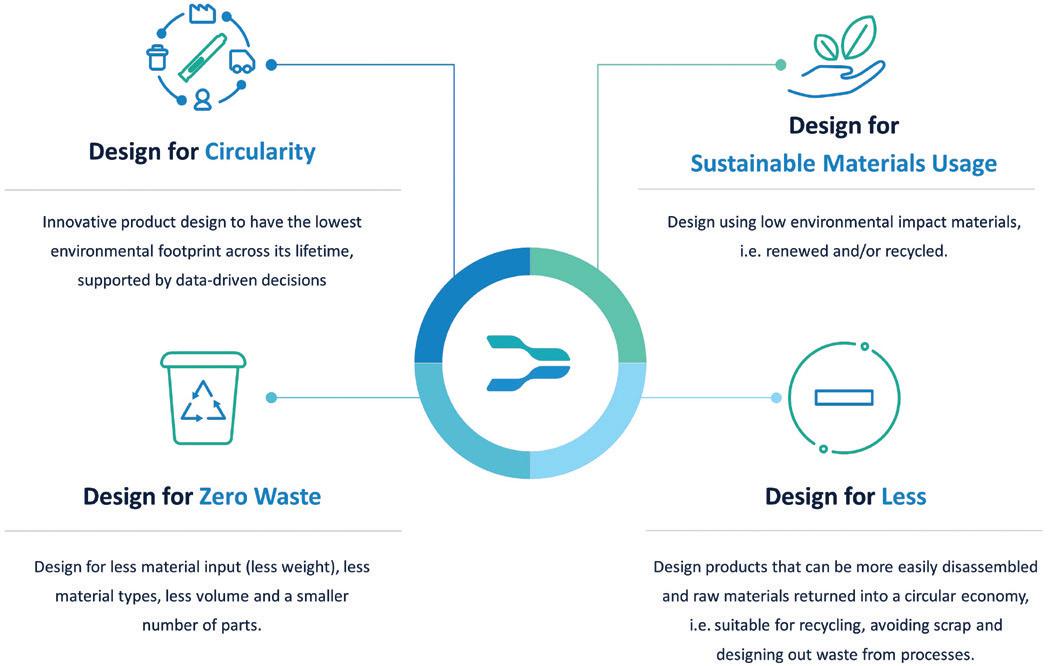
business models in the medtech and pharma industries. We put circularity at the core of what we do. This means designing and manufacturing our products so that they have the lowest possible environmental footprint across the lifecycle.
At SHL Medical, sustainability goes even beyond. As a world-leading solutions provider of self-injection solutions that reach the hands of patients across many therapy areas, sustainability has always been part of our mission. We could not have a better societal mission than enabling patients’ independence through our self injection devices.
We fully understand our responsibility to constantly deliver our products while always ensuring responsible business practices. We are conscious of our responsibility to our employees, our suppliers, our local communities and our stakeholders. Therefore, we have committed to several sustainability goals that we’re
striving to meet by 2030, including a commitment to reducing accidents across our locations, fostering a diverse, inclusive and equitable workplace, and assessing and supporting our suppliers to match our environmental, social and governance ambitions.
Most importantly, we understand the potential we have to create a lasting impact on society and are therefore focused on uninterruptedly delivering devices to more and more patients who need selfinjection therapies. We are committed to supporting our pharma partners and the healthcare industry to reach more than 8 million patients through our self-injection solutions.
SHL Medical is a solutions provider in the design, development and manufacturing of advanced drug delivery devices,
“Most importantly, we understand the potential we have to create a lasting impact on society and are therefore focused on uninterruptedly delivering devices to more and more patients who need self-injection therapies.”
such as autoinjectors and pen injectors. The company also provides final assembly, labelling and packaging services for leading pharmaceutical and biotech companies across the globe. With locations in Switzerland, Taiwan, Sweden and the US, SHL Medical has successfully built a strong international team of experts that develops breakthrough drug delivery solutions for pharma and biotech customers. These include advanced reusable and disposable injection systems that can accommodate large-volume and highviscosity formulations – and connected device technologies for next-generation healthcare.

Dora Rio Head of Sustainability E: dora.rio@shl-medical.com
SHL Medical AG Gubelstrasse 22 6302 Zug Switzerland
www.shl-medical.com








In this article, Gigi Bat-Edene, Global Program Manager at PCI Pharma Services, discusses the steps that PCI has taken towards realising its environmental, social and governance targets and achieving reductions in its greenhouse gas emissions in the journey towards net zero.
Historically, the pharma industry has not been a leader in Environmental Social Governance (ESG). Despite pharma’s significant progress in decreasing global greenhouse gas emissions compared with other industries, it is still lagging behind immensely. However, due to the recent focus on sustainability, environmental regulations and social justice, it is expected that more pharma companies will step up and integrate ESG into their shortand long-term strategies. The truth is that ESG-related challenges will not be overcome overnight; it is a continuous journey with no end point. To achieve meaningful progress and tangible results, ESG must be woven into the very fabric of a business.
For companies in the early stages of developing their own sustainability programs, this can seem like a daunting task but,
“Positive change is certainly achievable. Pharma companies need to become stewards of positive change in the industry by monitoring their direct and indirect impacts on the environment and their surrounding communities.”
by taking small steps and establishing the right frameworks, making positive change is certainly achievable. Pharma companies need to become stewards of positive change in the industry by monitoring their direct and indirect impacts on the environment and their surrounding communities, mitigating hazardous risks and identifying opportunities for continuous improvement. Setting goals and aligning high-impact action plans will help drive success in these areas.
From both an environmental and social standpoint, companies must first identify their main impacts related to its activities. PCI has shared its ESG journey in detail in its inaugural ESG Report FY23, which was published in March 2024. This article focuses on PCI’s process for conducting materiality assessment and using the insights gained to develop science-based targets.
A double materiality assessment is a twophased approach used to gauge what internal and external stakeholders identify as material issues relevant to the company. Going beyond a focus on the financial, it considers ESG factors that can impact both the organisation and its stakeholders. This is a highly recommended first step on a company’s ESG journey.
In 2022, PCI conducted the first phase of its materiality assessment. The company engaged employees, leaders and investors,

Gigi Bat-Erdene
Global ESG Program Manager E: gigi.bat-erdene@pci.com
PCI Pharma Services
3001 Red Lion Road Philadelphia PA 19114
United States www.pci.com

interviewing them – both in one-on-one and group settings – and collecting their input on the topics that are most important to them and where they felt PCI should be prioritising its efforts. Based on the expected impact on stakeholders, strategic business value and the Sustainability Account Standards Board standards, PCI identified its nine impact categories and 20 initial quantitative indicators.
The following year, PCI carried out the second phase. The company surveyed more than 600 external stakeholders, including customers, suppliers, investors and local community partners, asking them to rank sustainability issues in order of importance. Given PCI’s emphasis on local impact, it was critical to include the voices of community members and partner organisations in the company’s ESG programme.
This two-phased approach enabled the company to gain a comprehensive understanding of stakeholder priorities and concerns, informing PCI’s long-term business strategy. These insights are being used as a fundamental building block to determine which metrics to track, what to disclose and where to focus meaningful performance improvements in the future (Figure 1).
PCI has aligned its environmental targets and action plans with the latest recommendations set forth by the Science Based Targets Initiative (SBTi). Sciencebased target setting enables an ambitious,
credible and clearly defined emissions reduction pathway for companies that are serious about preventing the worst impacts of climate change. In line with the latest climate science, PCI has committed to reducing its total greenhouse gas (GHG) emissions, using resources efficiently, investing in renewable energy and adopting new ways of conducting business (Figure 2).
PCI’s GHG emissions are a byproduct of:
• Scope 1 (direct emissions): On-site manufacturing activities, heating, cooling, refrigerants
• Scope 2 (indirect emissions): Purchased electricity
• Scope 3 (supply chain emissions): Upstream and downstream activities,
such as business travel, employee commuting, transportation and distribution of products.
Globally, PCI has established the following emission reduction targets for Scopes 1 and 2:
• 40% reduction in Scope 1 and 2 GHG emissions intensity (normalised to revenue) by 2030. As part of this commitment, PCI has signed a letter with the SBTi and will submit targets for verification before 2025
• 50% reduction in energy intensity by 2030 (normalised to revenue)
• 100% renewable energy purchased by 2030.

2: PCI’s 2022–2023 financial year reporting period included several new sites, accounting for the increase in total energy consumption from the 2022–2023 to the 2023–2024 financial years. During the same time period, PCI’s energy consumption intensity has declined, reflecting an overall reduction in its energy consumption intensity despite the addition of new business sites.
Globally, PCI is working towards the following emission reduction target for Scope 3:
• A net-zero Scope 3 value chain by 2045.
Assessing company-related carbon footprint and energy usage, and establishing formal targets based on them, is a crucial first step. However, tangible efforts to actually limit global warming to below 1.5°C above pre-industrial levels by 2030 require companies to go beyond their four walls and focus on the wider value chain. After all, Scope 3 emissions often account for the vast majority of a company’s carbon footprint. This is why PCI regards its supply chain to be an essential area to focus on and its suppliers as key partners in the race to a net-zero future.
To define actions that will achieve the company’s Scope 1 & 2 reduction targets, PCI collected ideas from employees, researched industry best practices and identified the following high-impact action plans:
• Creating and updating policies to require that new purchases and processes consider environmental impacts in line with targets
• Changing all facility lighting to use light-emitting diodes (LEDs)
• Implementing leak detectors for energy-intensive systems, including compressed air
• Implementing a refrigerant-use tracking and reporting system, along with a “traffic light” system to switch off equipment not in use.
As PCI continues to increase the granularity of its Scope 3 baseline and prepares to submit its targets for SBTi
“Internally, companies should assemble a multidisciplinary team specifically dedicated to ESG and conduct a materiality assessment to identify stakeholder priorities and align their short- and long-term goals accordingly.”
validation, the company is taking the following strides:
• Identifying relevant Scope 3 categories using publicly available data, along with internal spend-based data, to capture Scope 3 measurements, and is in the process of selecting credible partners for data accuracy and progress towards a net-zero strategy
• Updating company policies and procedures to reflect ESG commitments and outline expectations to reach the company’s targets
• Assessing ESG and carbon footprint maturity of the company’s top spend suppliers via ESG assessments and identifying opportunities for emission reductions, training and collaboration
• Prioritising suppliers that align with the company’s ESG vision, commit to science-based targets and comply with PCI’s responsible suppliers standards.
PCI has signed up to be part of the “Race to Zero” and the “Business Ambition for 1.5°C” campaigns – the world’s largest and fastest growing group of companies that are aligning with 1.5°C by helping to halve global emissions by 2030. In joining this call to action, PCI has been showcased by the SBTi, the UN Global Compact and the We Mean Business Coalition.
Every company around the globe is expected to reduce its carbon footprint
Gigi Bat-Erdene is Global ESG Program Manager at PCI. Ms Bat-Erdene is passionate about empowering individuals and businesses to play a bigger role in creating a more inclusive future for all. She joined PCI shortly after completing her undergraduate programme at Columbia University (NY, US) as a Sustainable Development major, and is now leading the buildout of PCI’s ESG programme, driving enhancements across impact and reporting strategy, including activities related to climate change; human rights; diversity, equity and inclusion; and sustainable procurement.
across its operations and entire supply chain. Pharmaceutical companies have the added challenges of a restrictive regulatory environment and a lack of cohesive ESG standards. However, it is possible to overcome these challenges.
Internally, companies should assemble a multidisciplinary team specifically dedicated to ESG and conduct a materiality assessment to identify stakeholder priorities and align their short- and long-term goals accordingly. From there, this team can partner with the leadership to develop an ESG strategy, after which the entire organisation will need to work together to implement the action plan with measurable outcomes.
Aligning to global frameworks like the SBTi, Race to Zero or We Mean Business Coalition can offer another level of credibility for companies that are serious about driving positive impact on the environment. PCI’s hope is that, by sharing ideas and working together as an industry, it is possible not only to change the narrative around pharma’s progress and commitment to ESG but cultivate a long-lasting positive impact.
PCI Pharma Services is a leading global CDMO, providing integrated end-to-end drug development, manufacturing and packaging solutions to increase product speed to market and opportunities for commercial success. PCI Pharma brings the proven experience that comes with more than 90 successful product launches each year and over five decades in the delivery of supply-chain healthcare services. With 30 sites across Australia, Canada, North America, the UK and Europe and over 5,200 dedicated employees, the company’s mission is to bring life-changing therapies to patients. Leading technology and continued investment enable PCI to deliver development to commercialisation solutions throughout the product lifecycle, collaborating with its clients to improve the lives of patients globally.
pci.com

talkfuture@pci.com
We want to share our aims, desires, and targets with you to show you how we purposefully impact the many local and global communities we care for and serve.
We embrace our responsibility with passion and humility. Values like accountability, flexibility, and excellence inspire us as we help our customers and the public at large.
Our ESG impact categories include:
• Carbon Footprint & Energy Efficiency
• Waste Management
• Water Conservation
• Labor & Human Rights
We are excited to announce that we have published our inaugural ESG Report. Your
• Health & Safety
• Diversity, Equity & Inclusion
• Community Impact
• Sustainable Procurement



